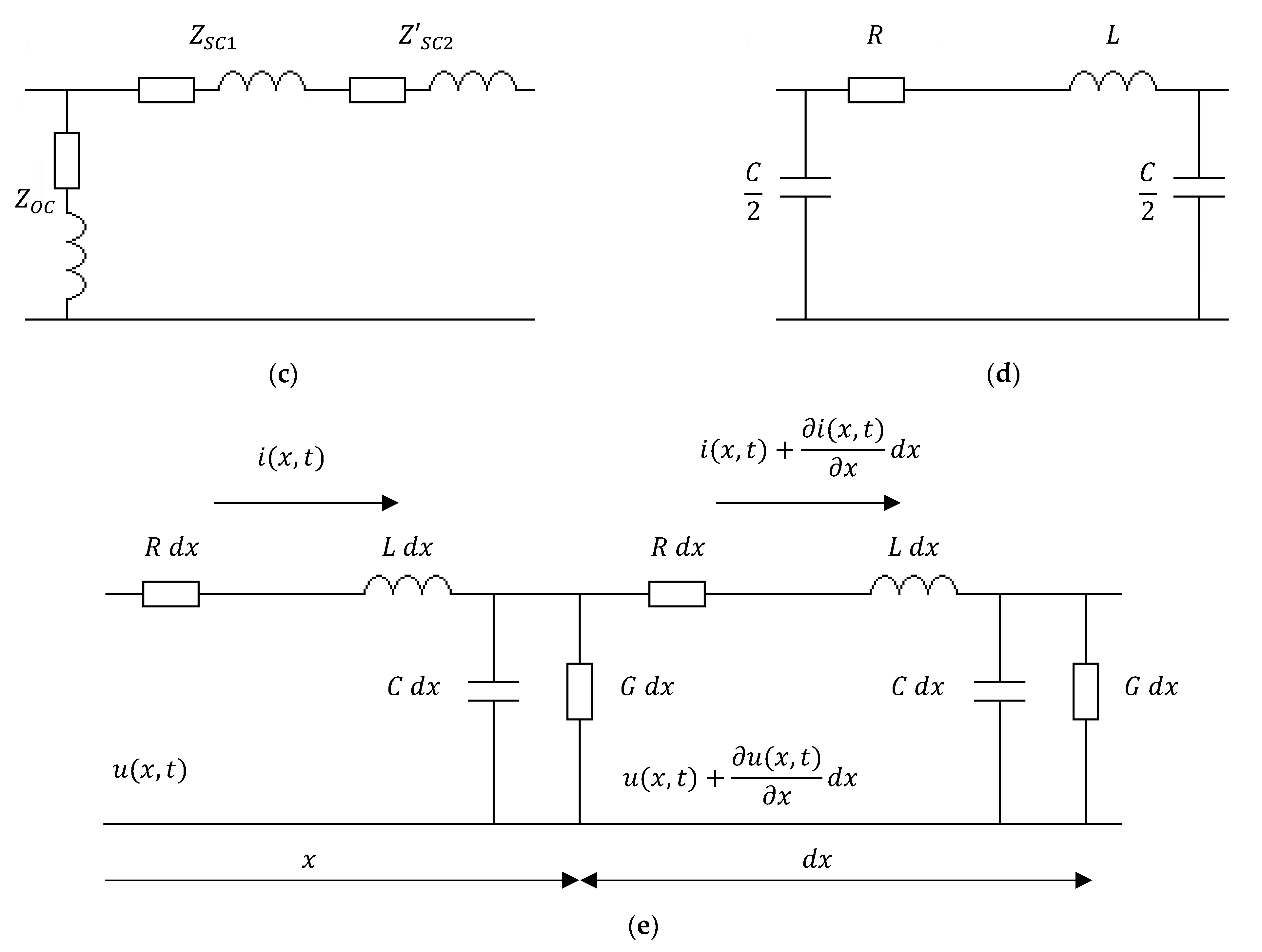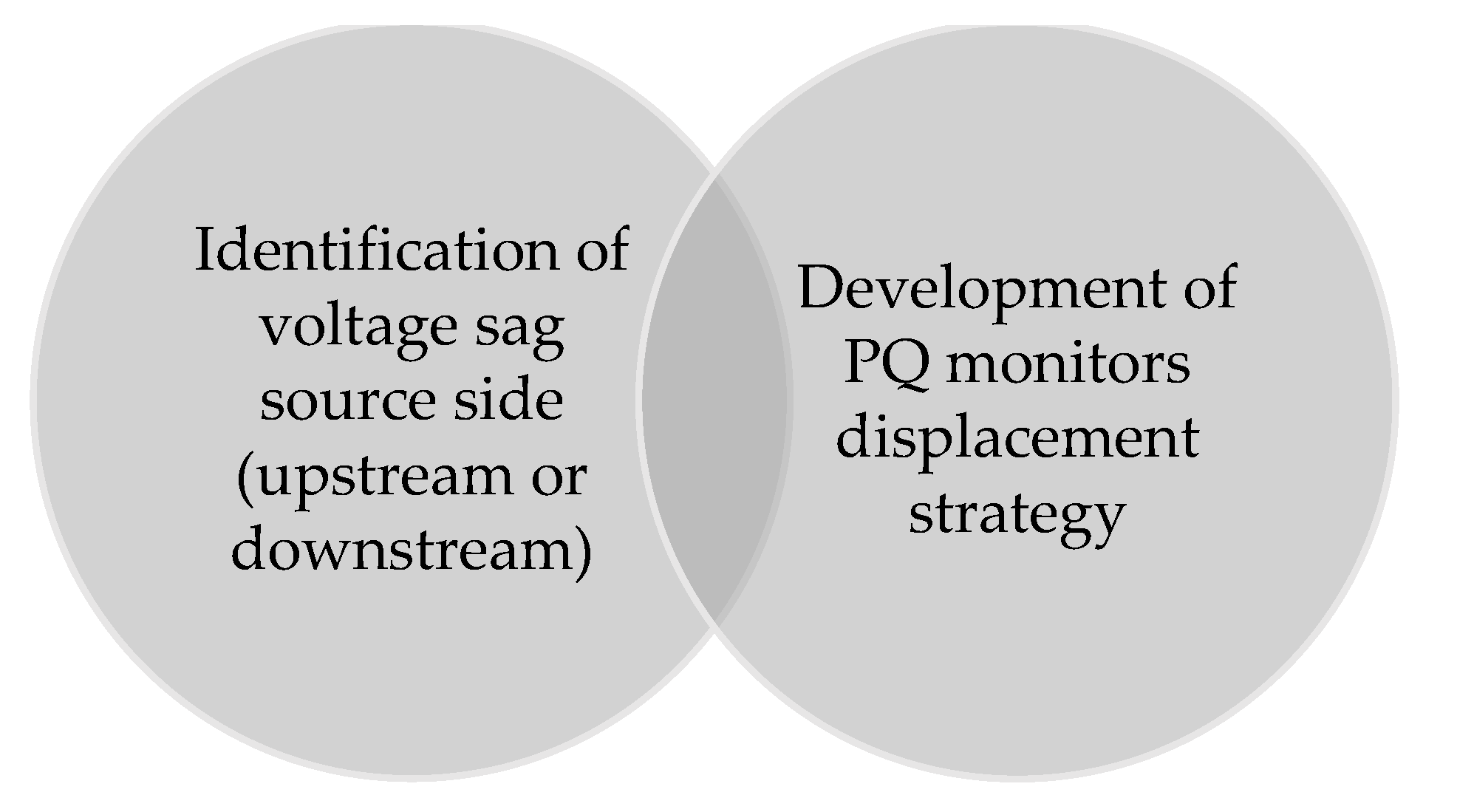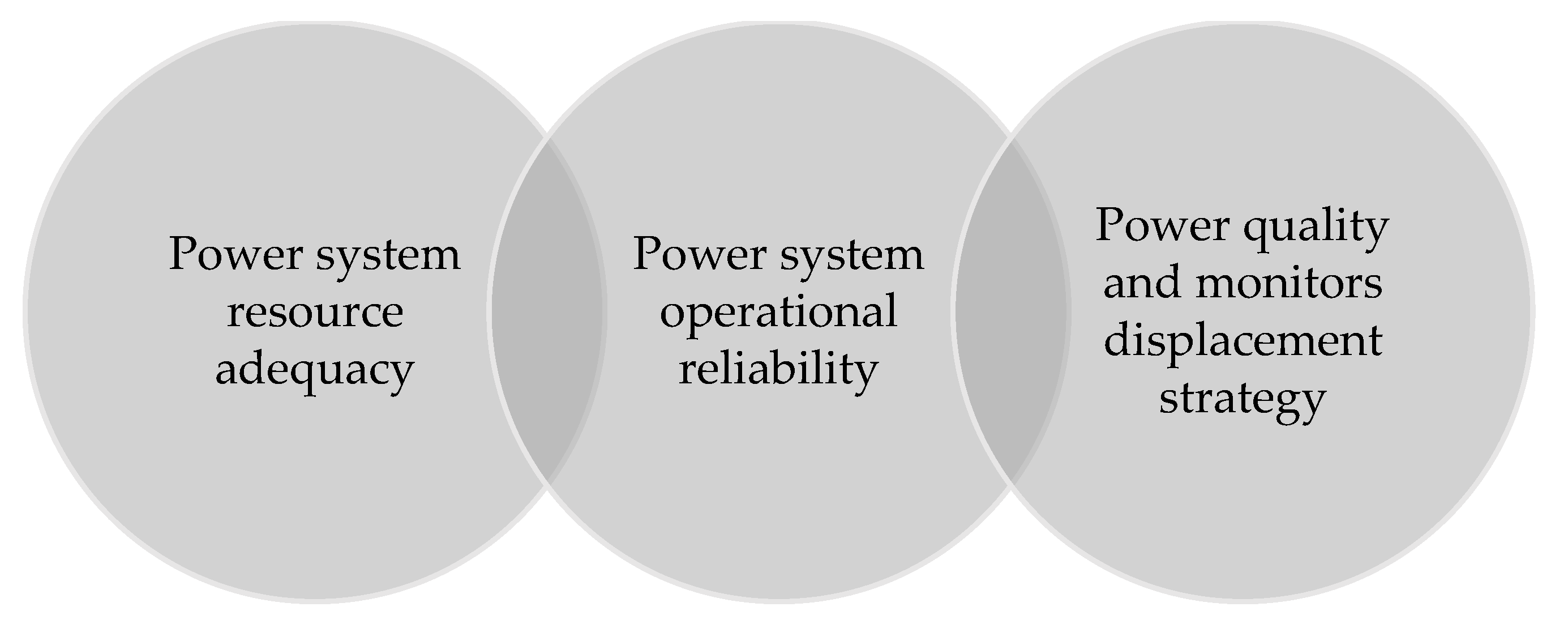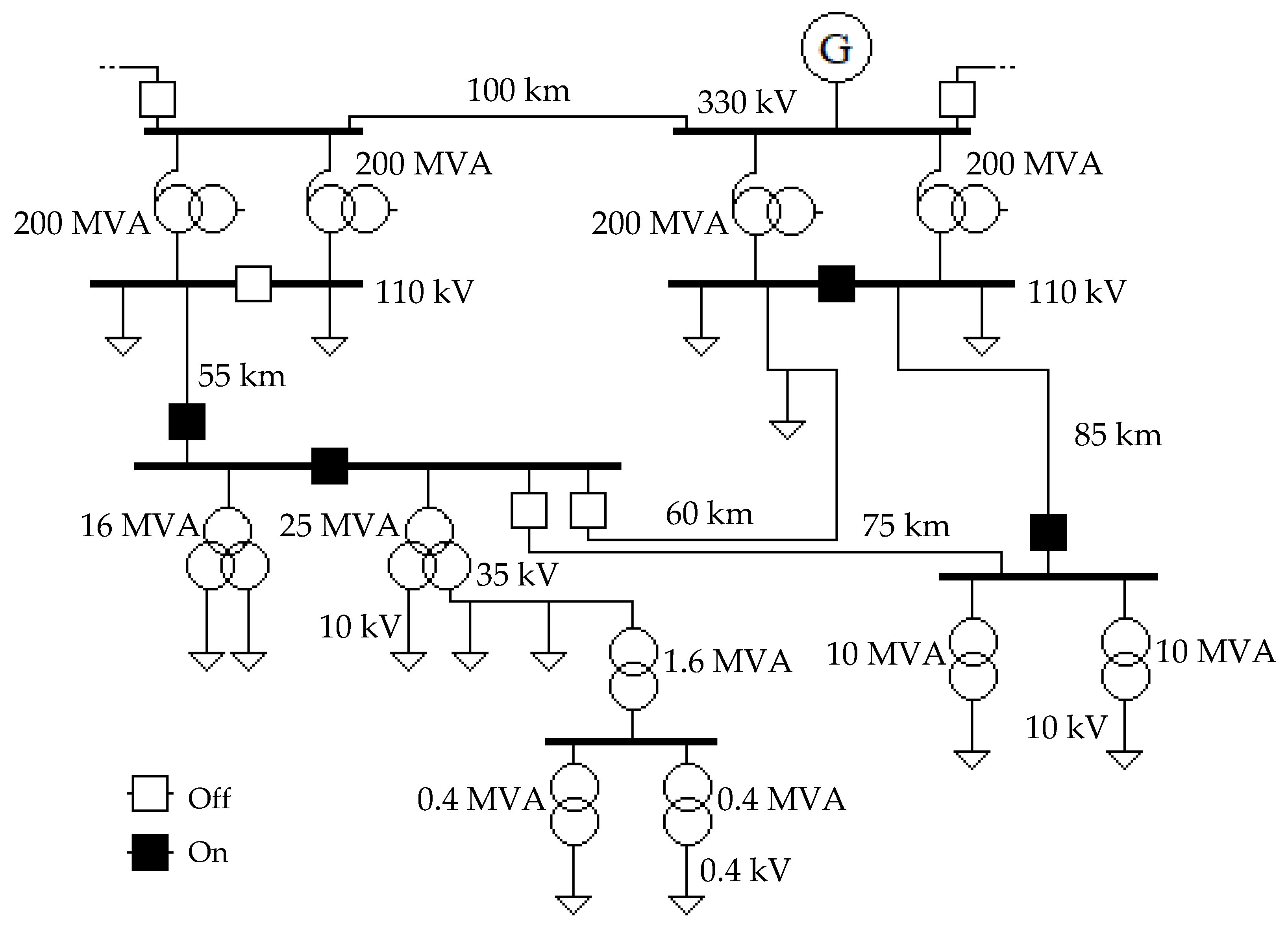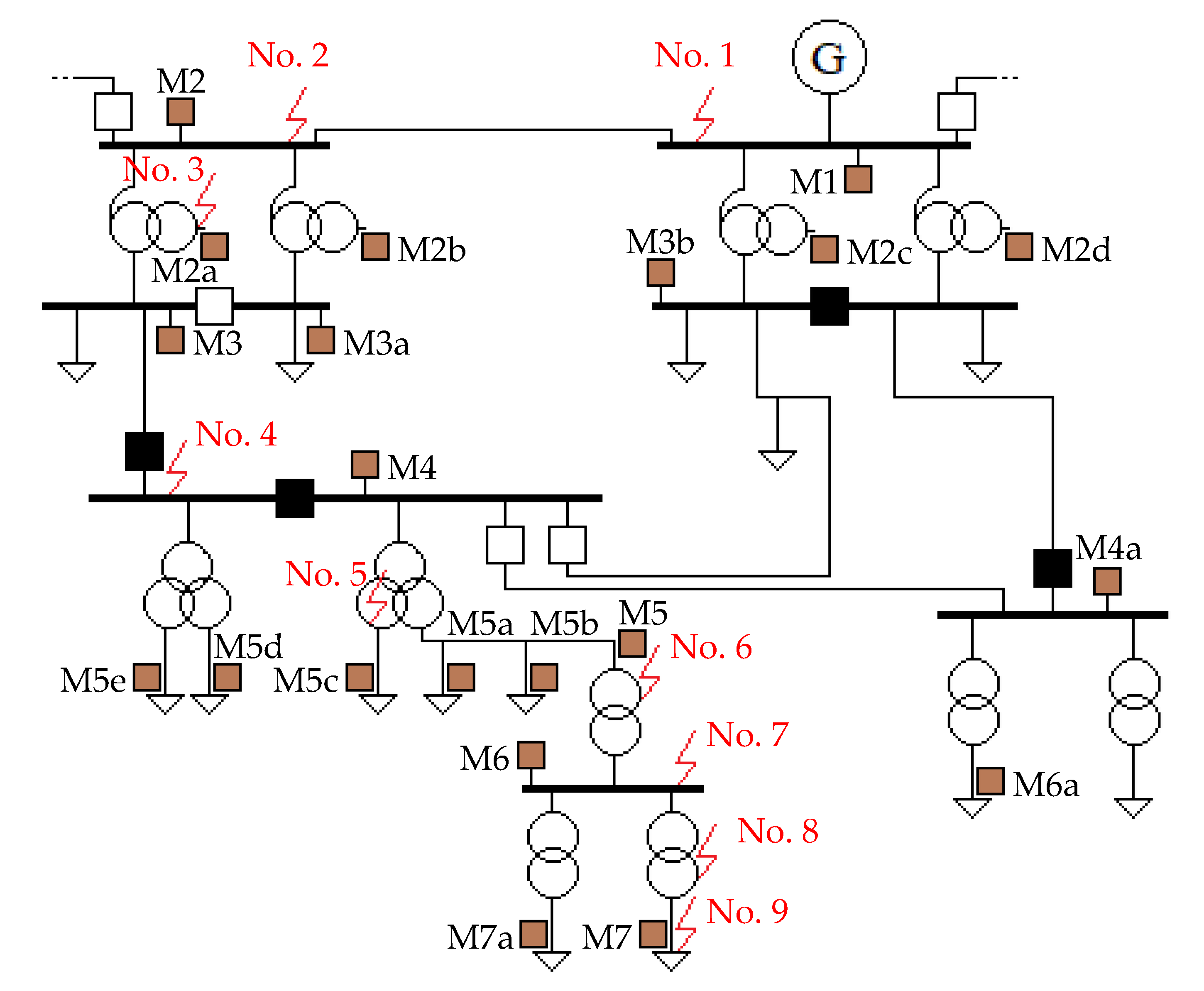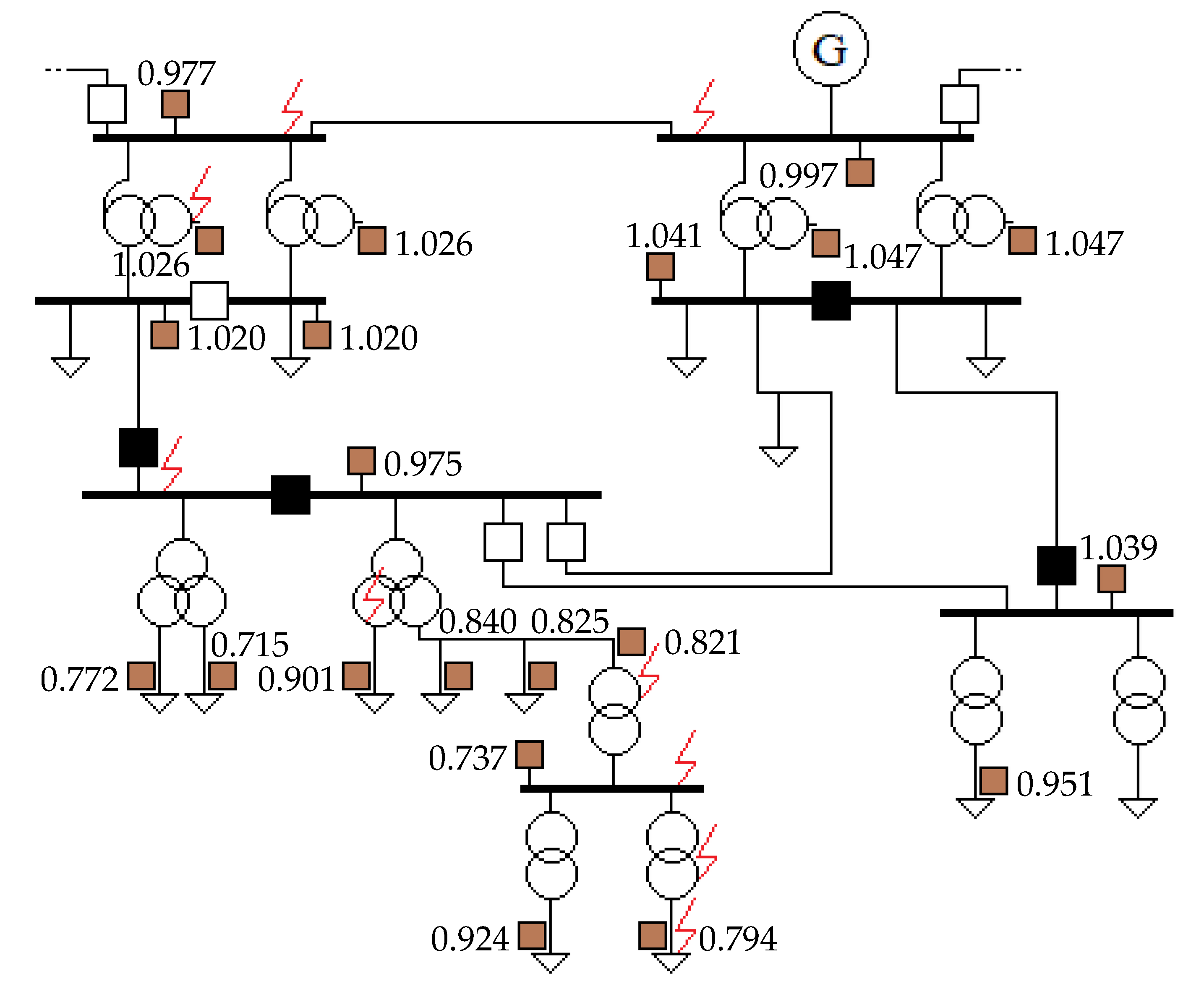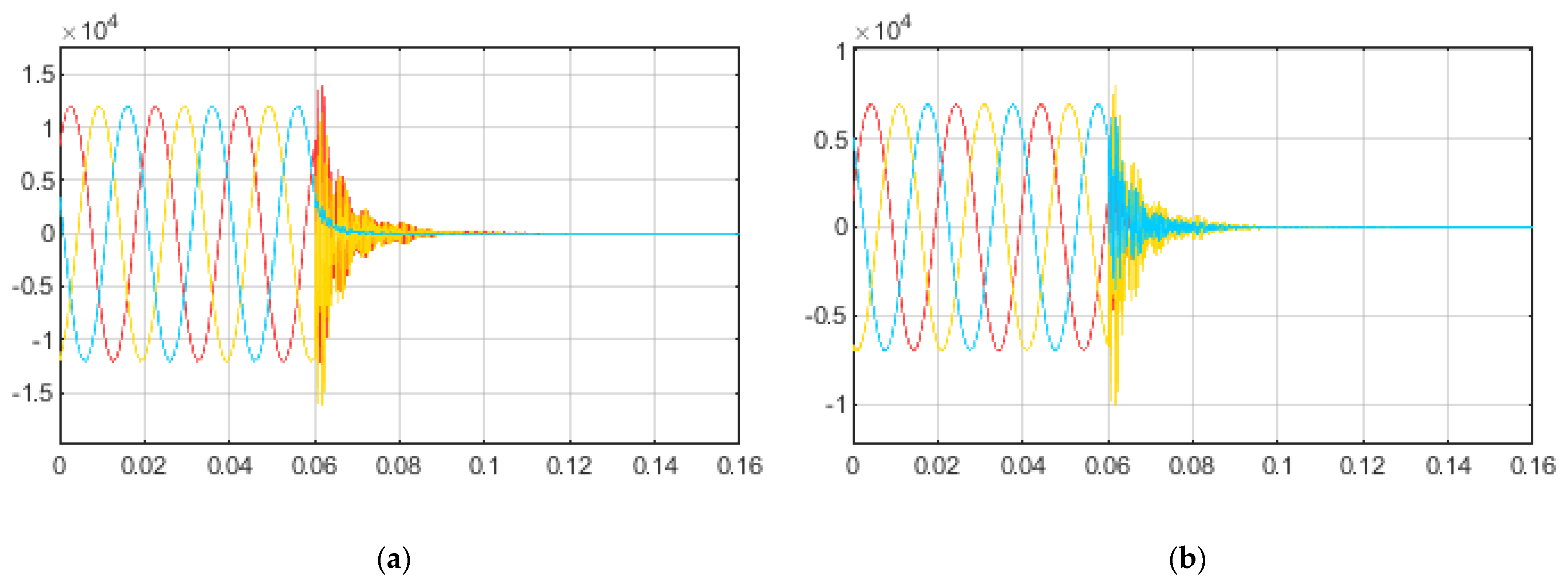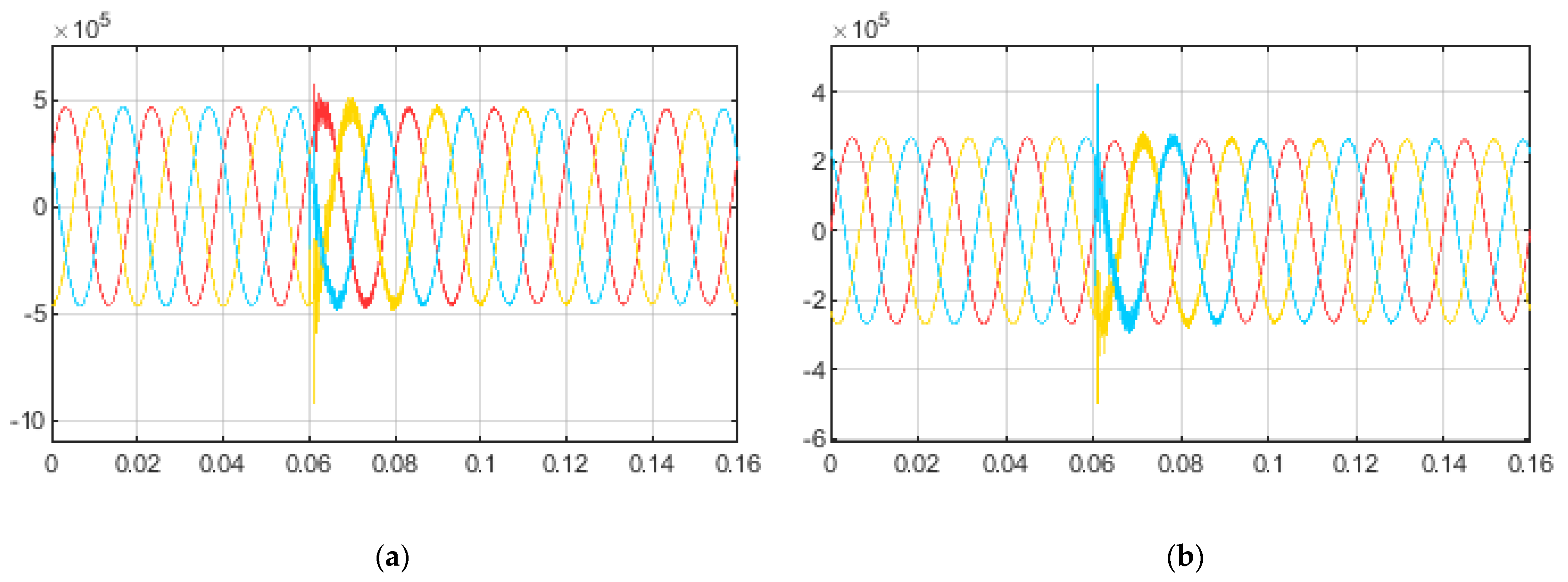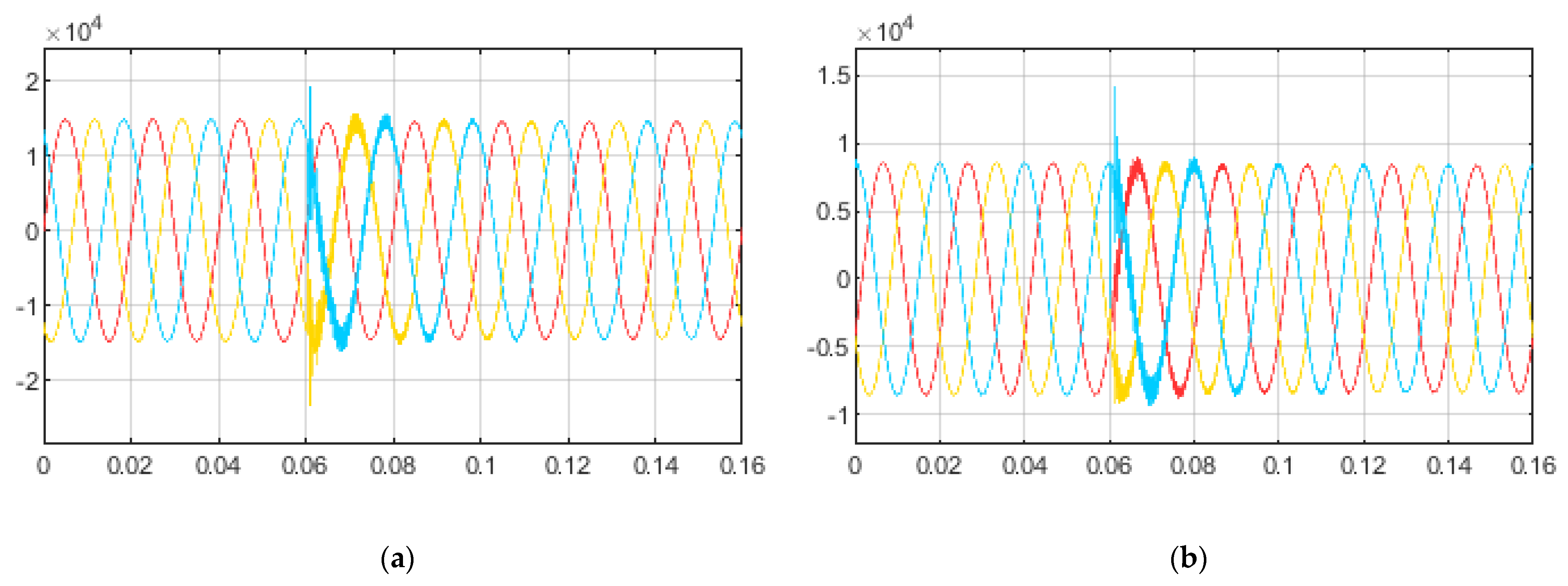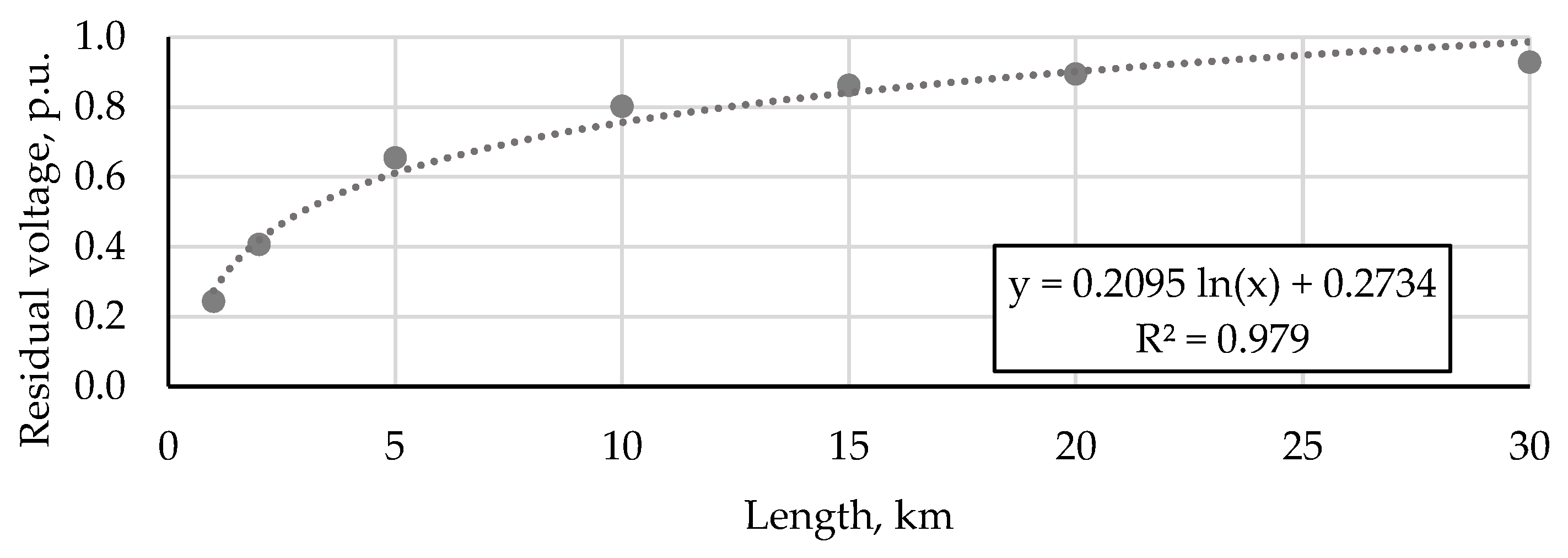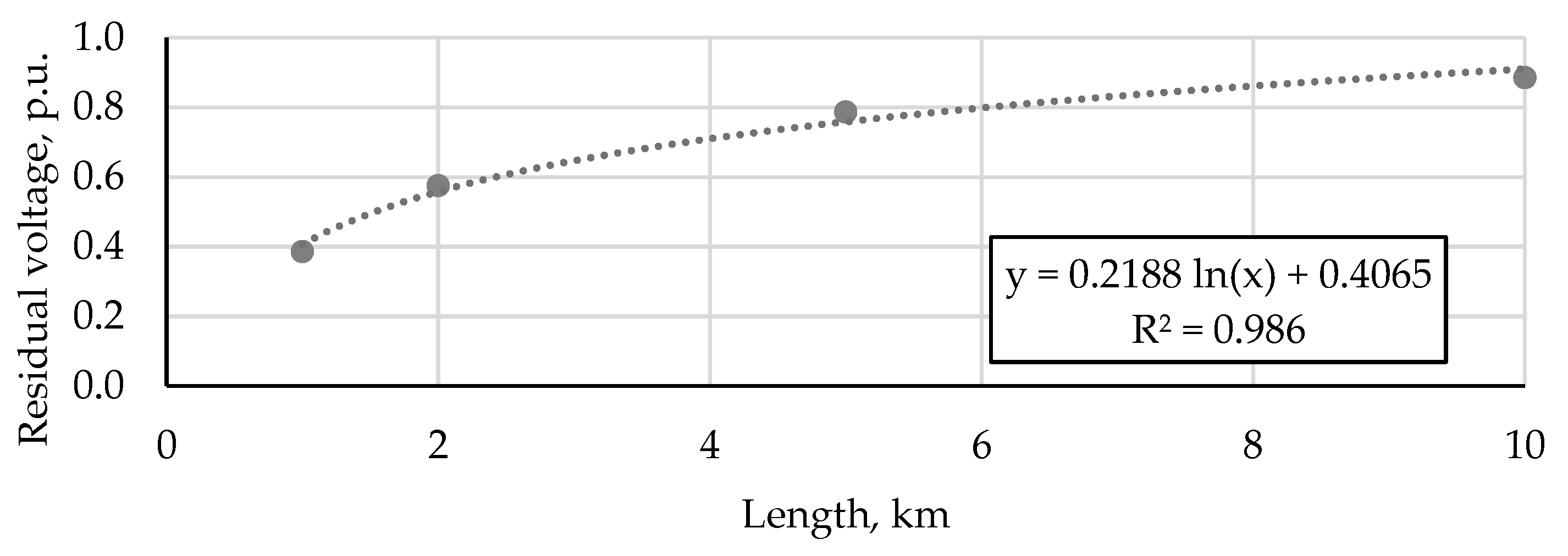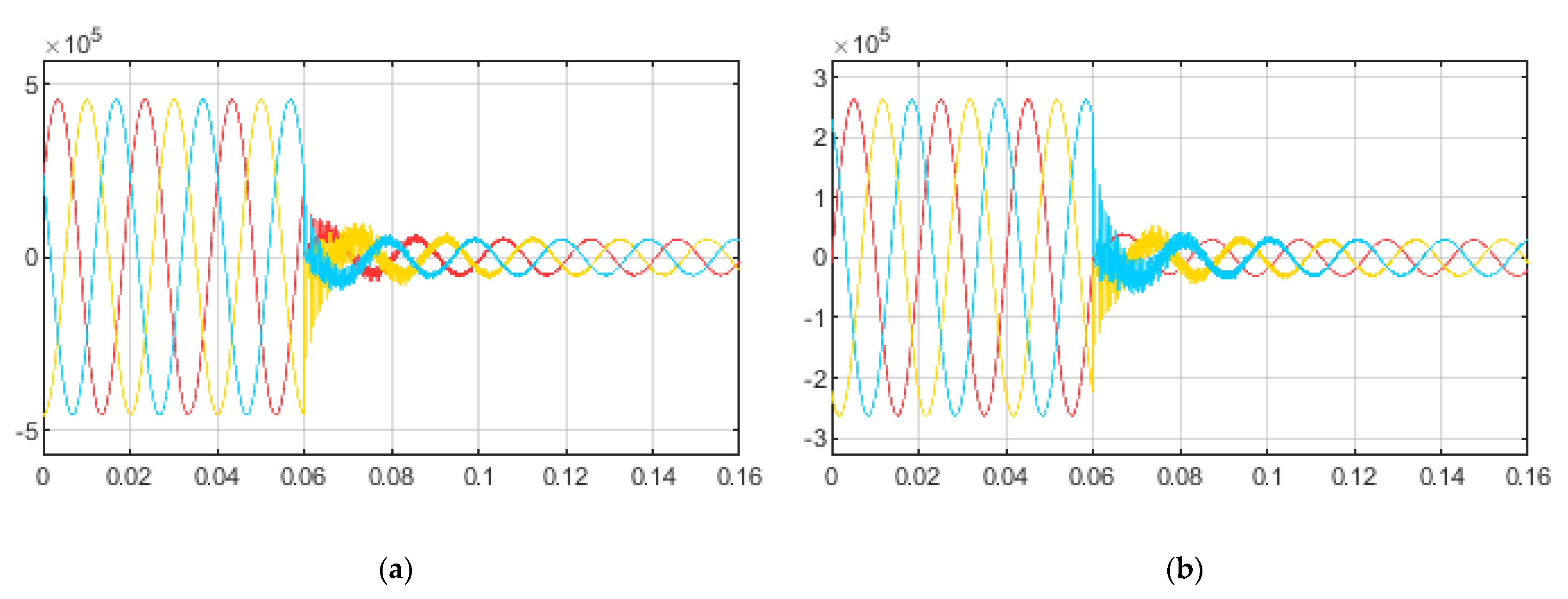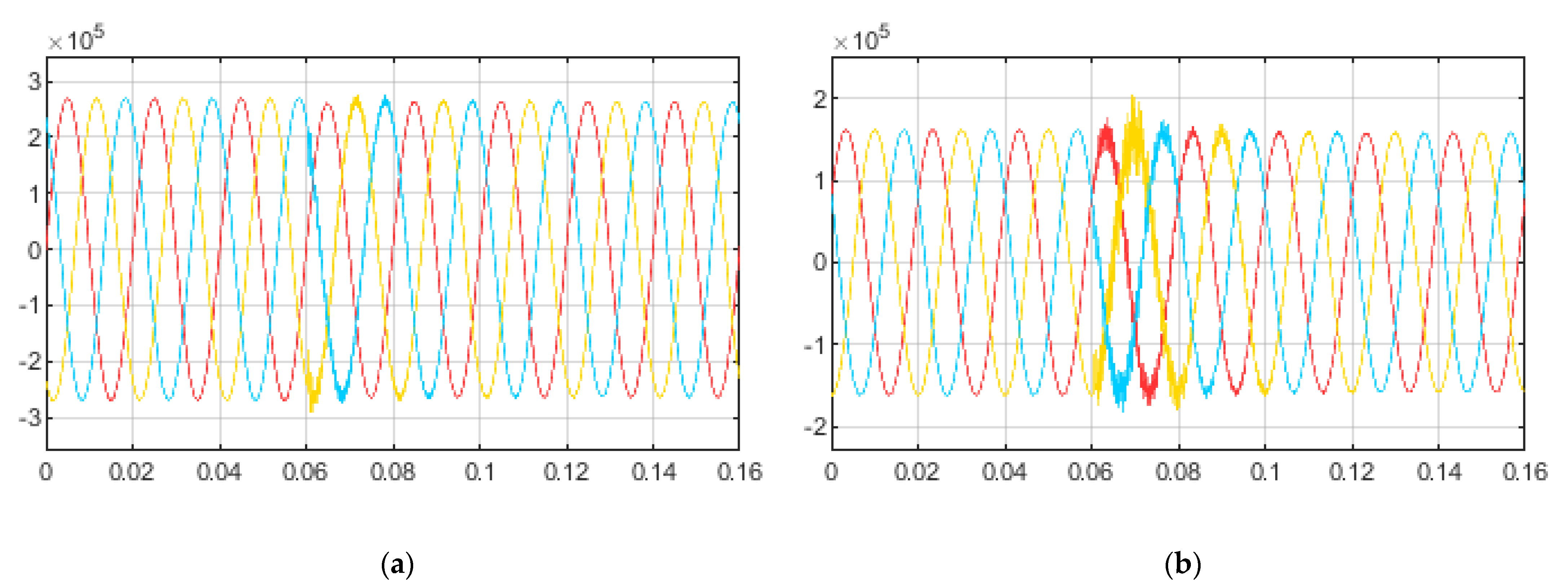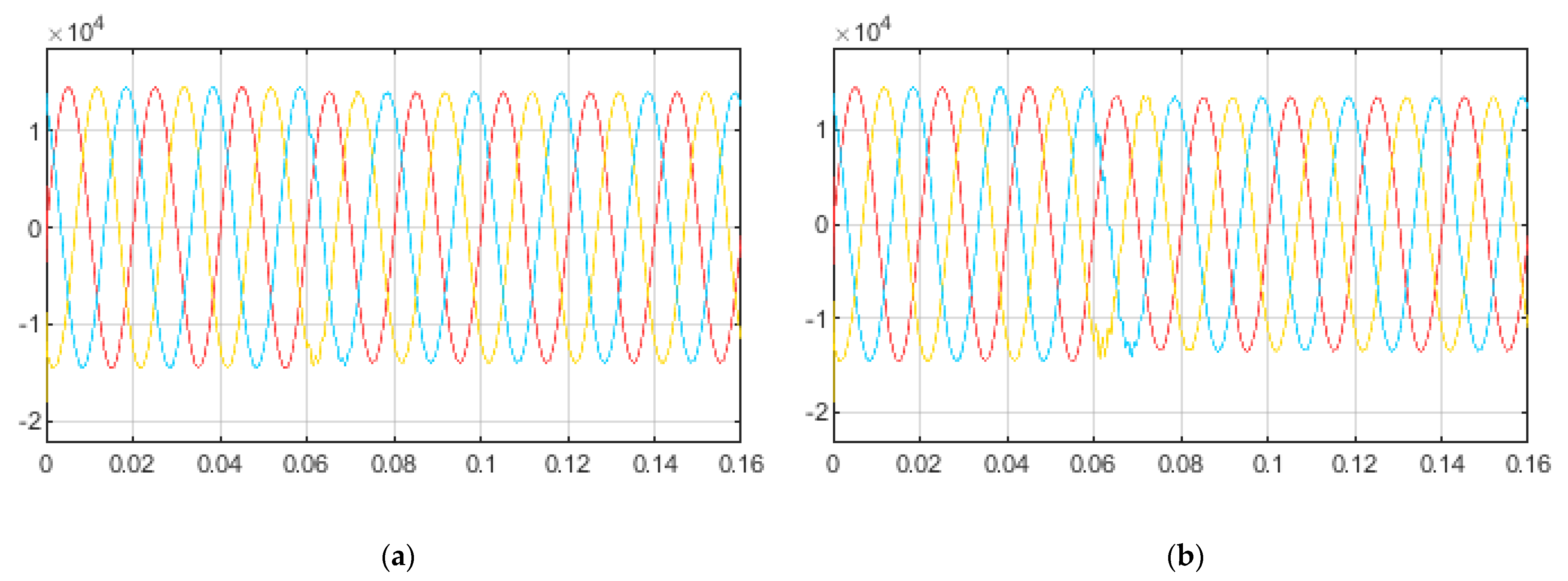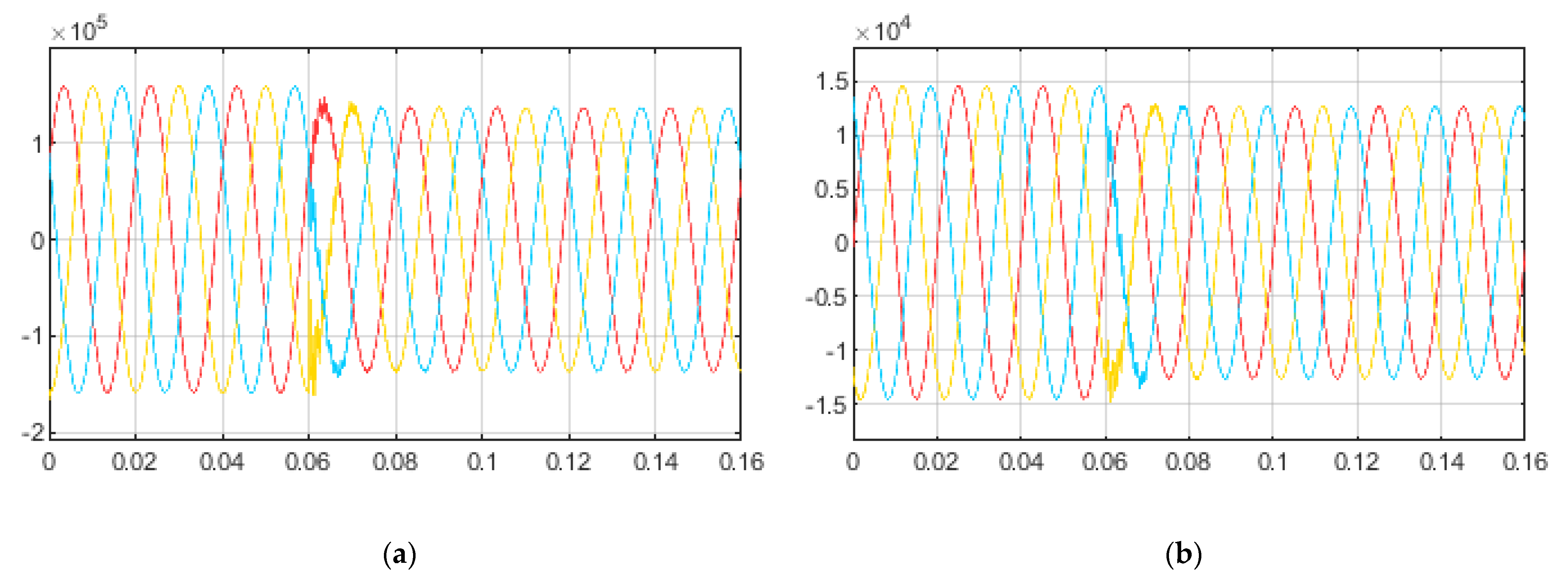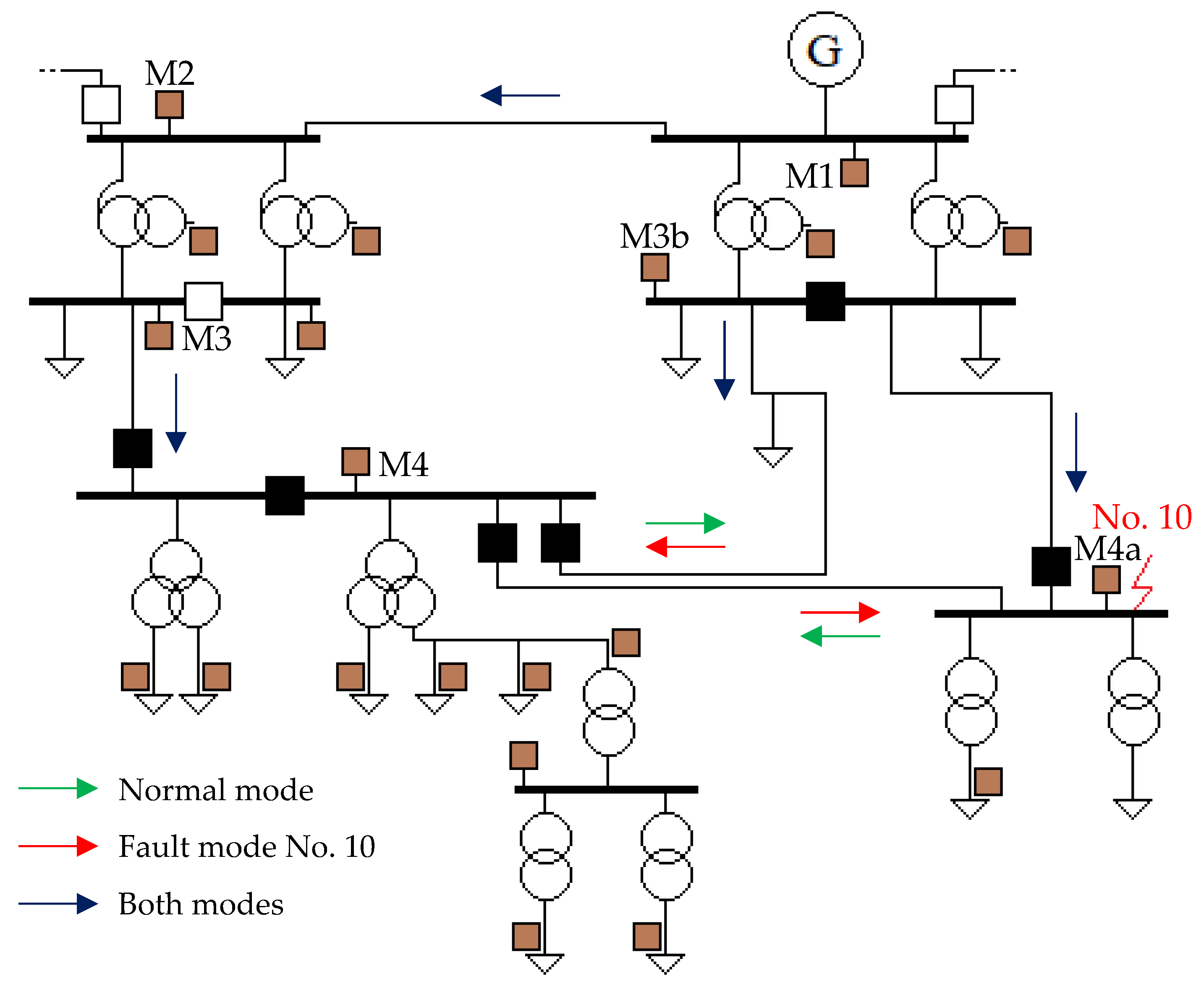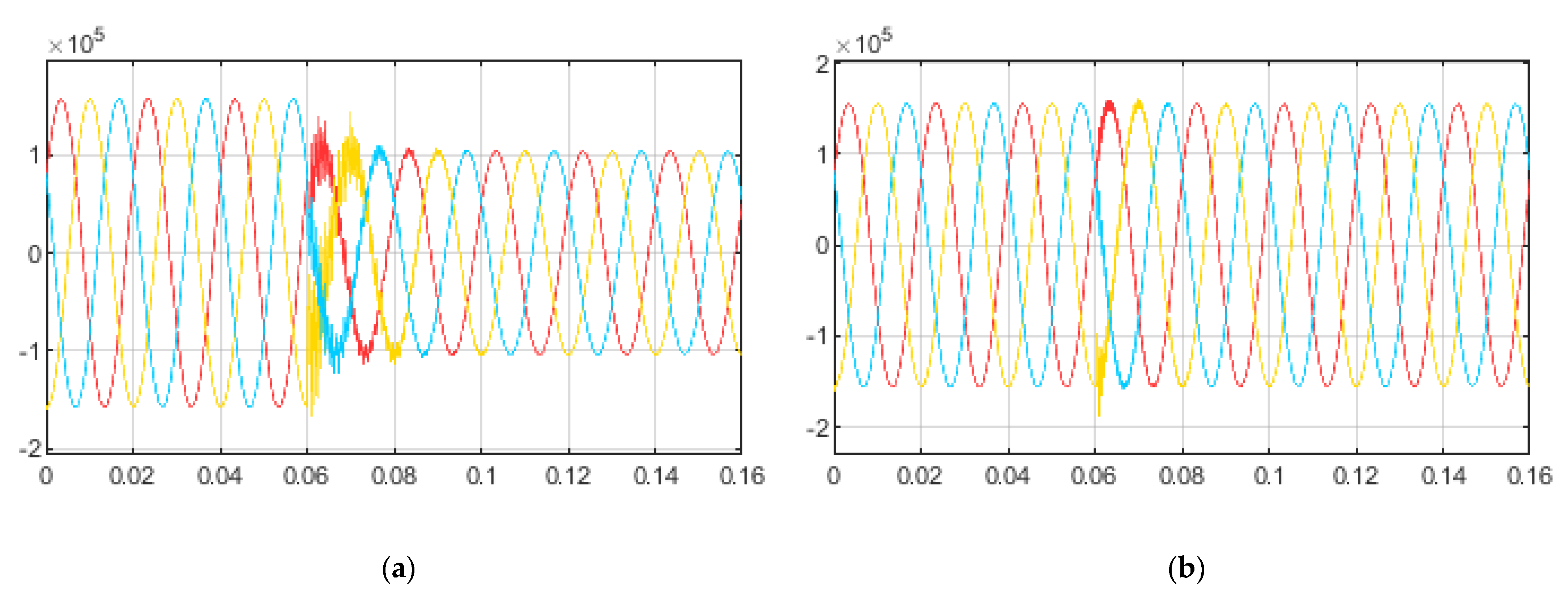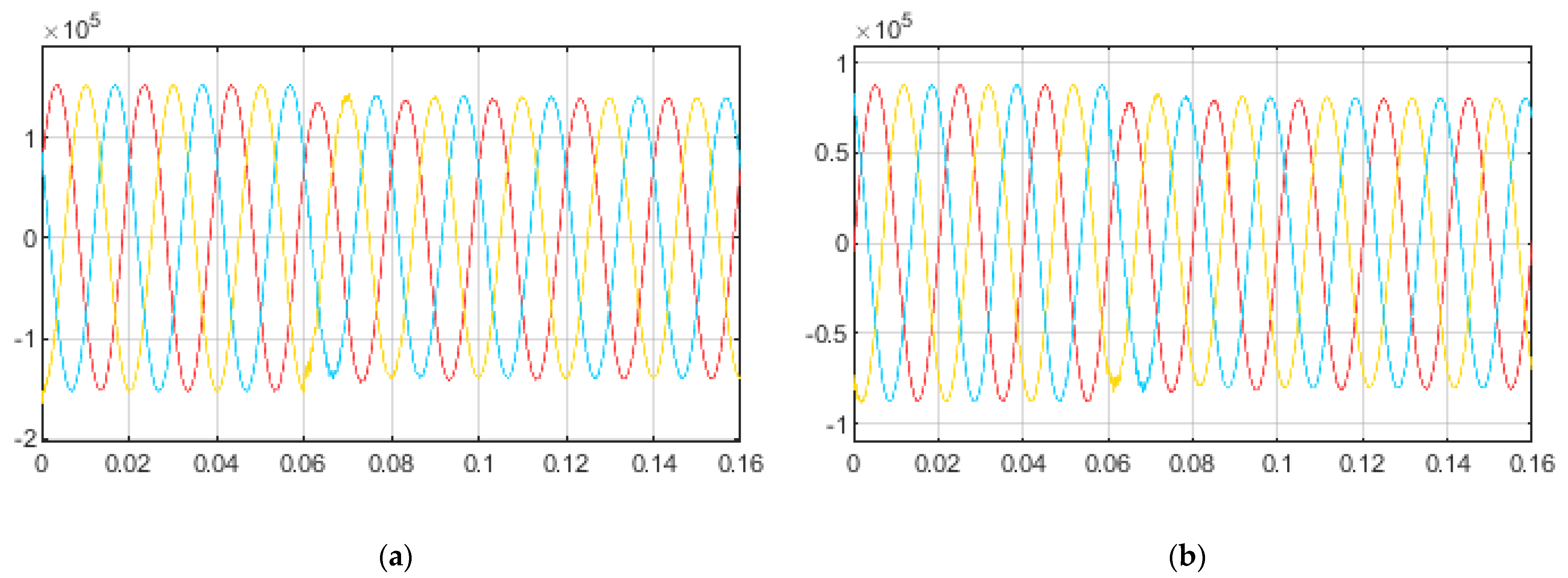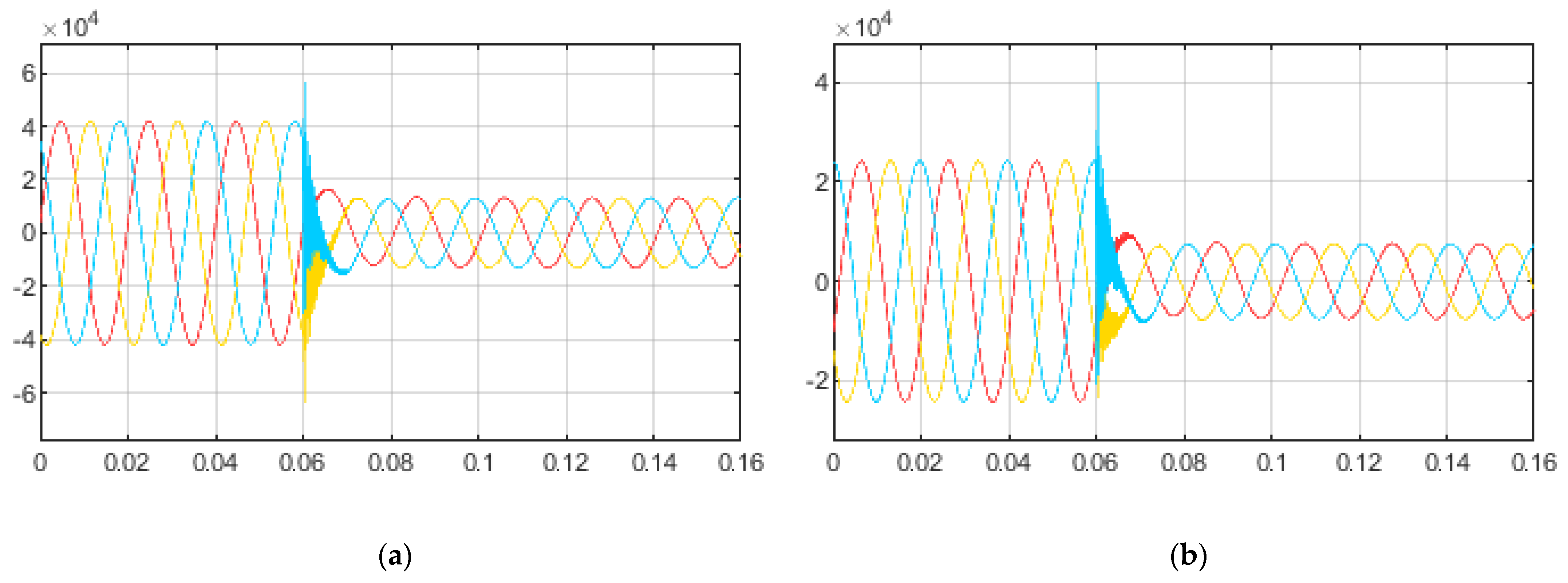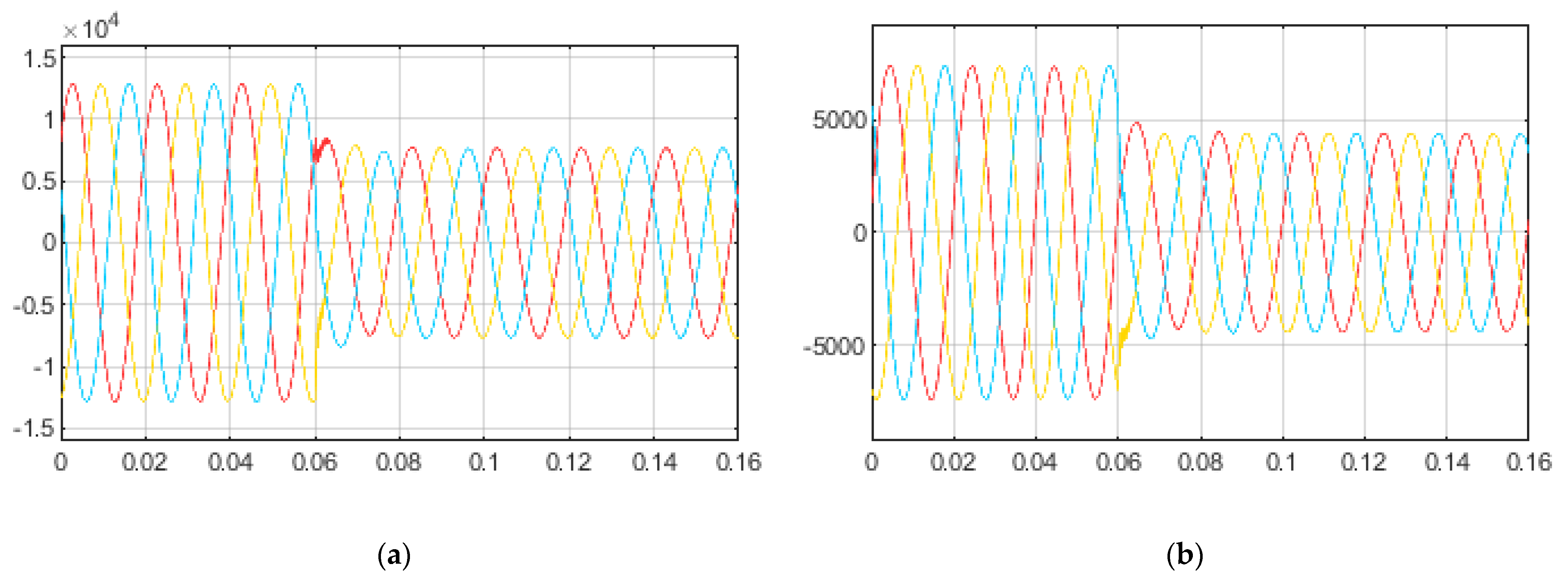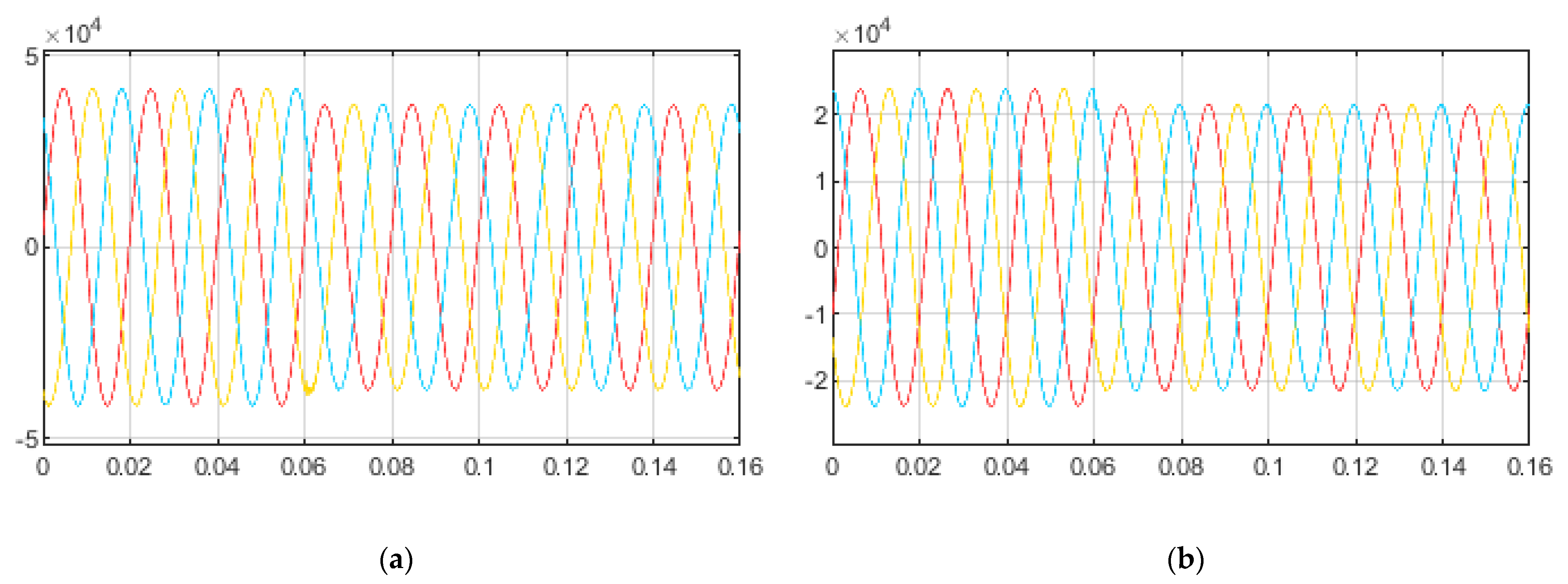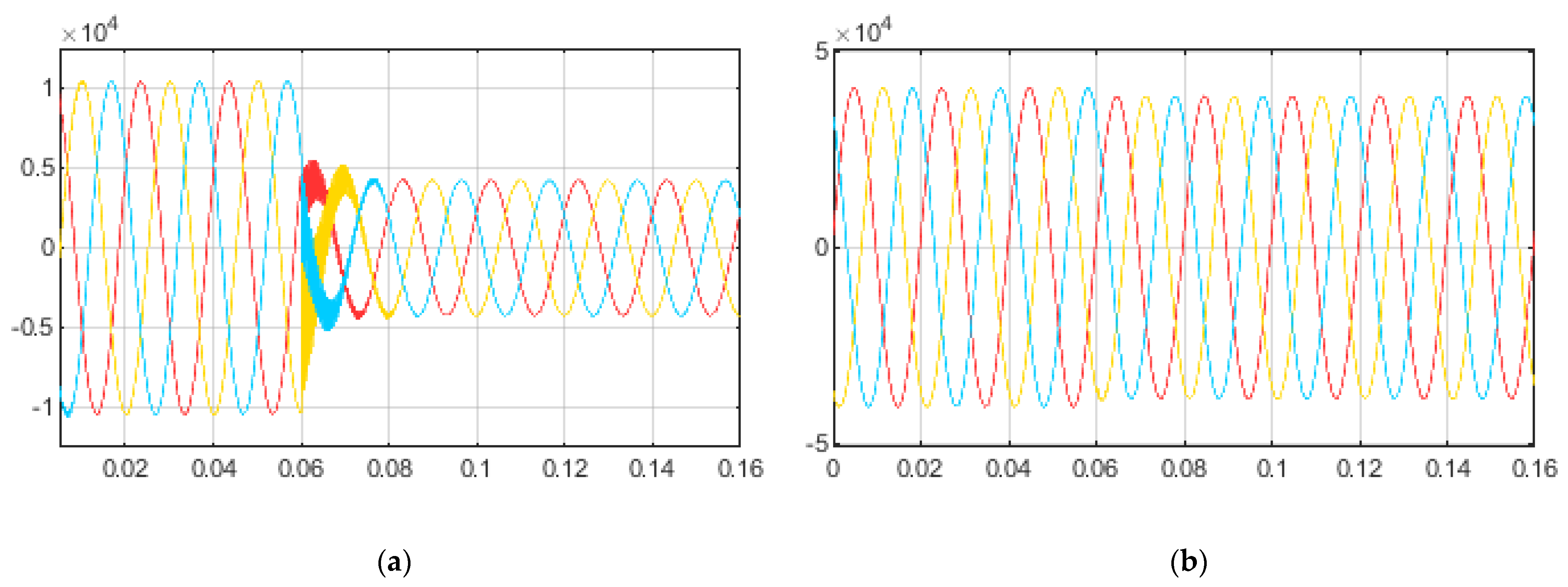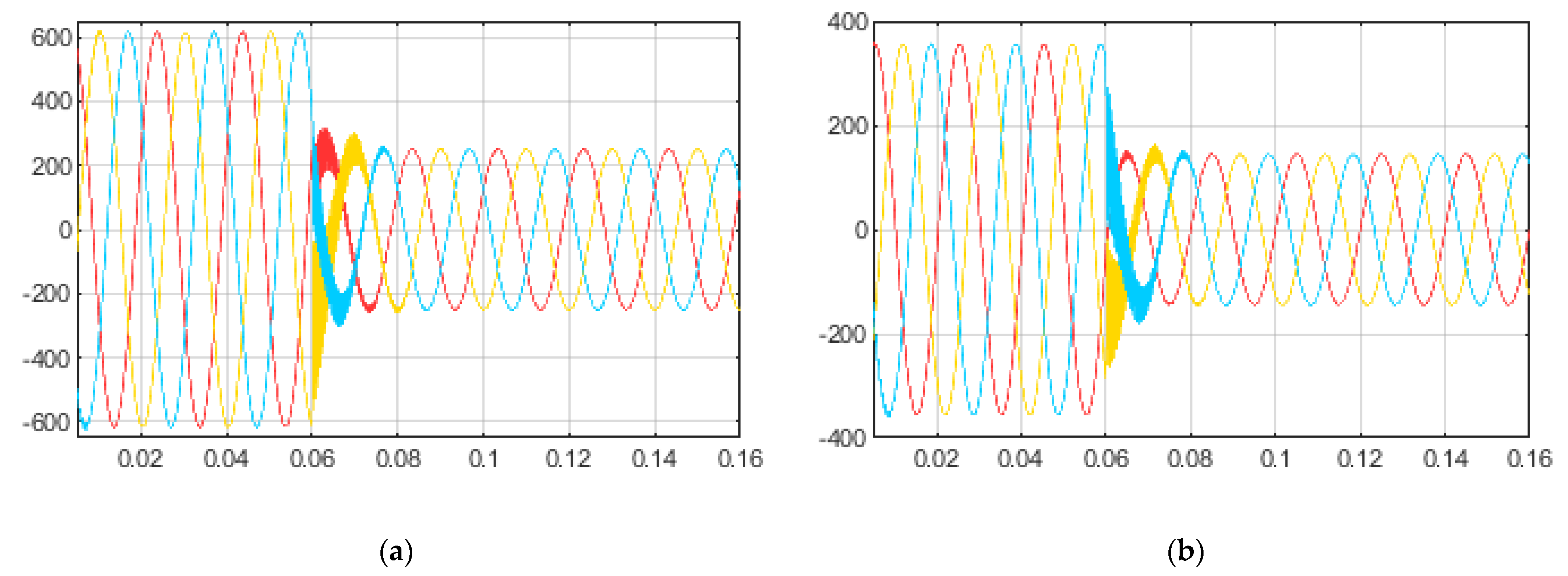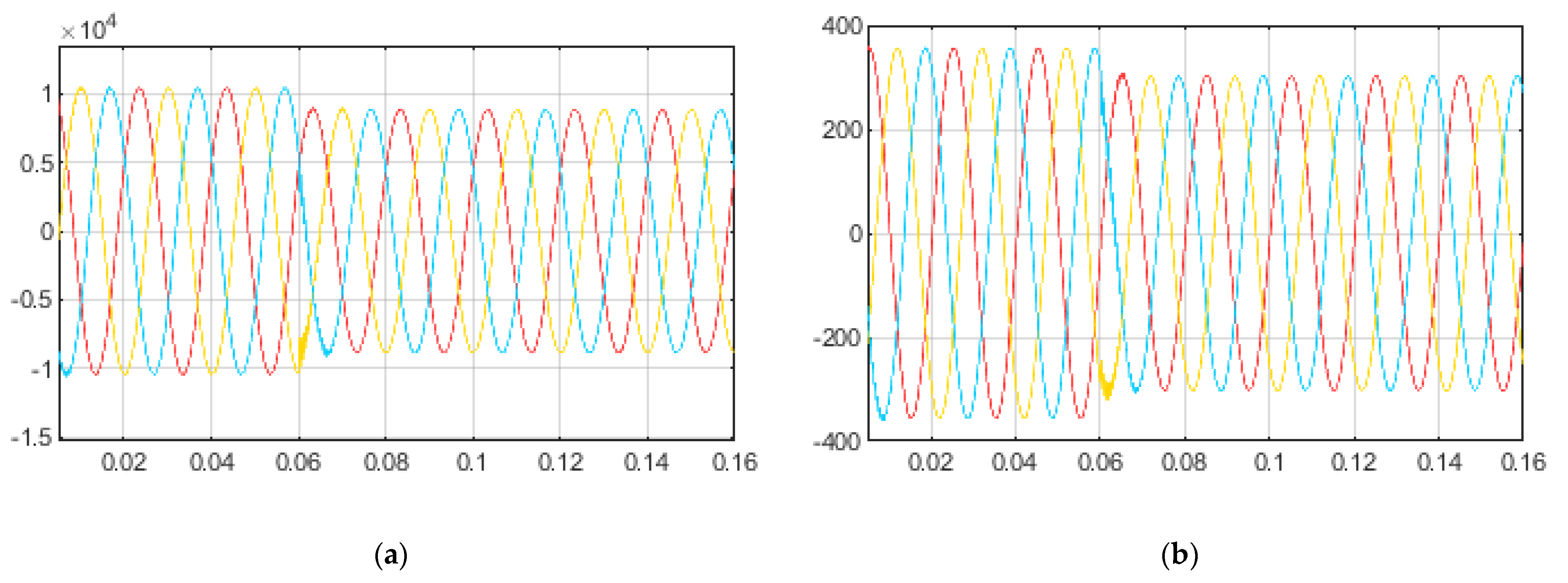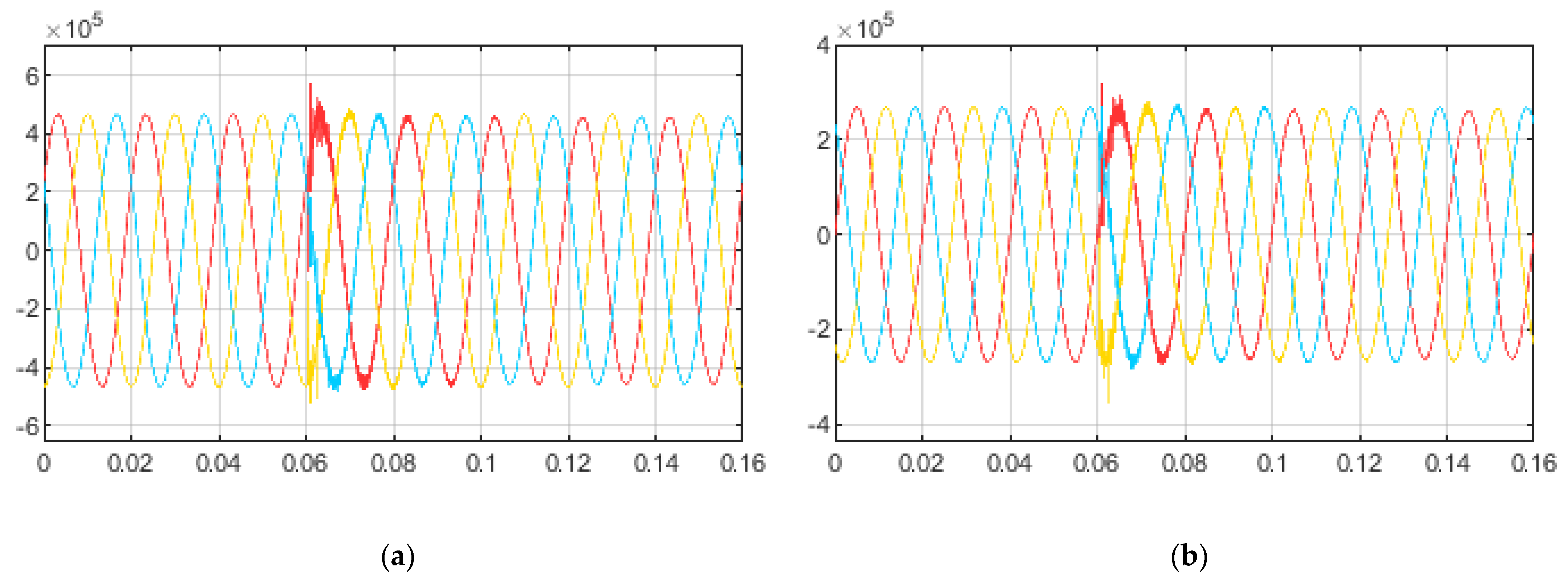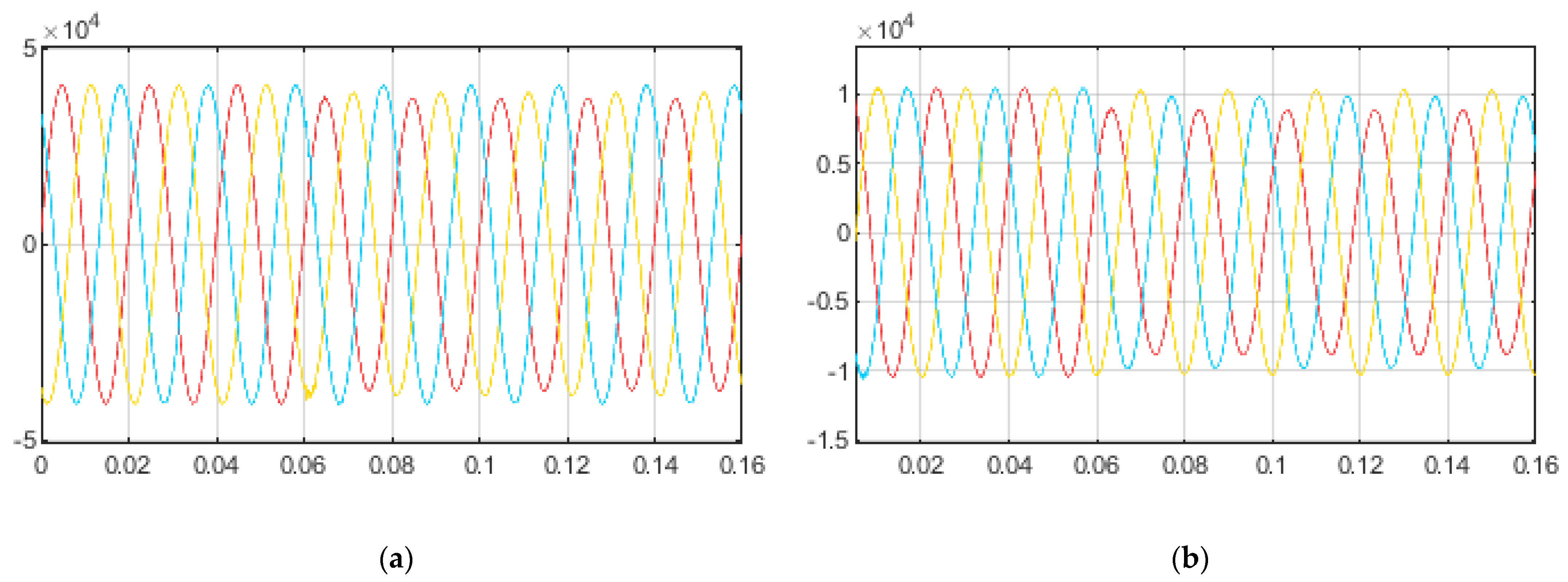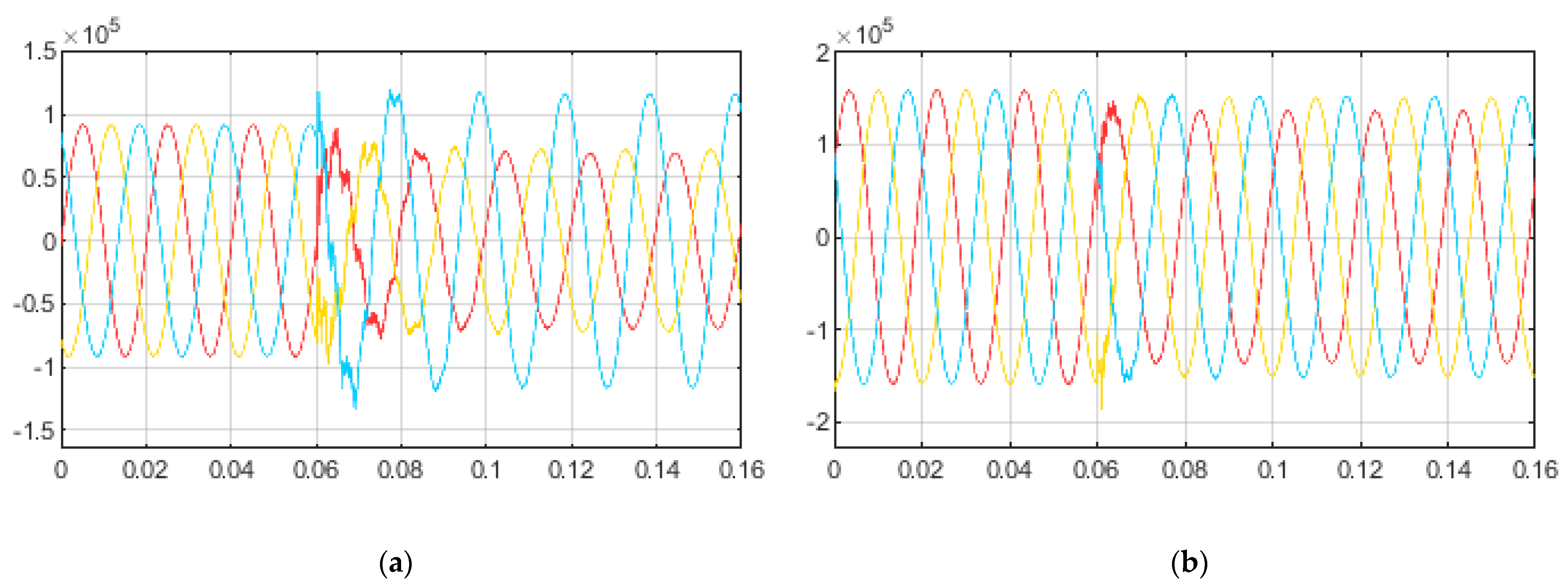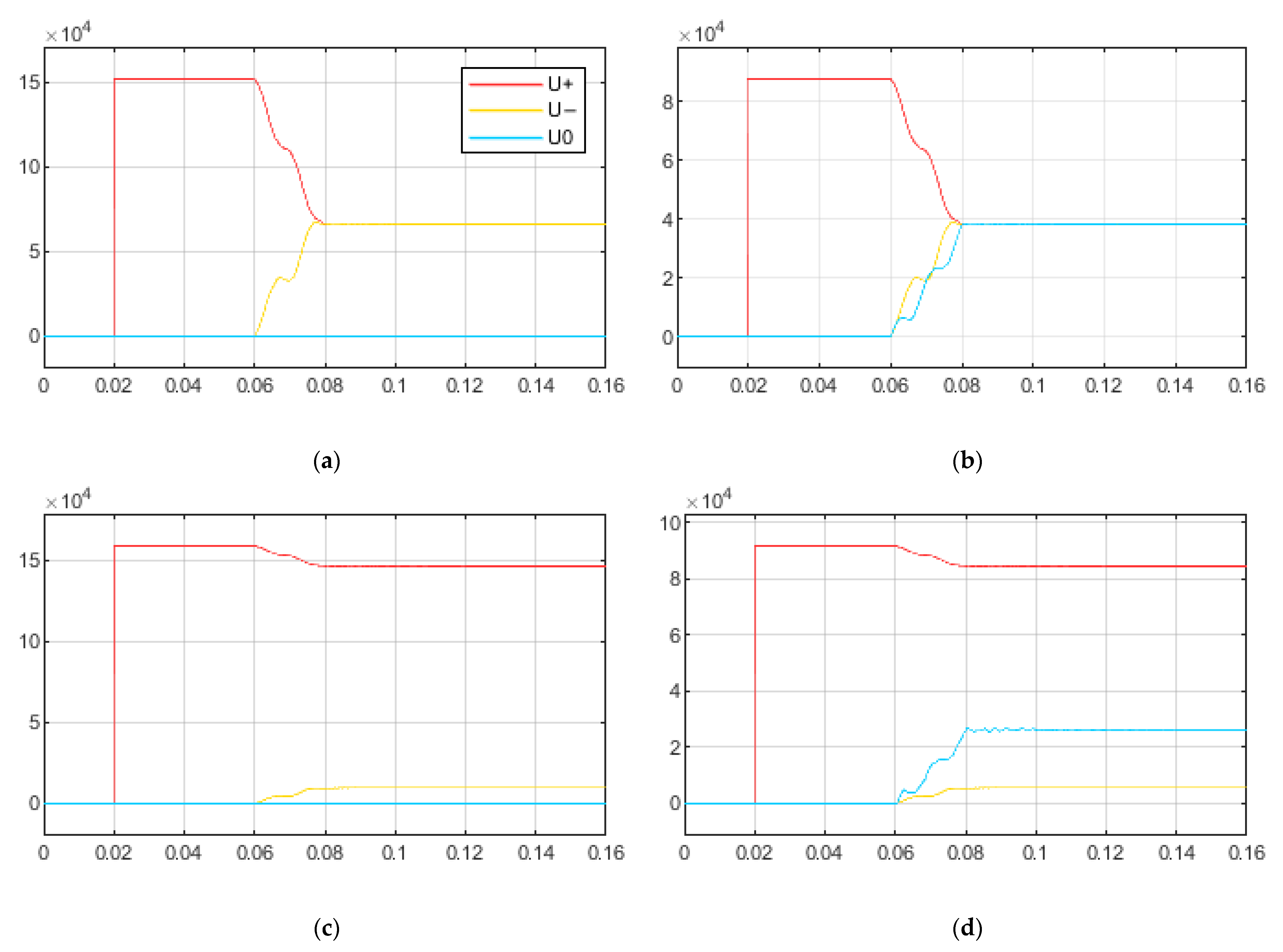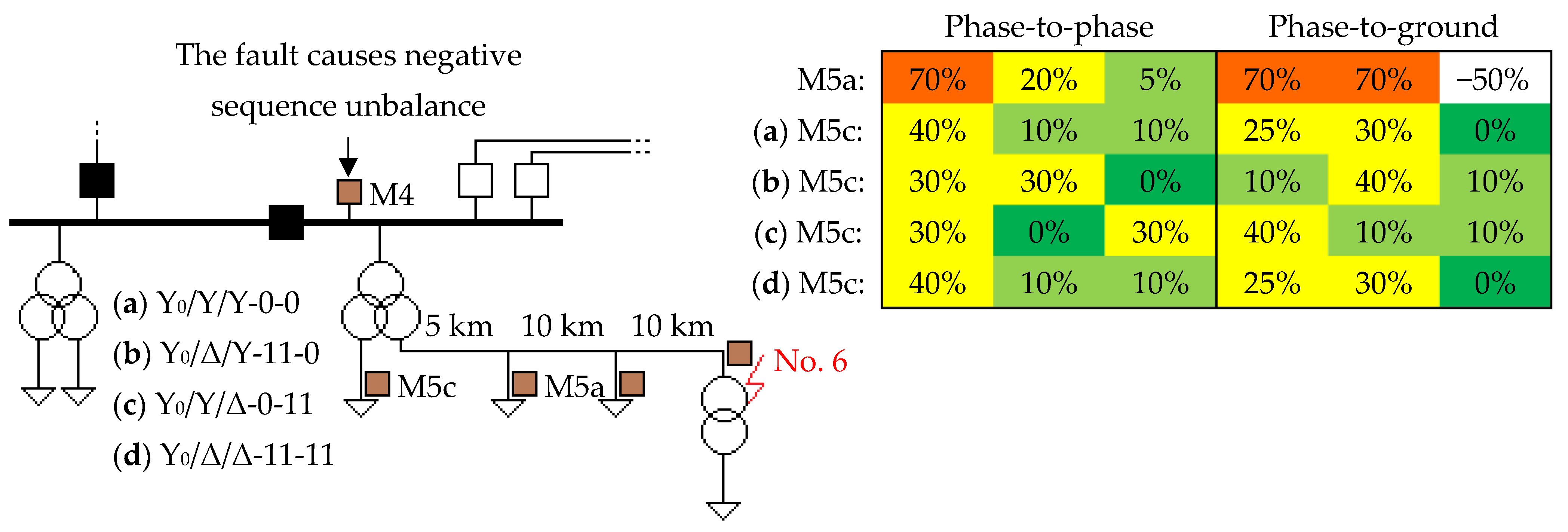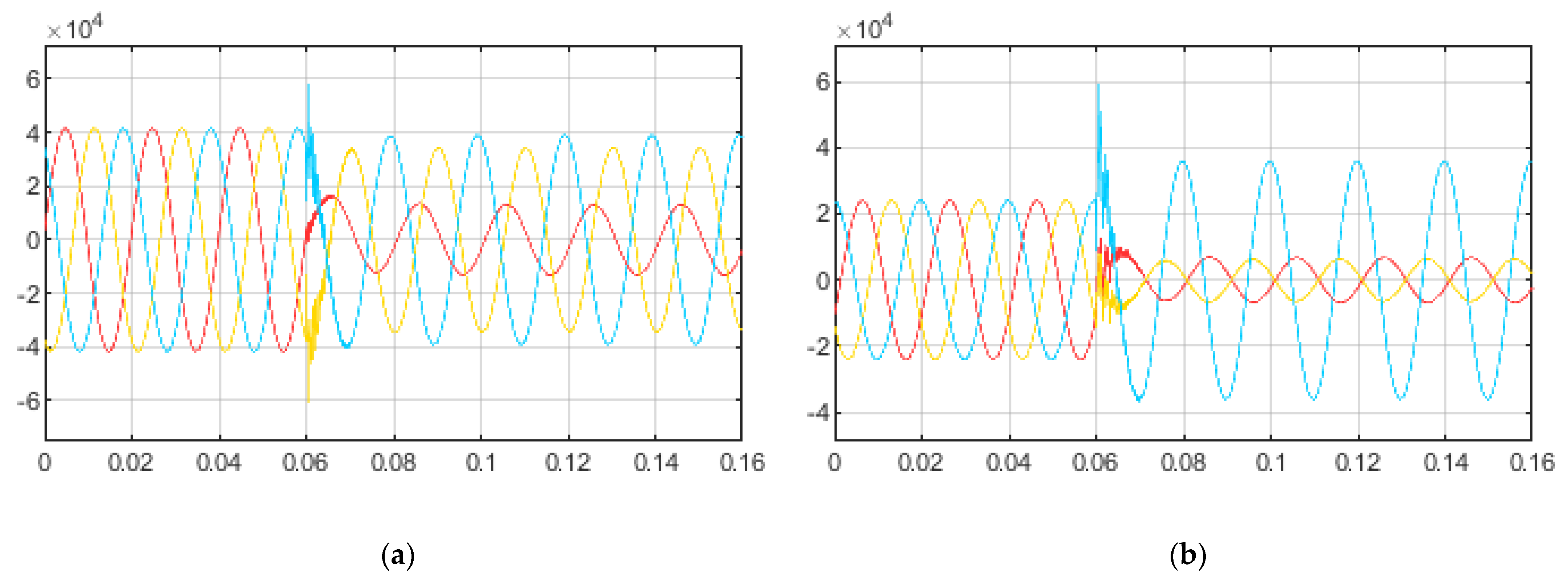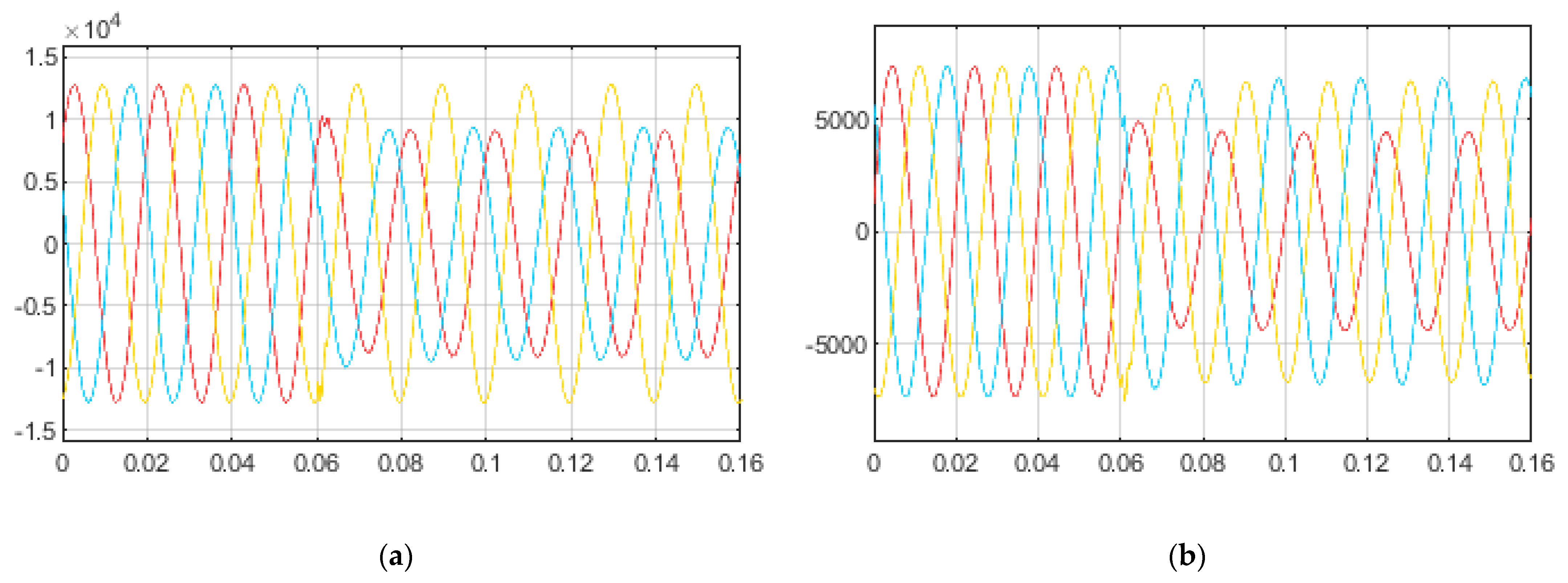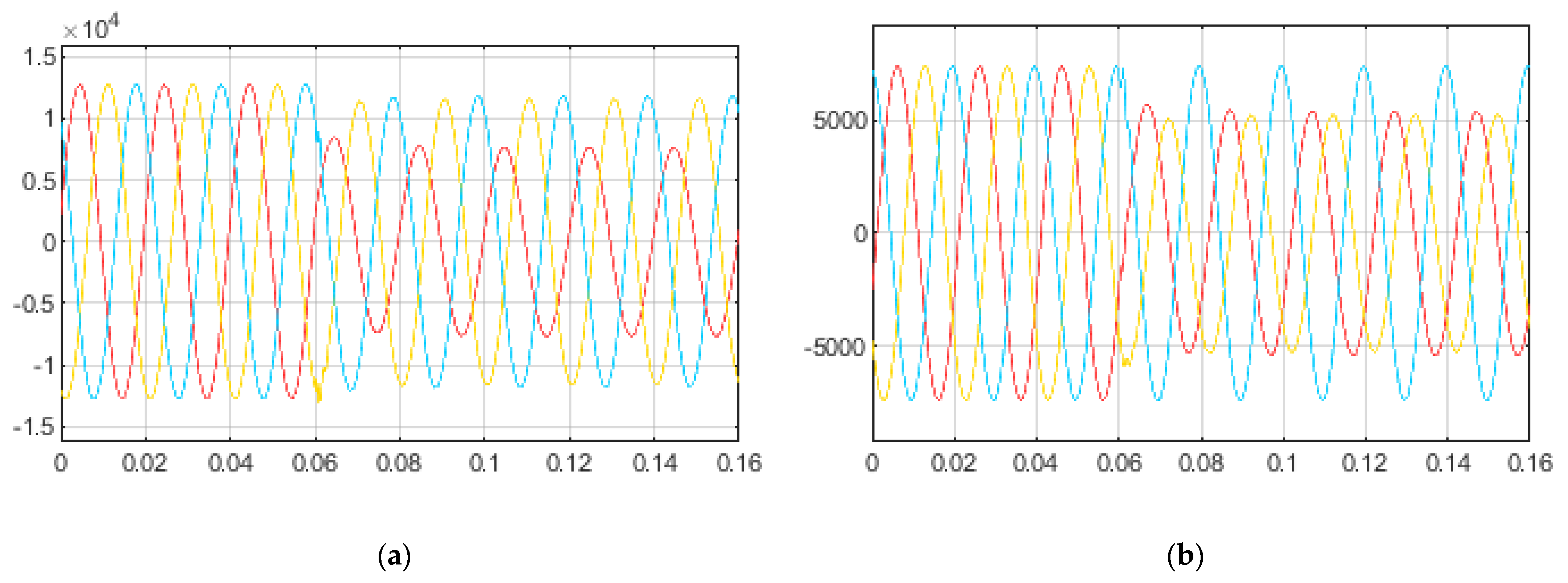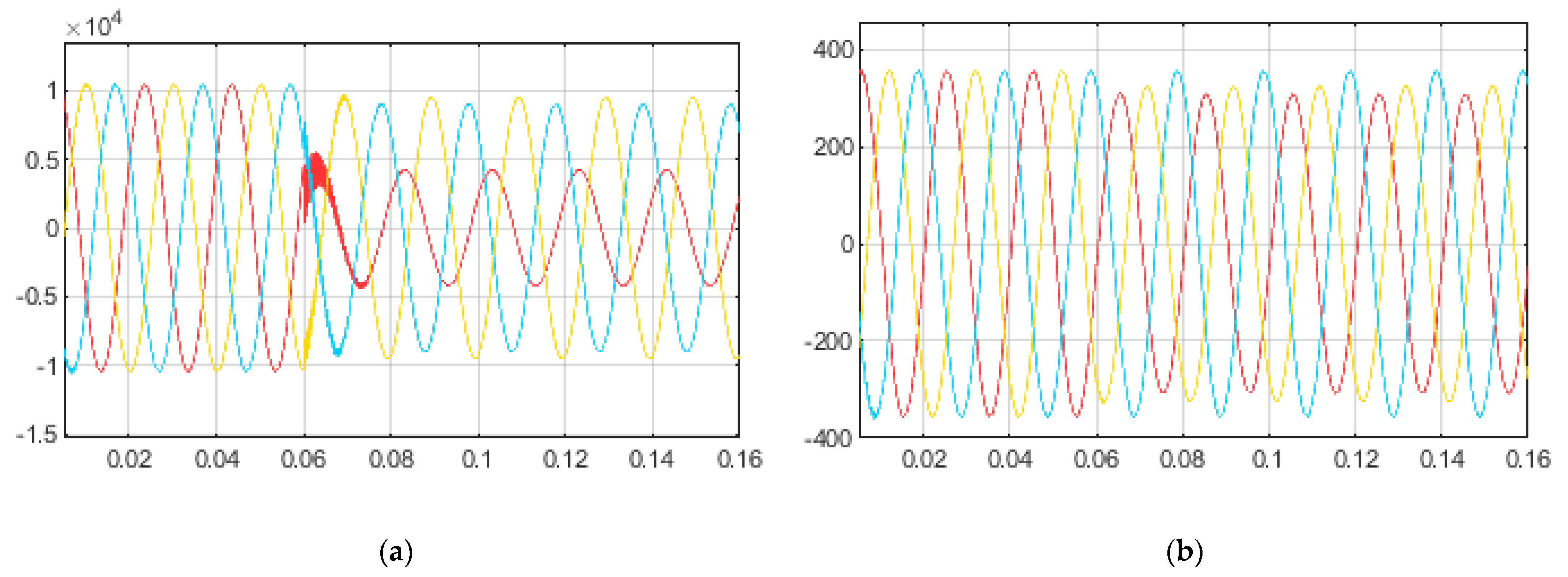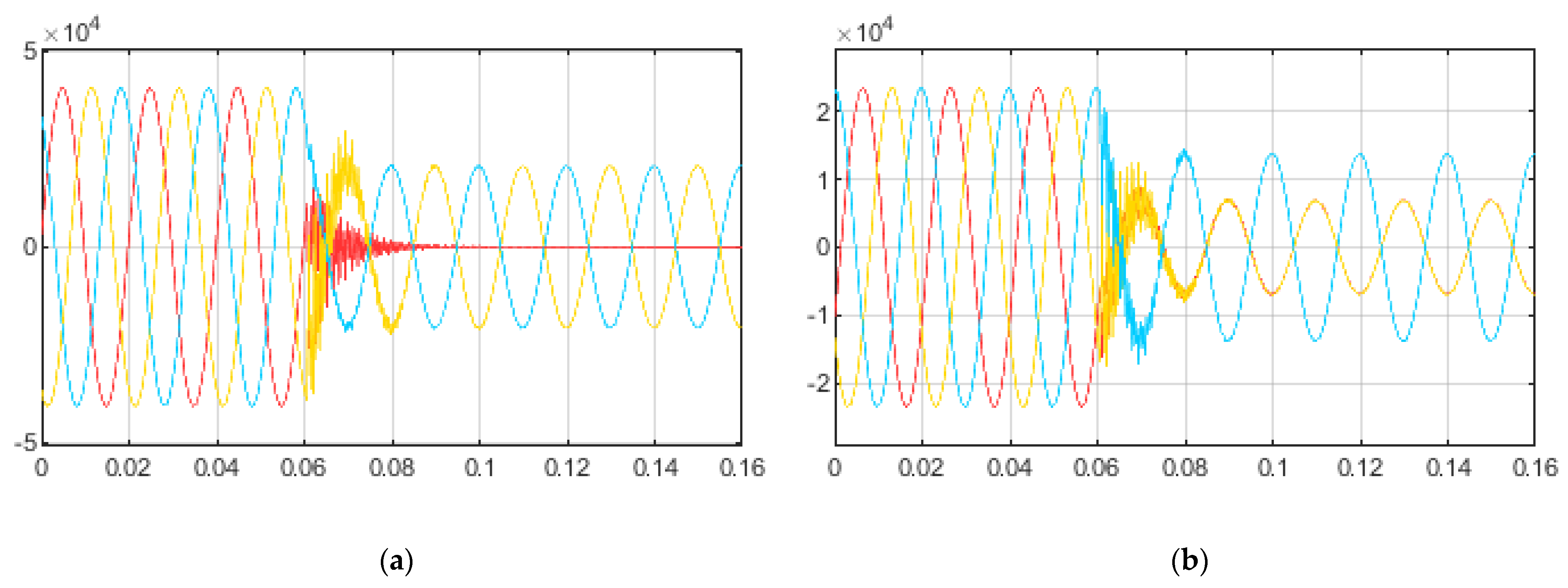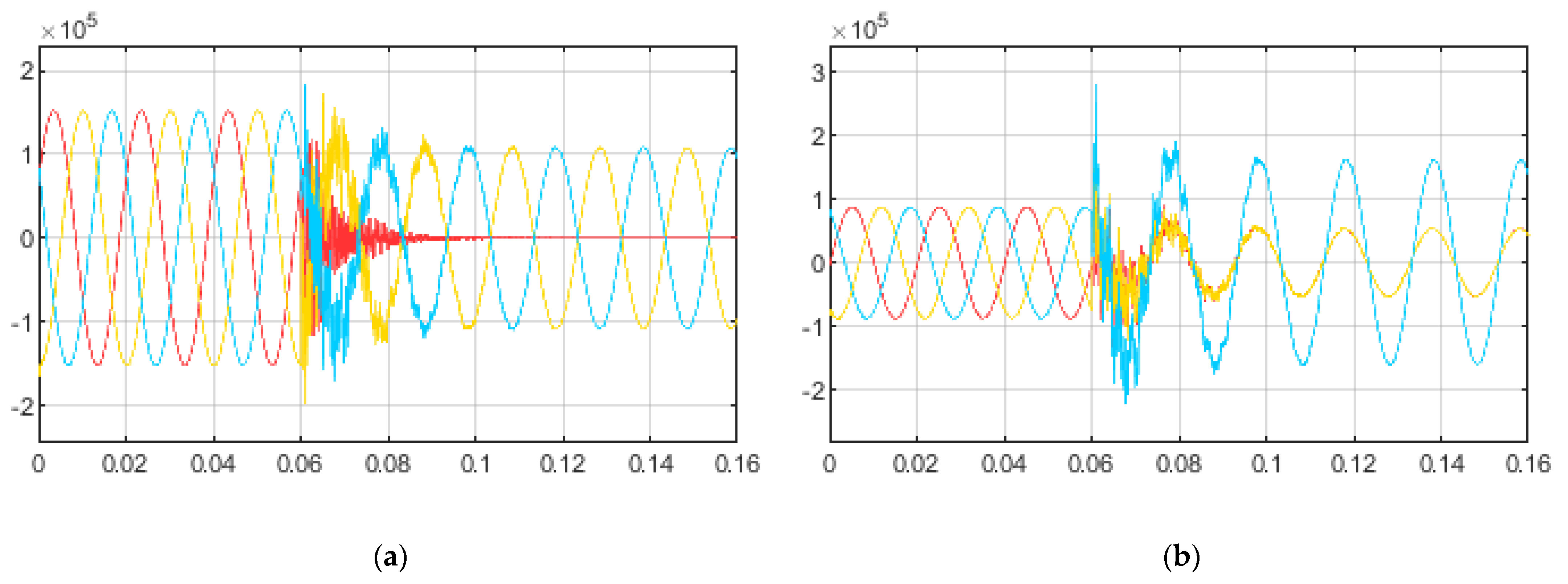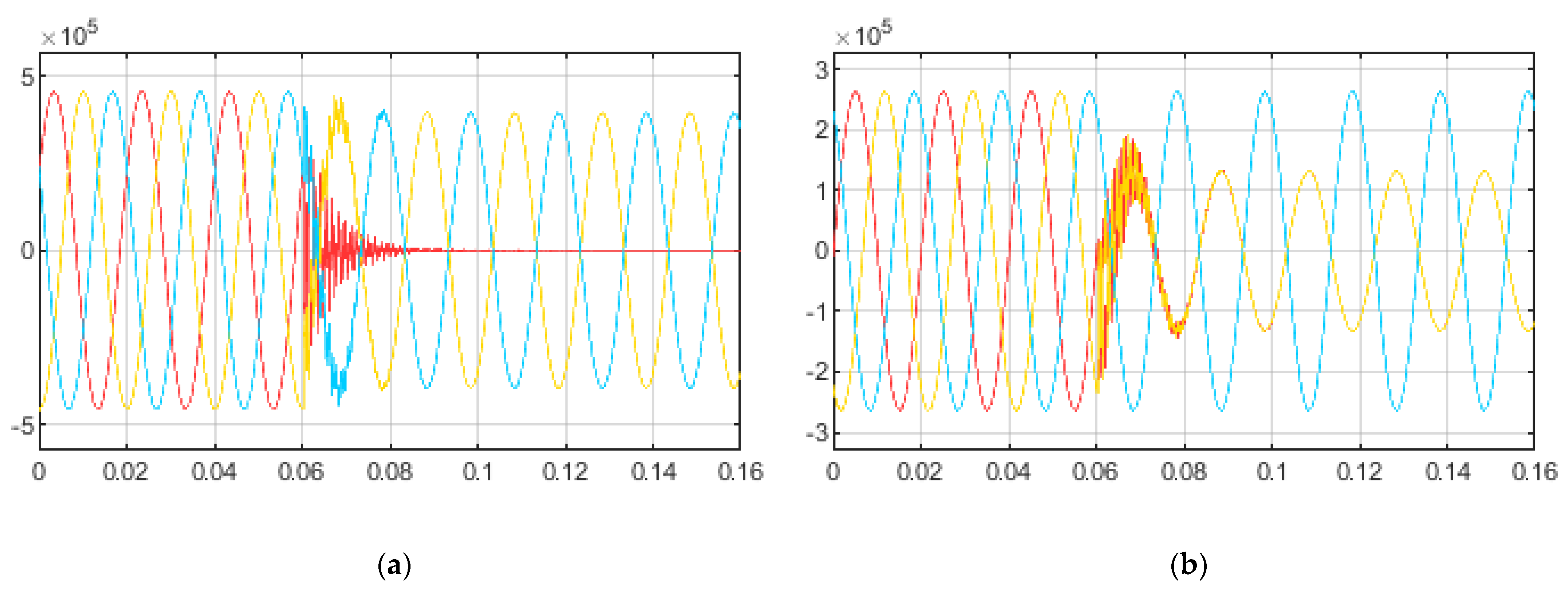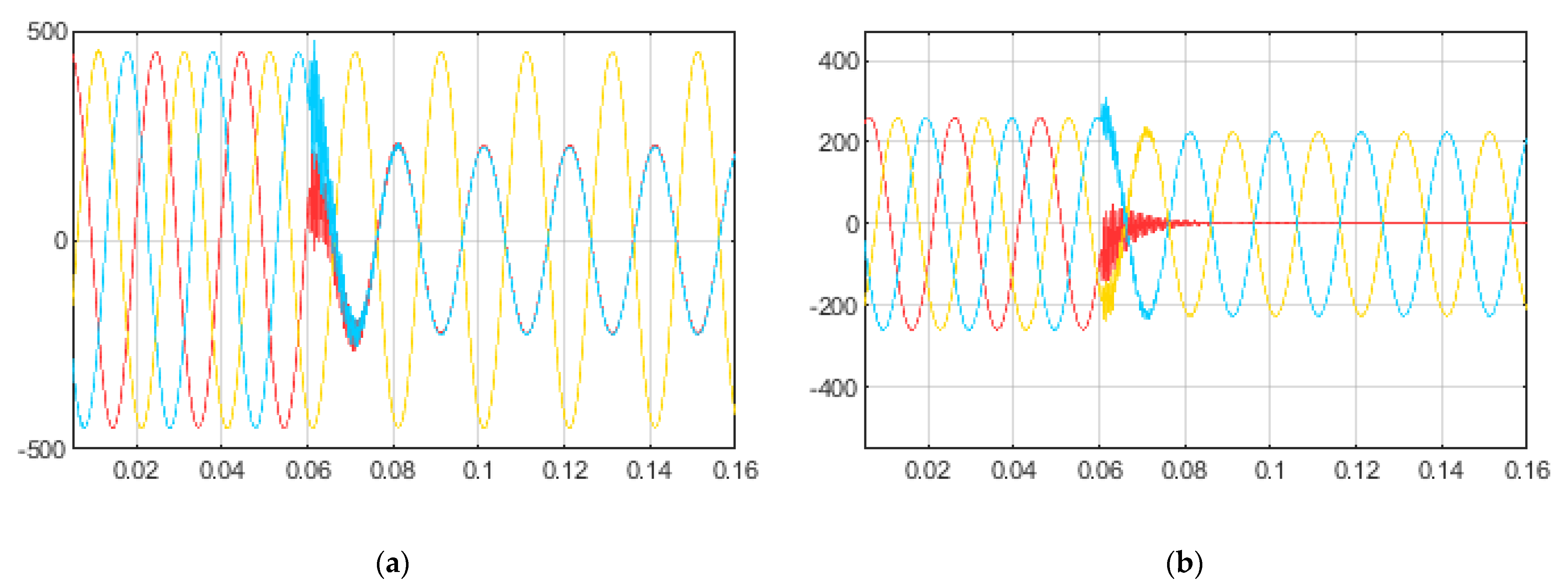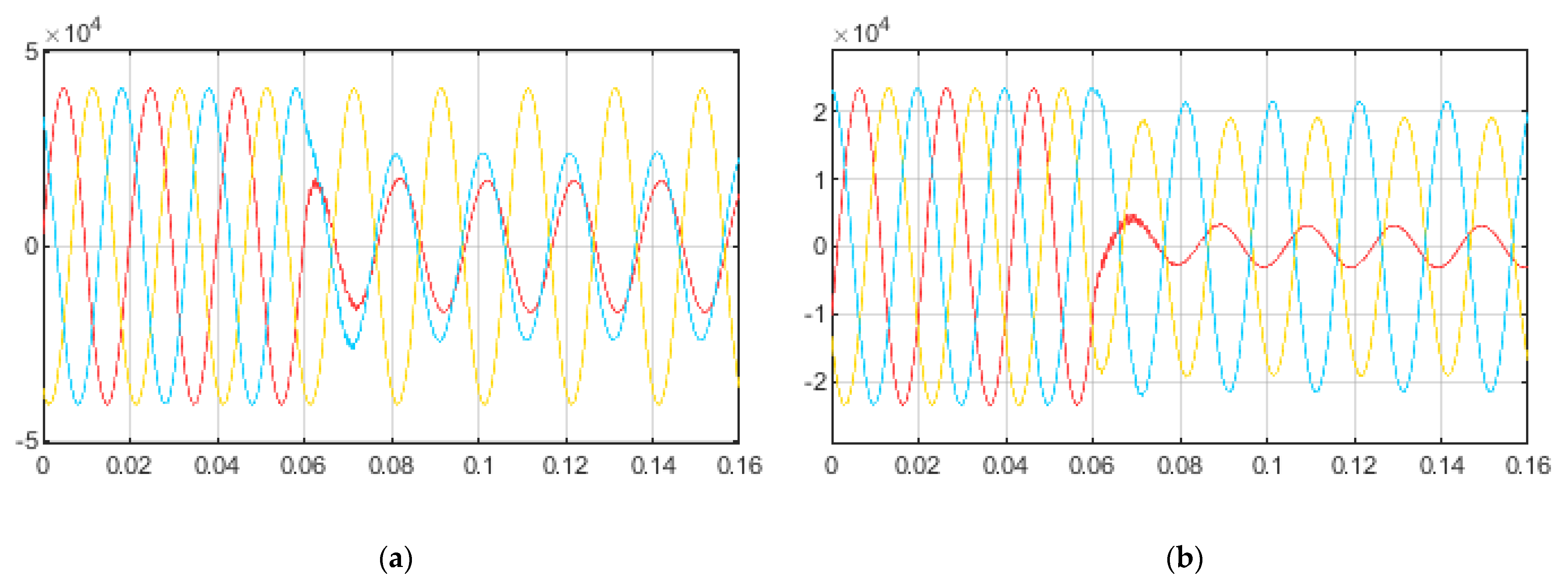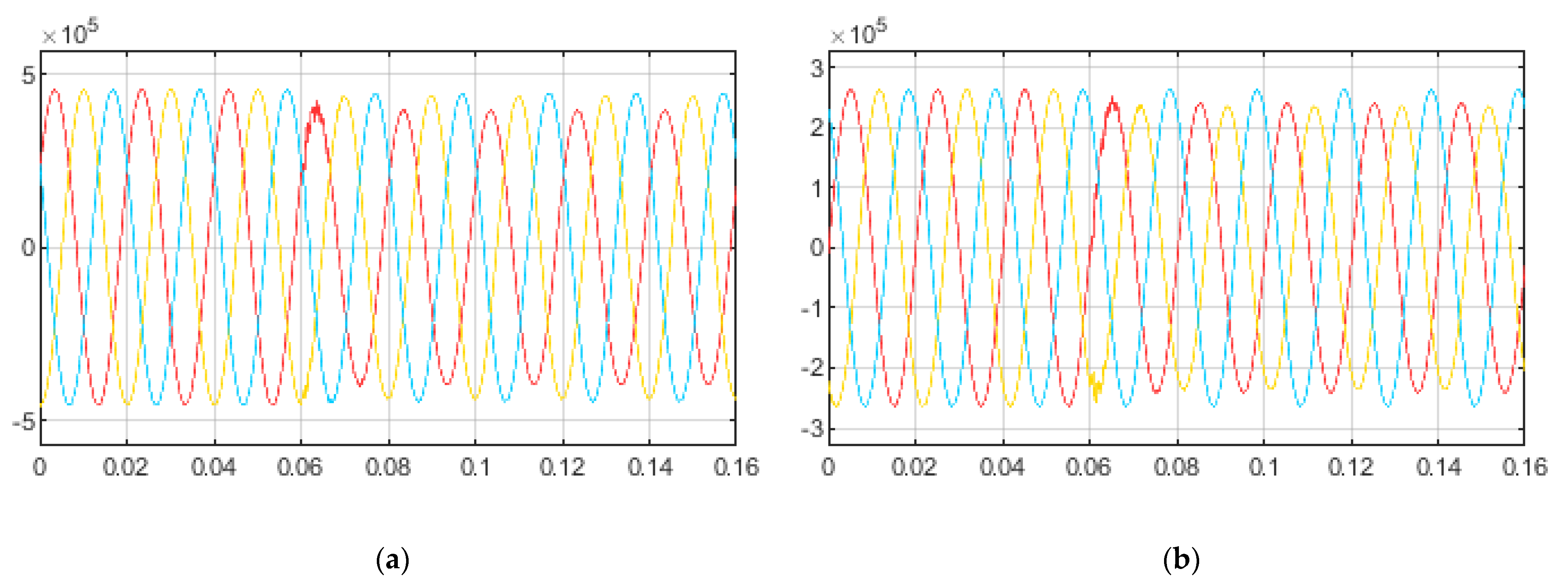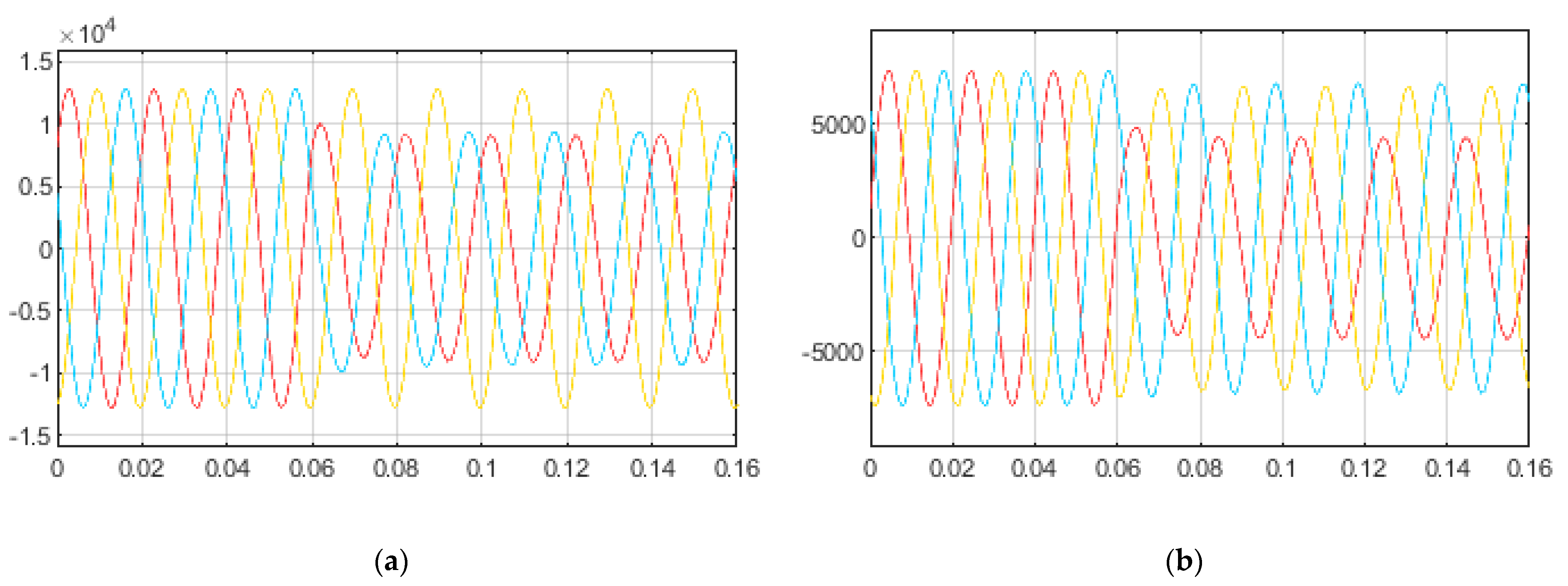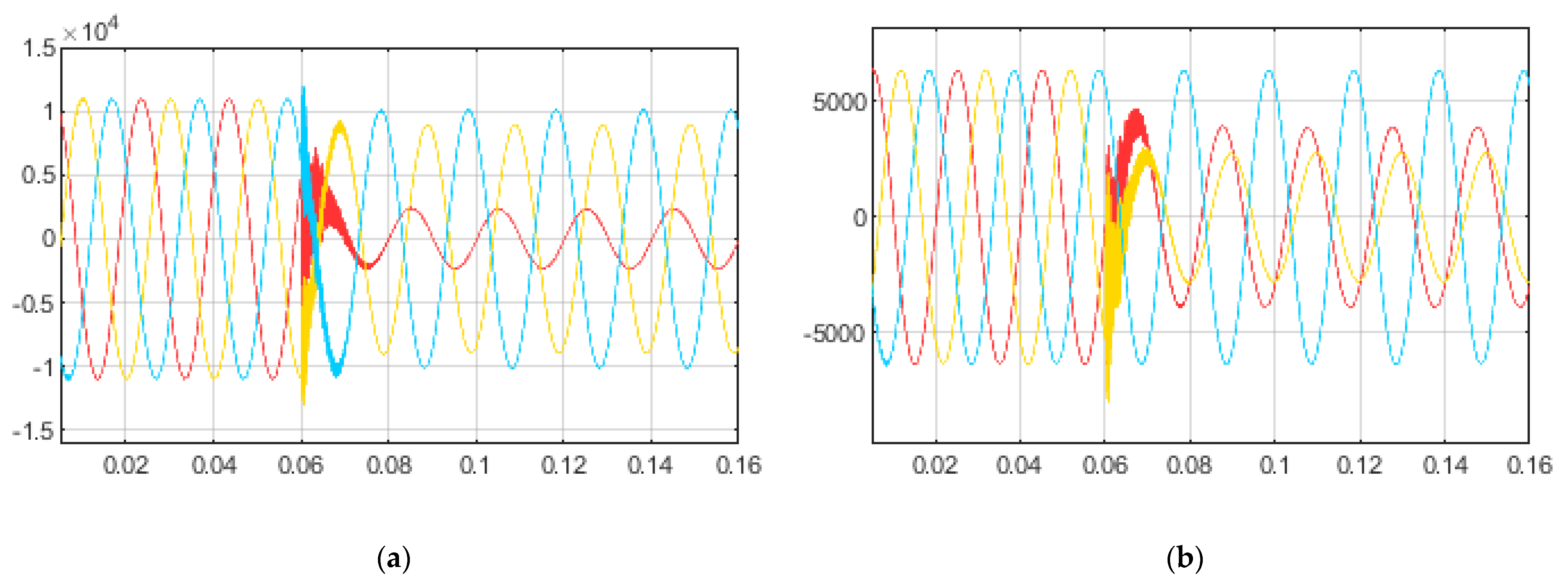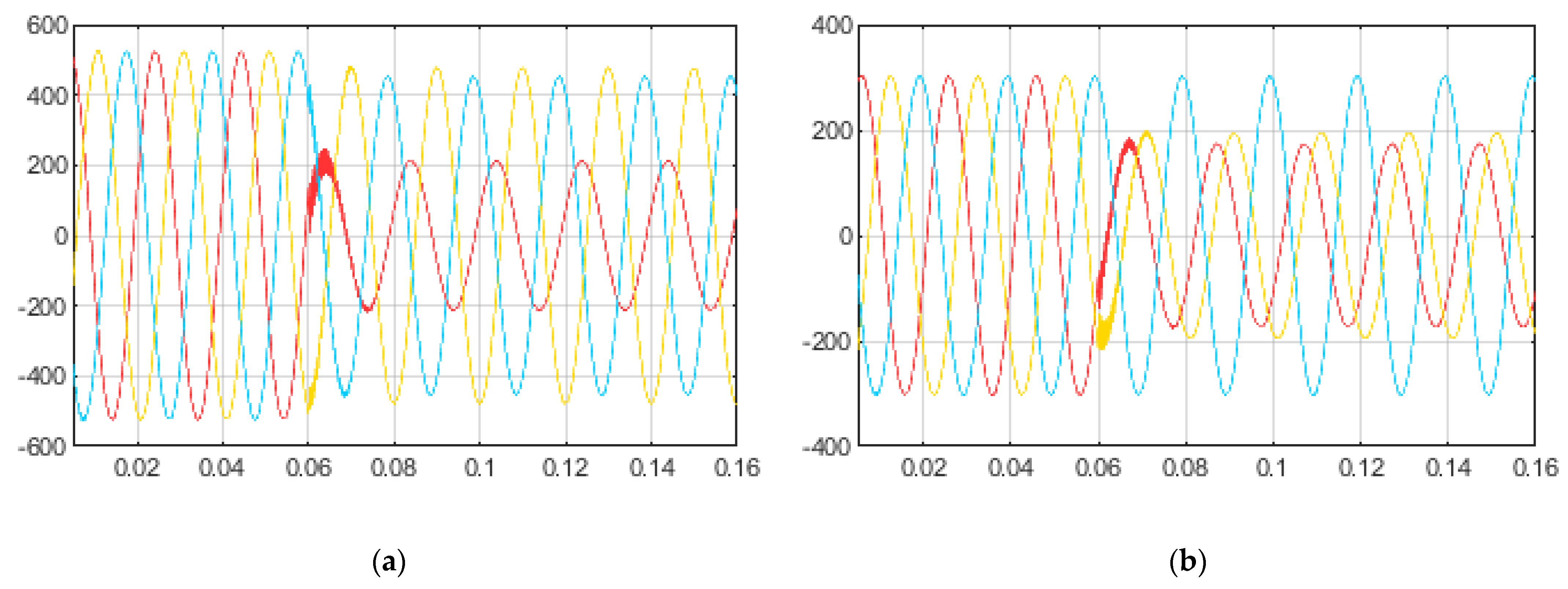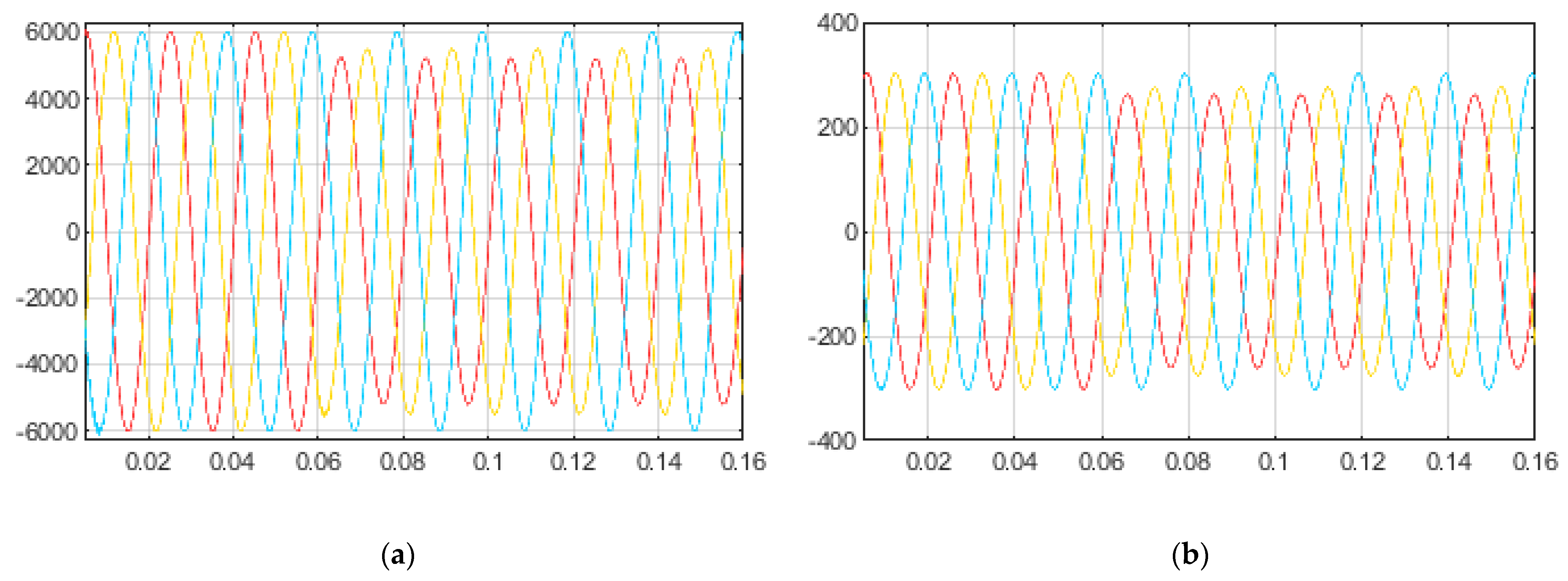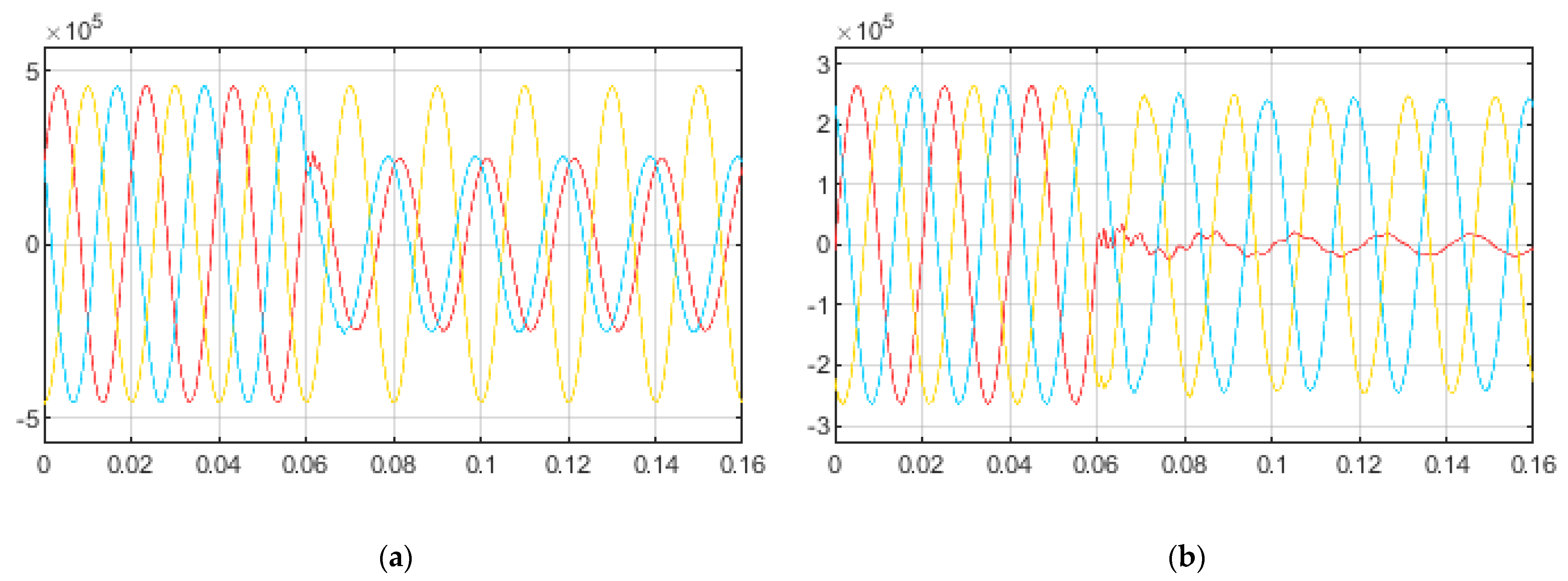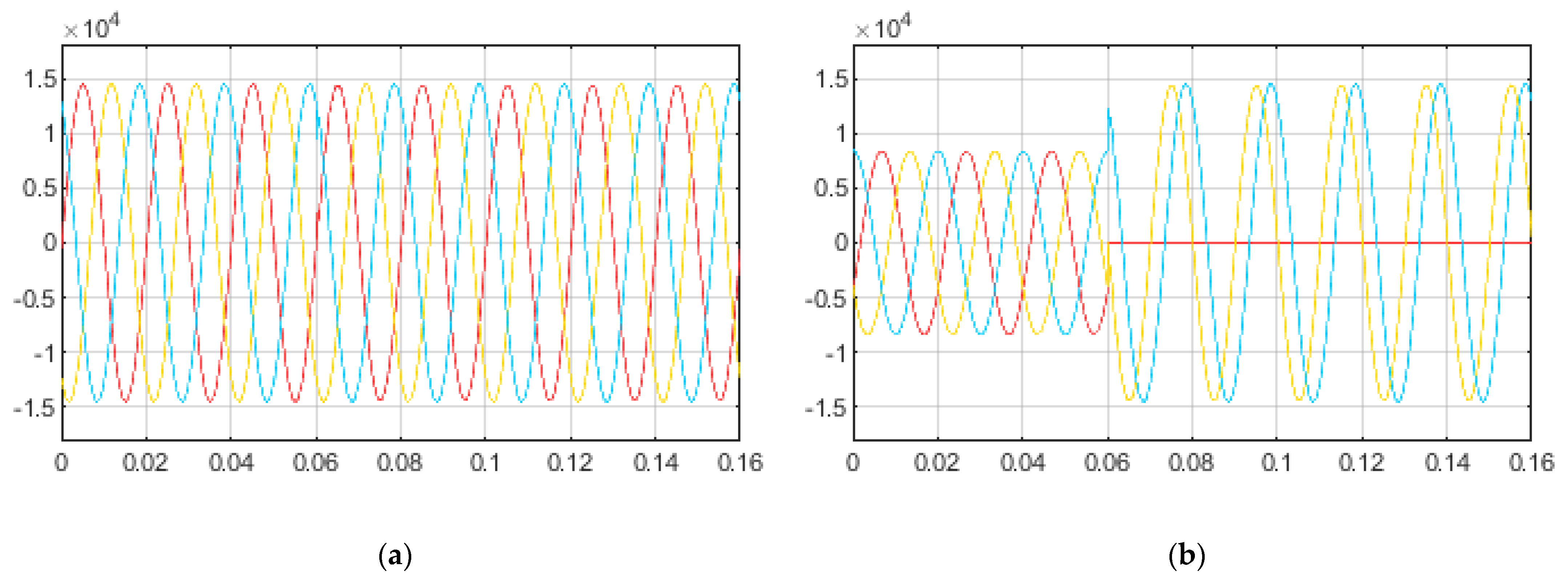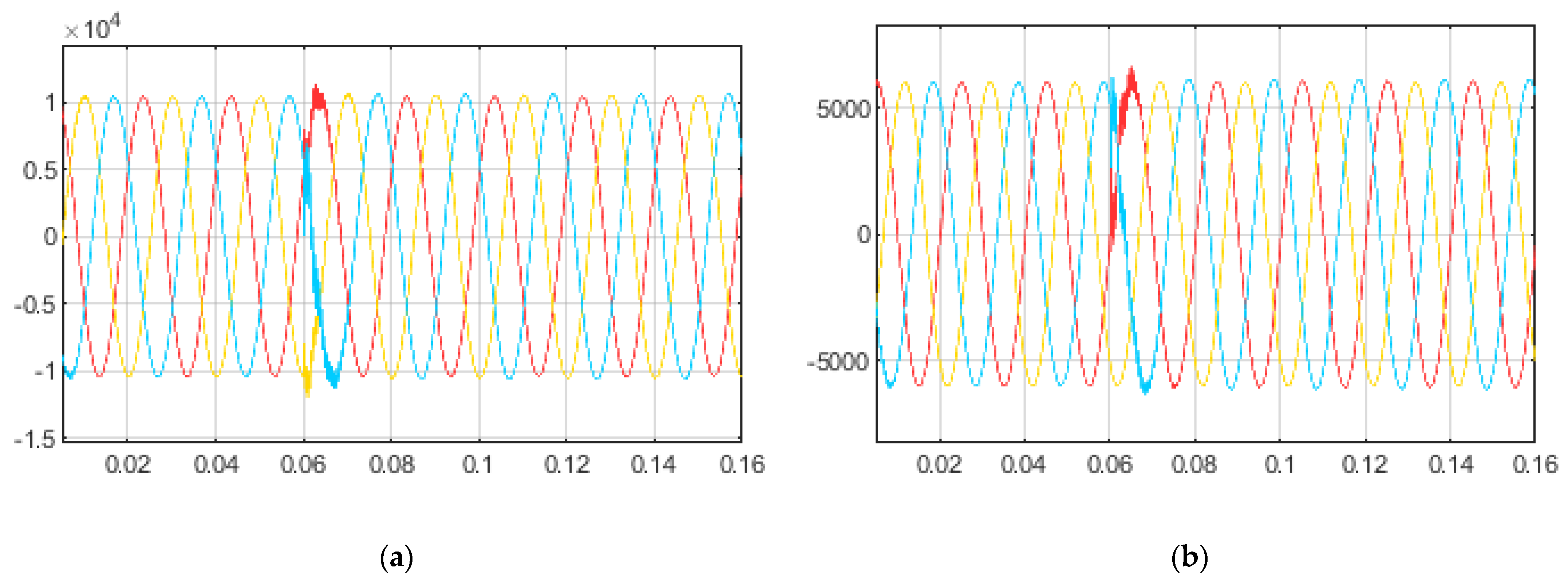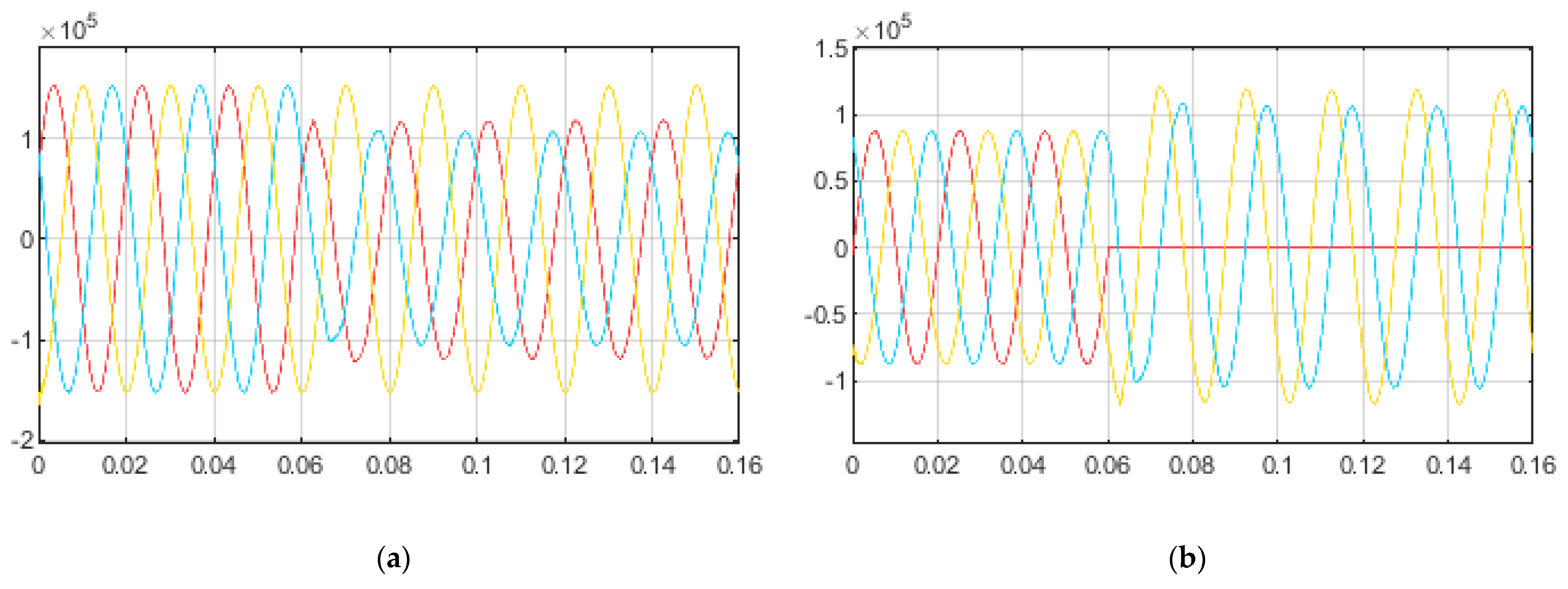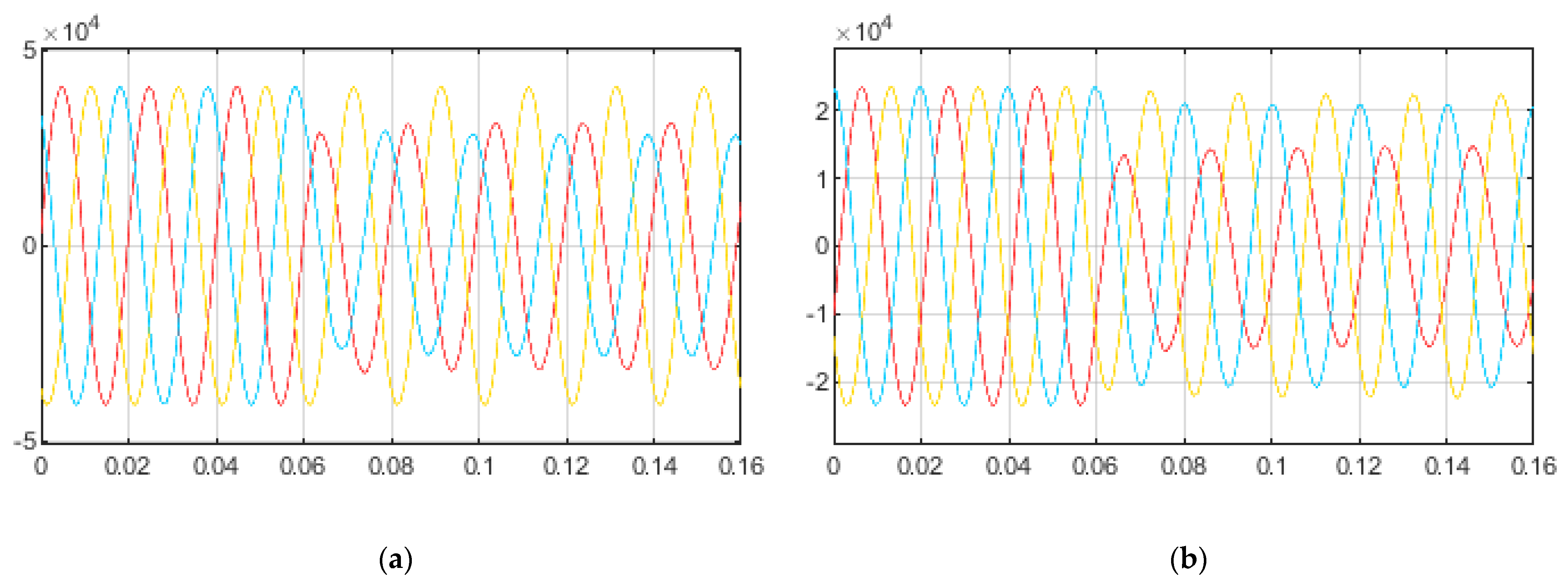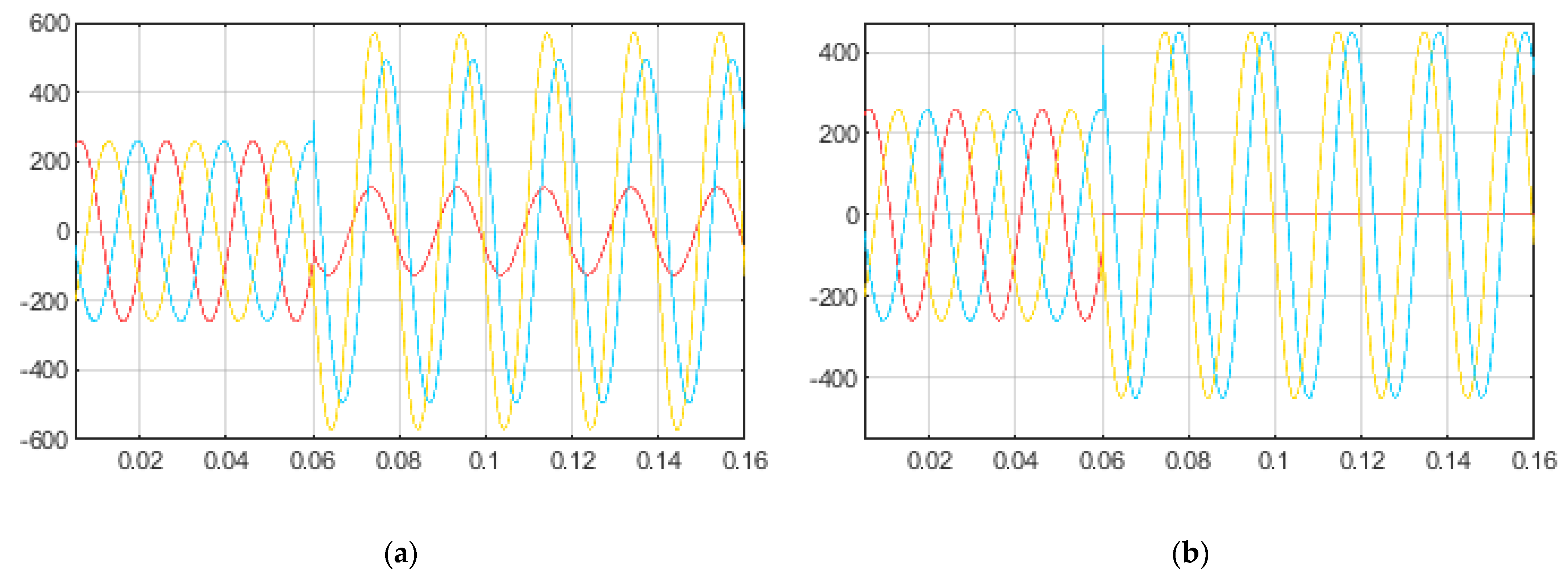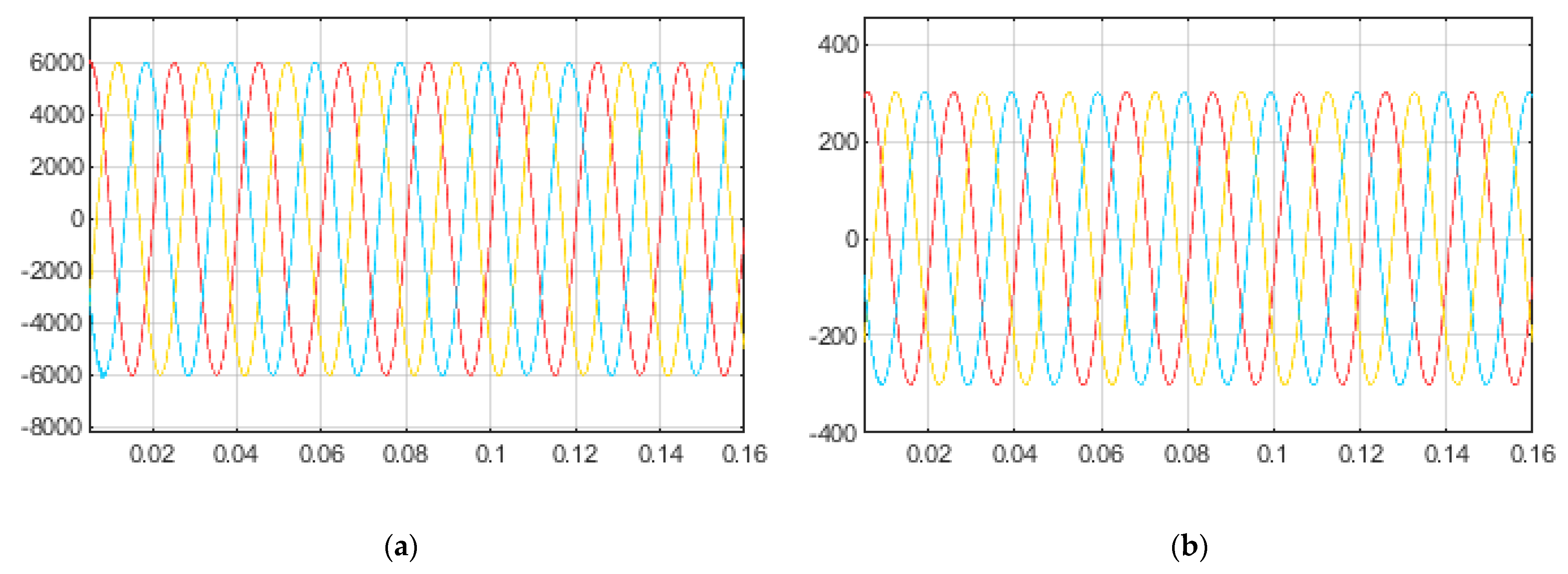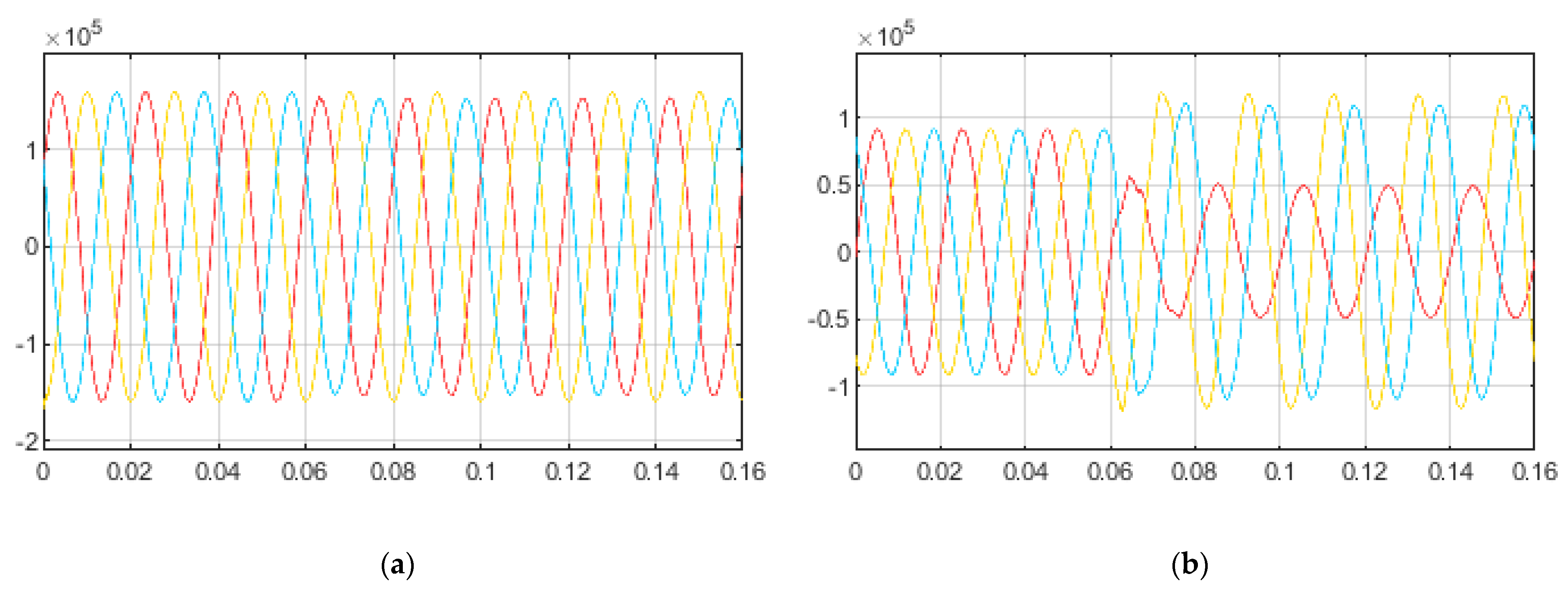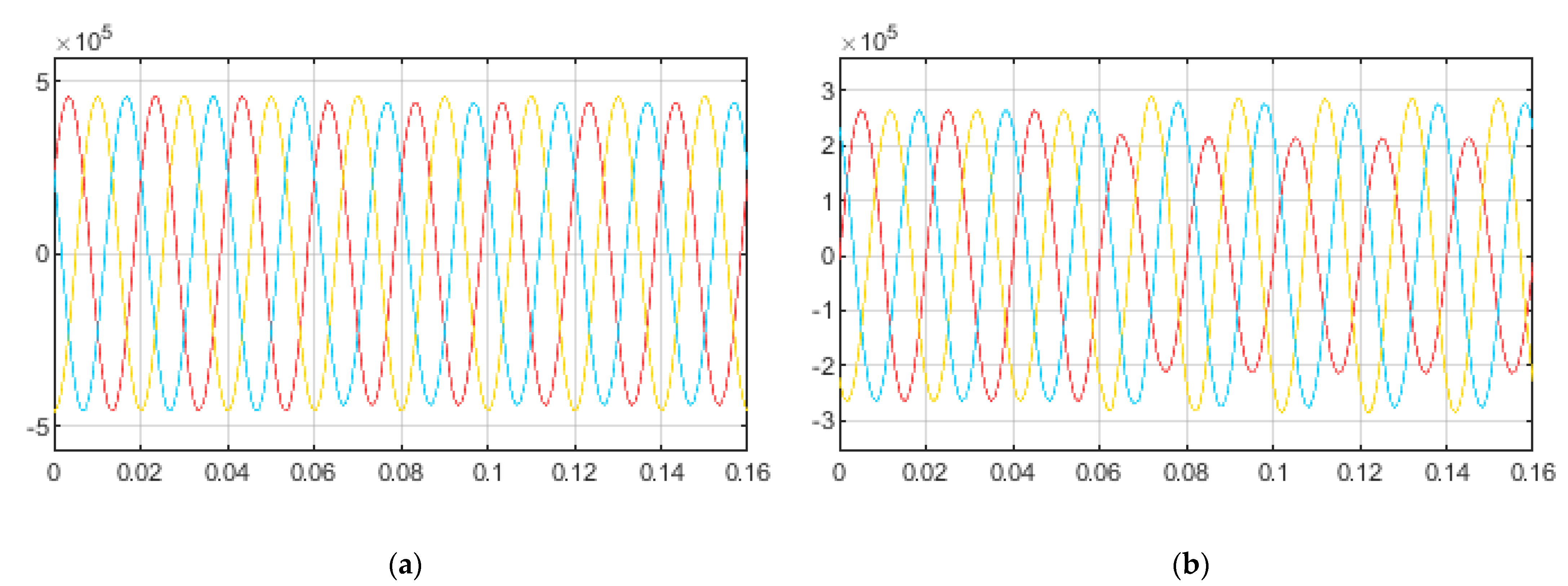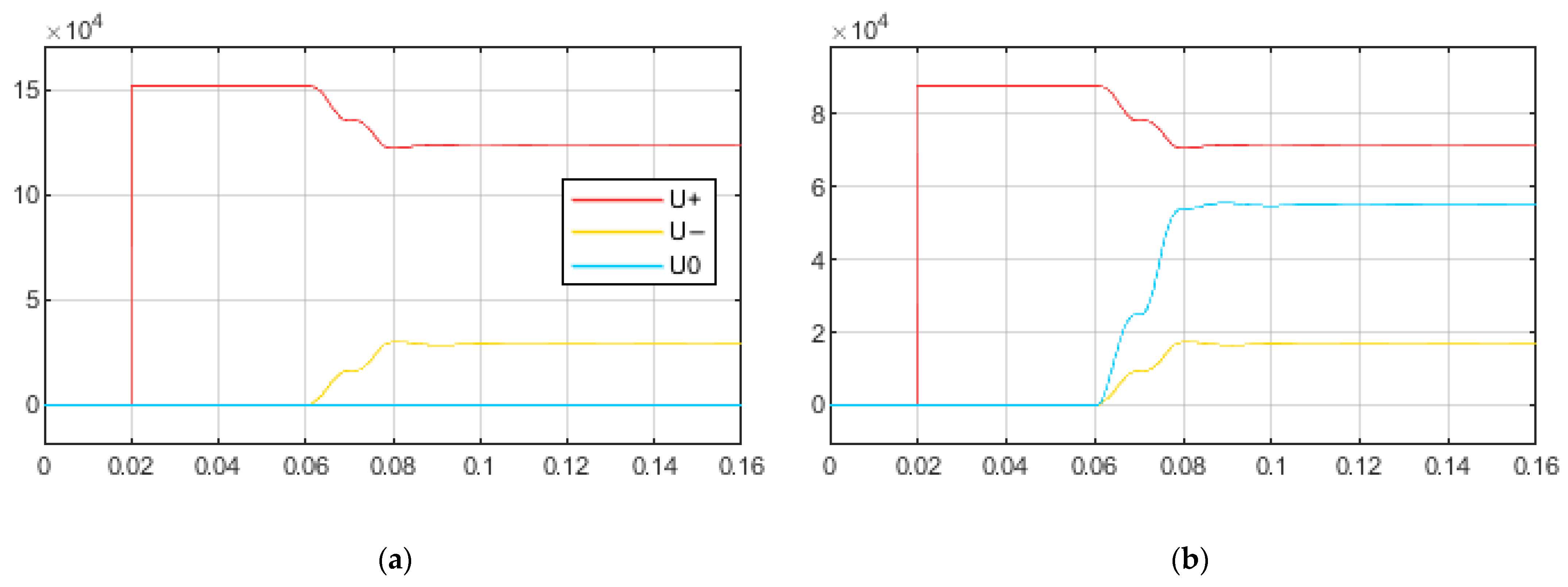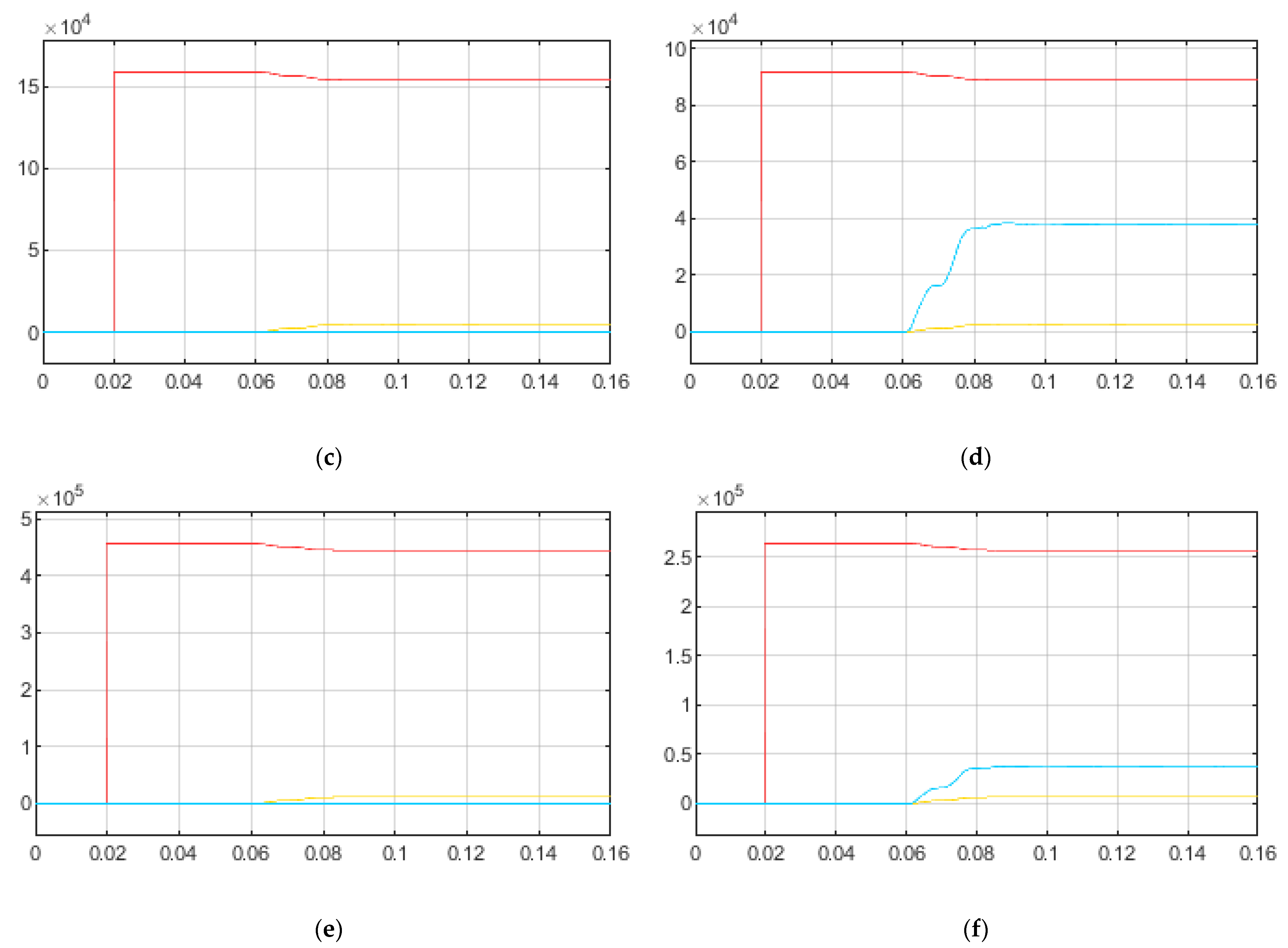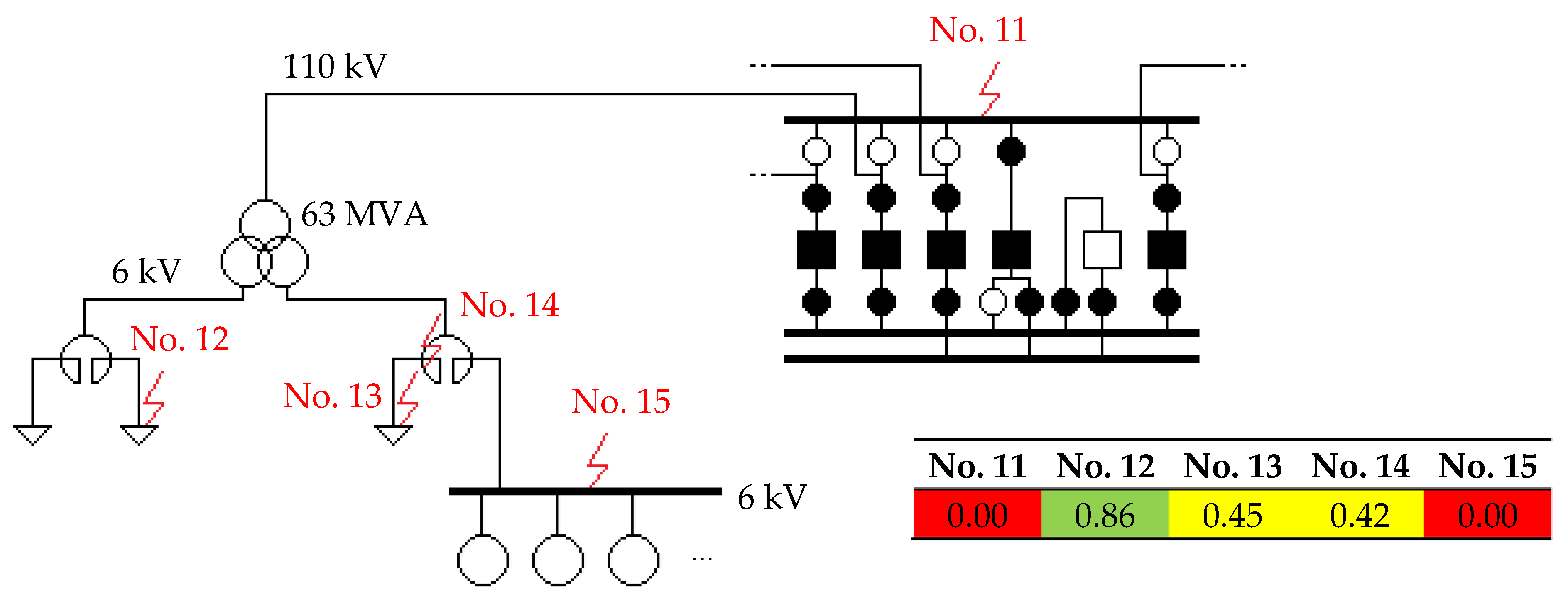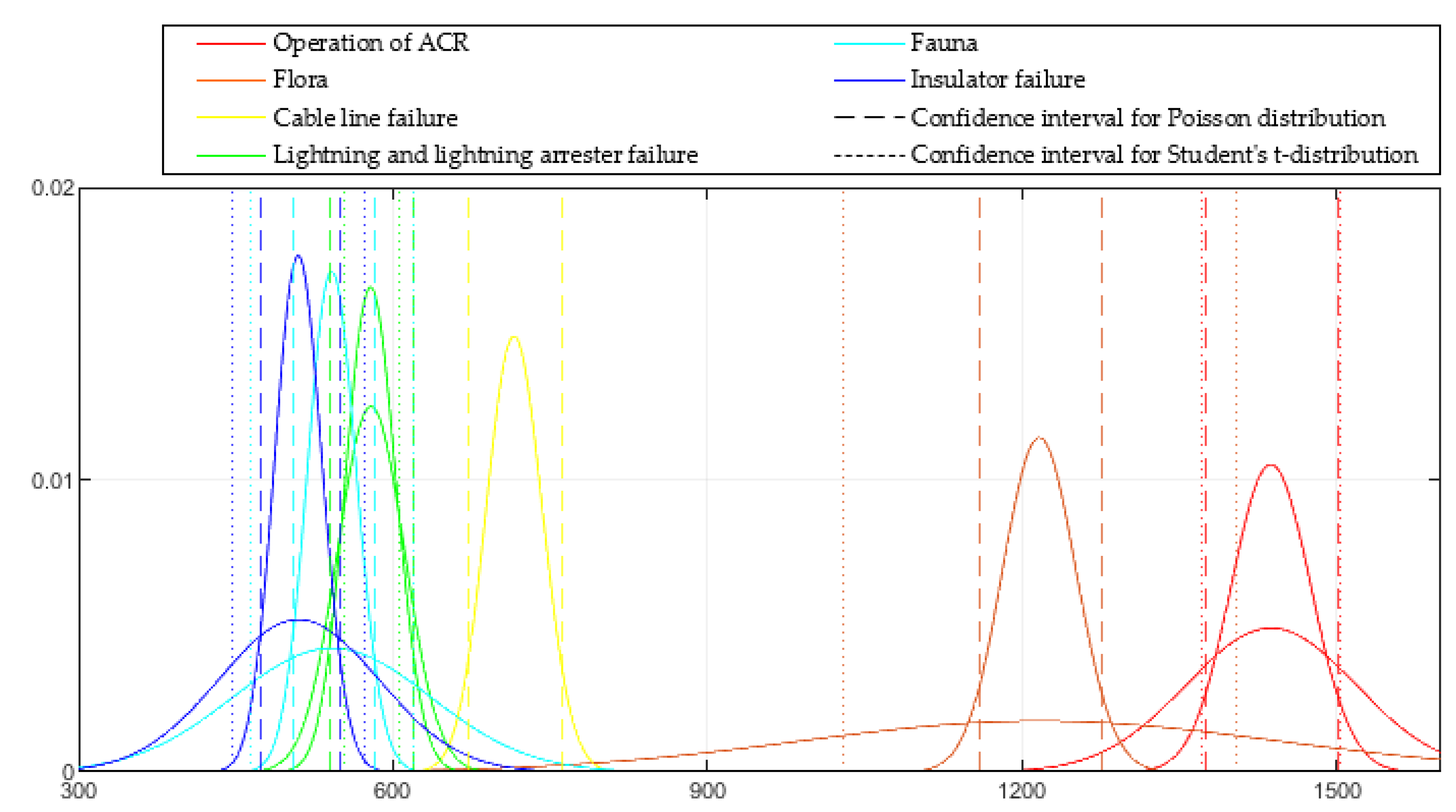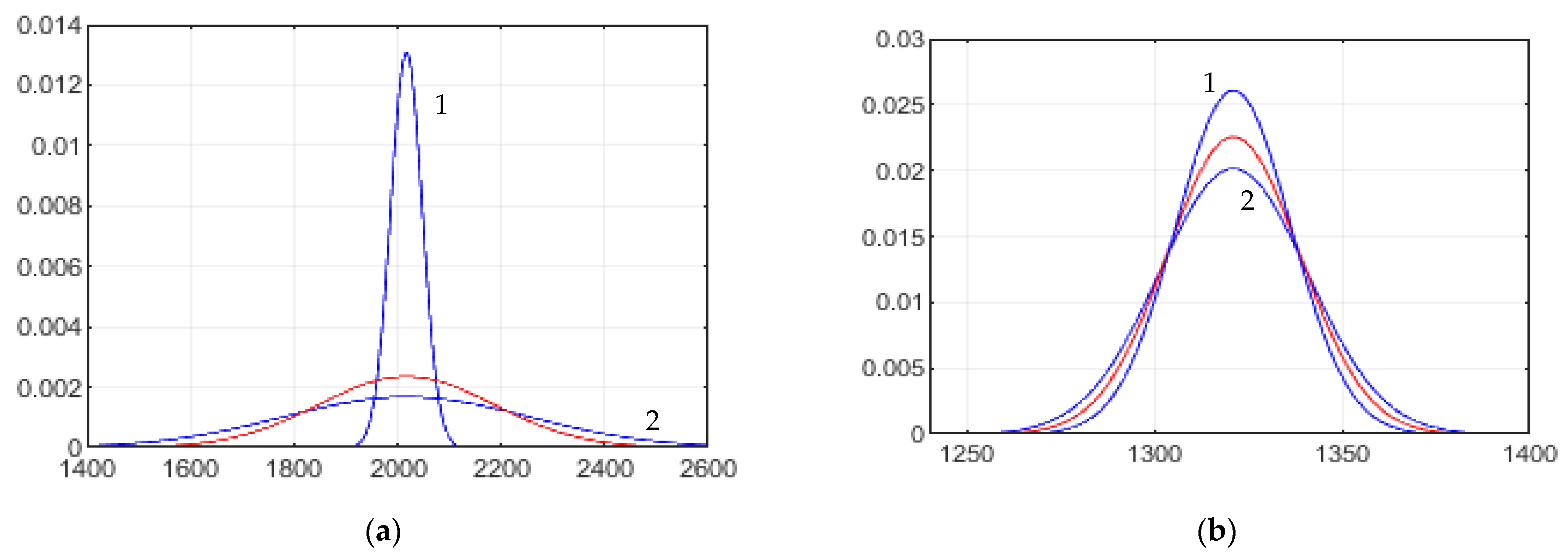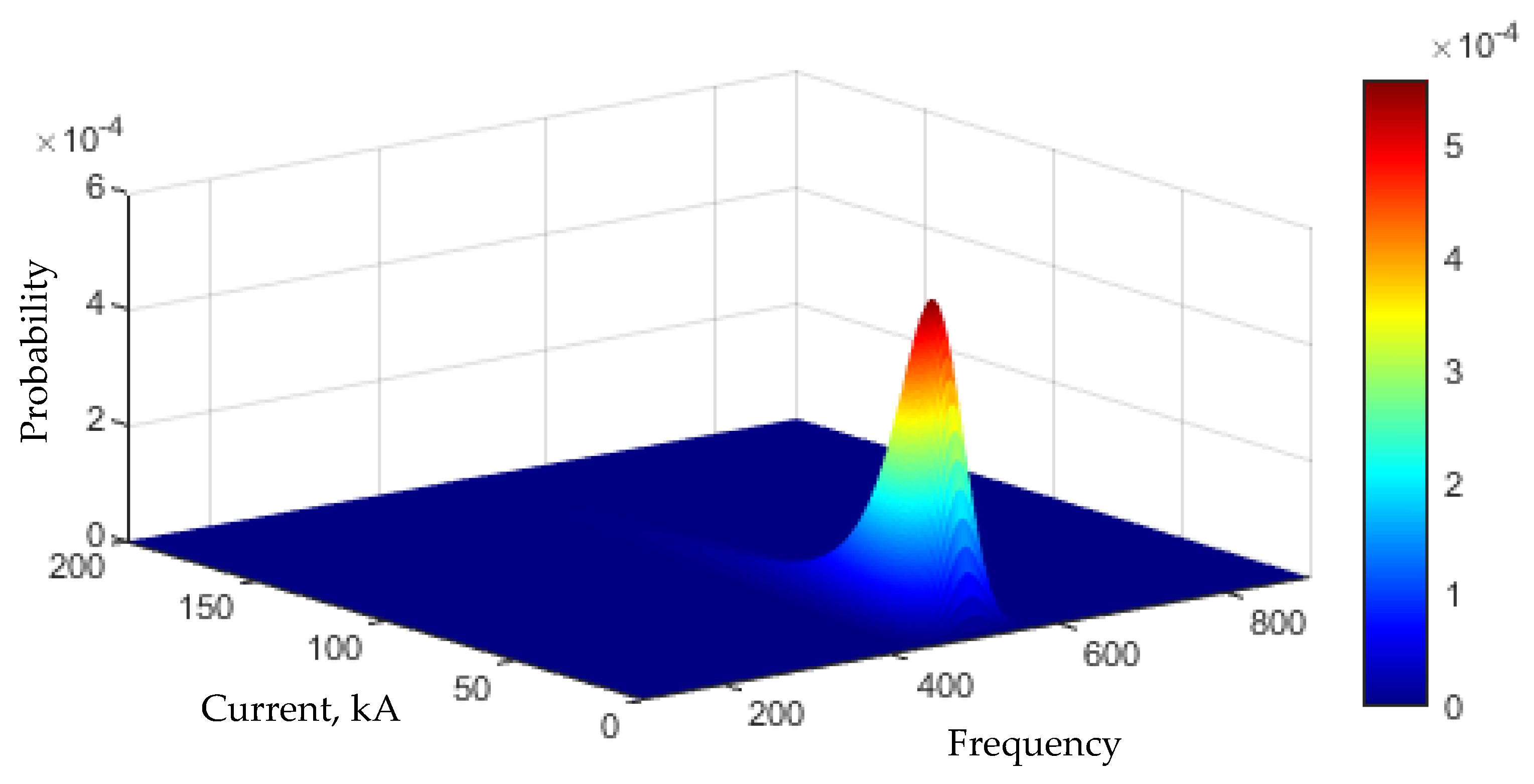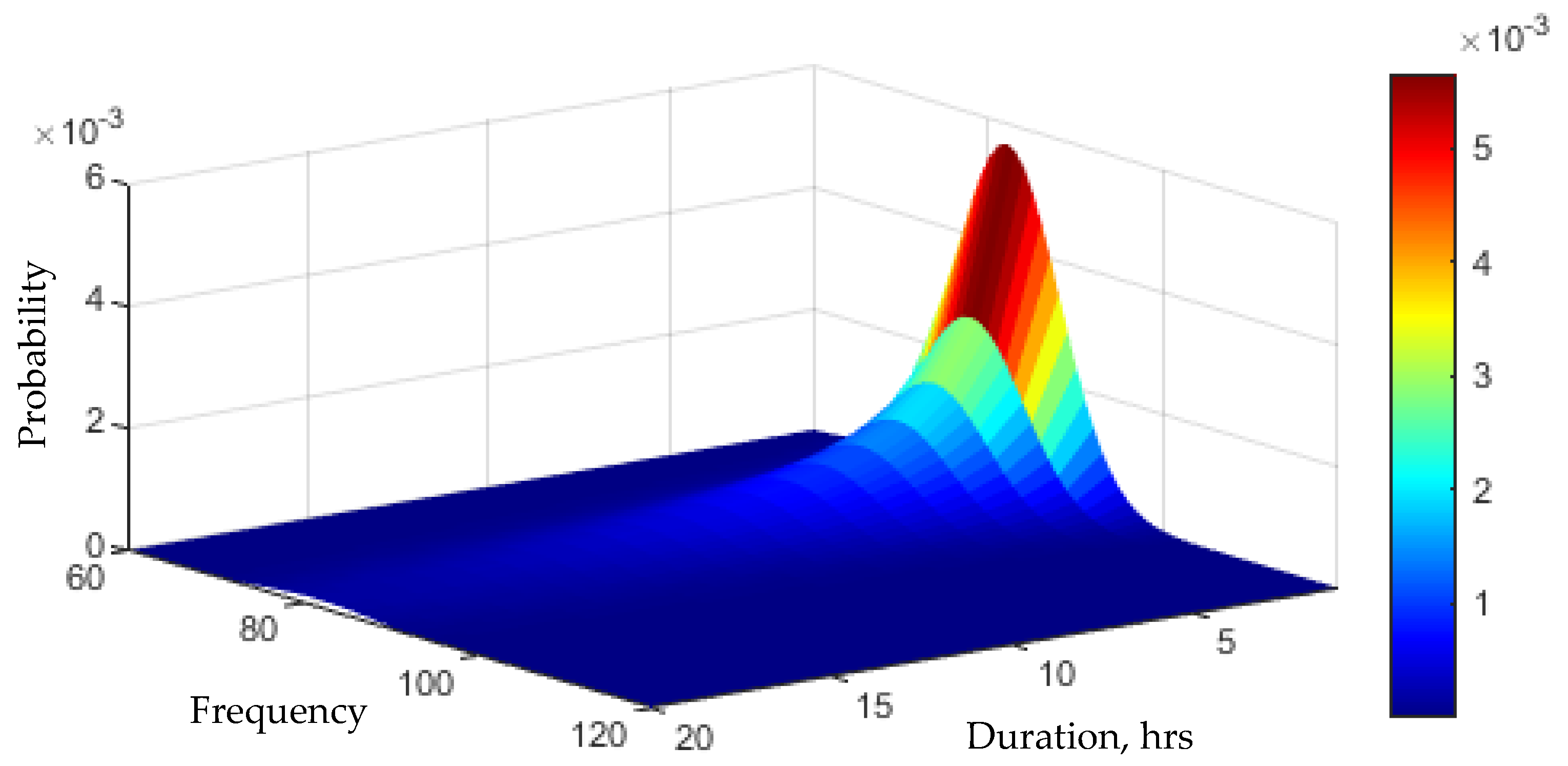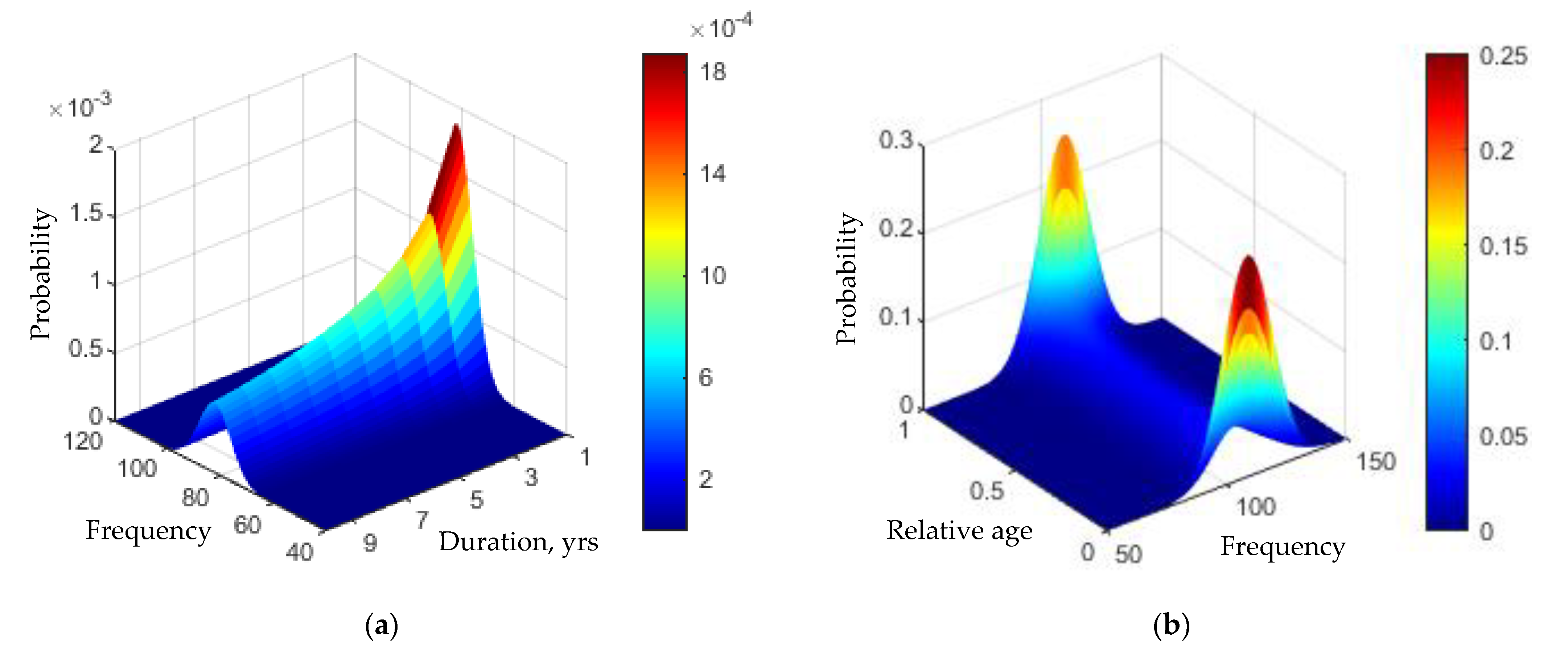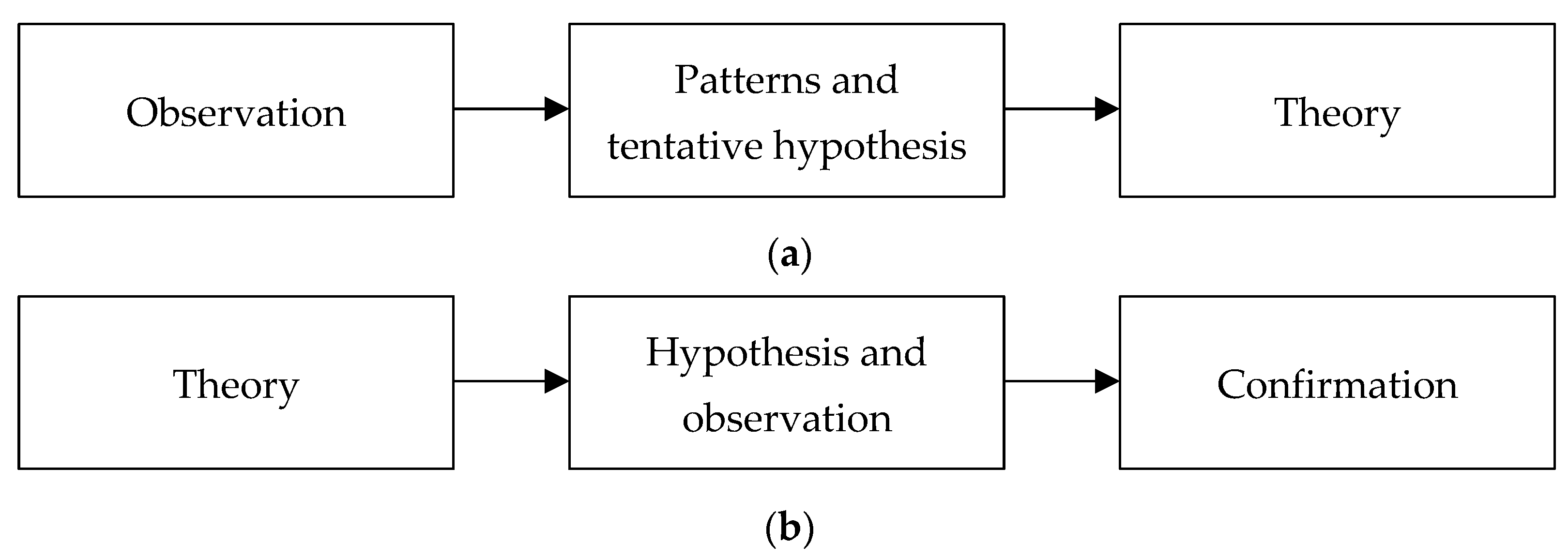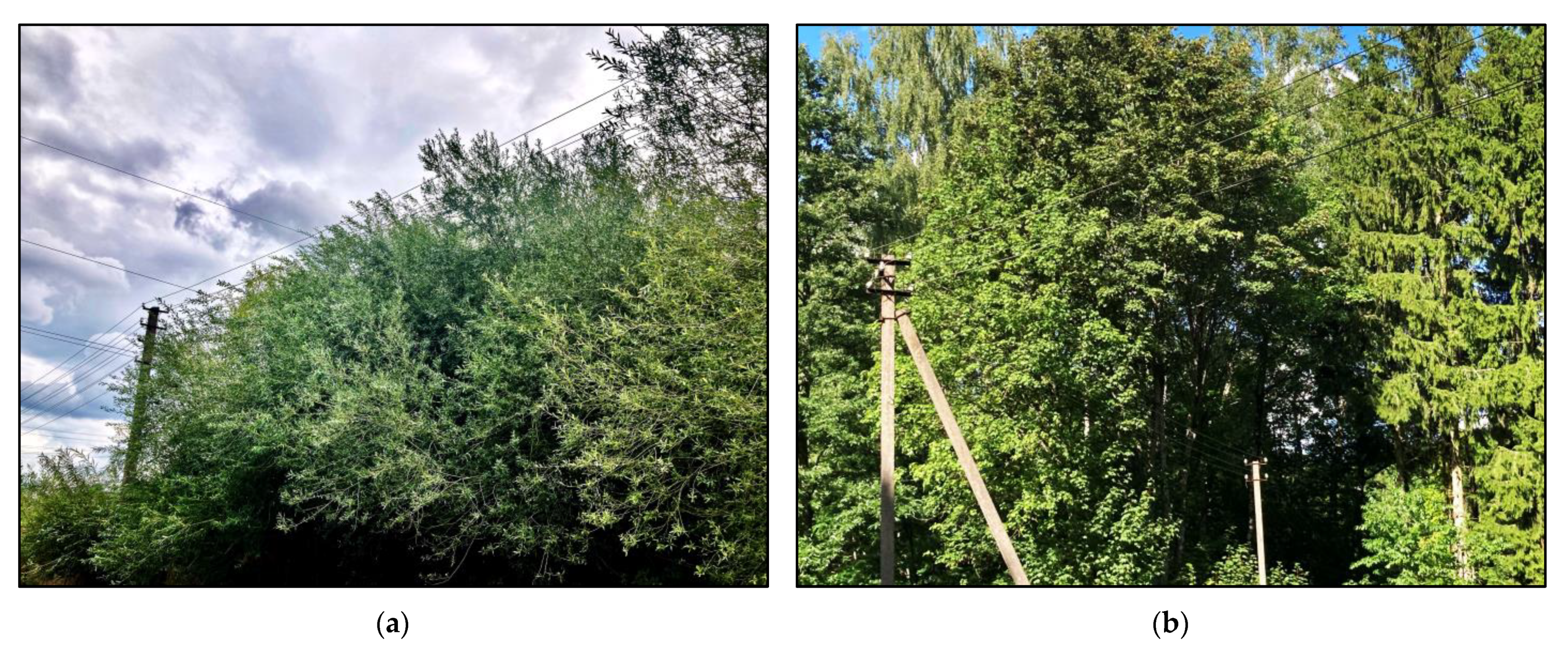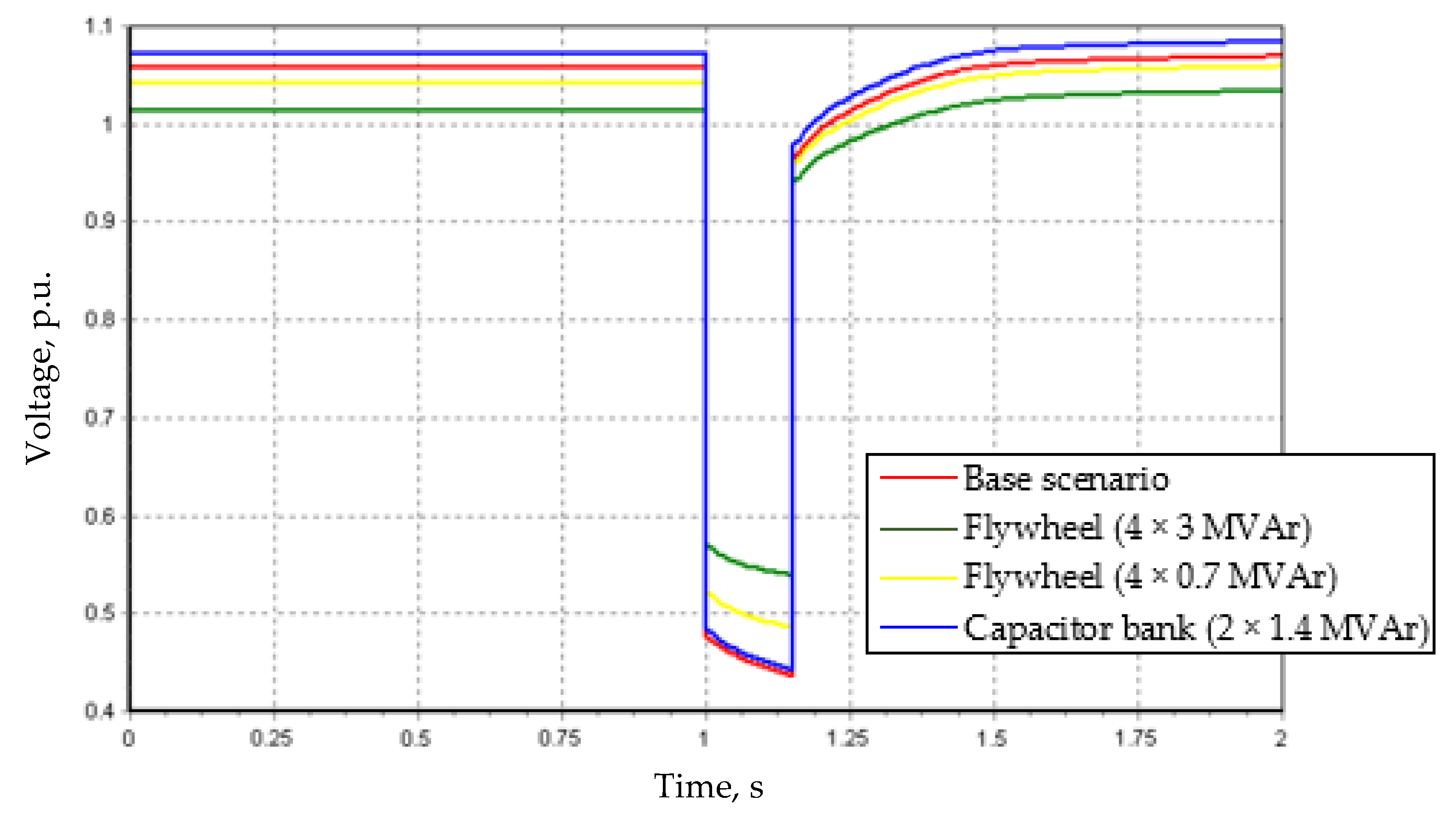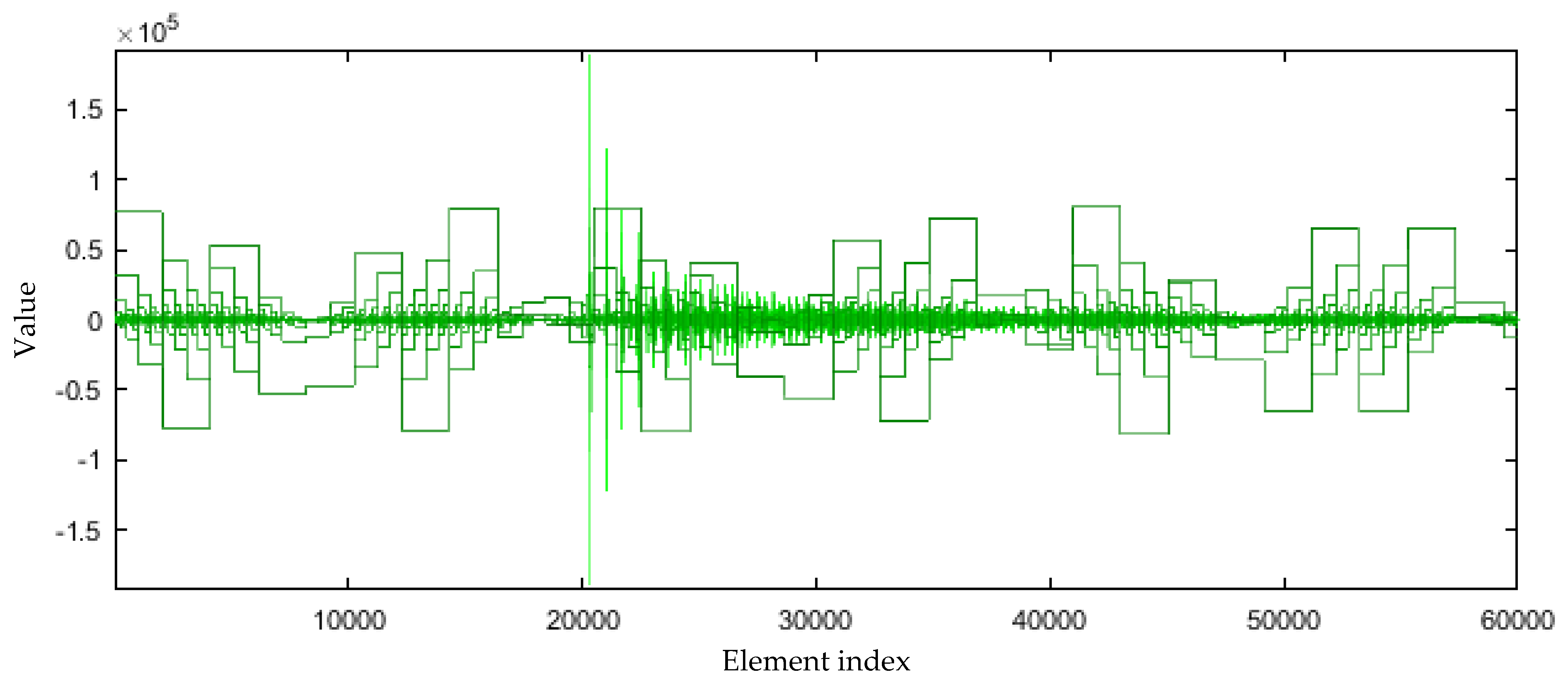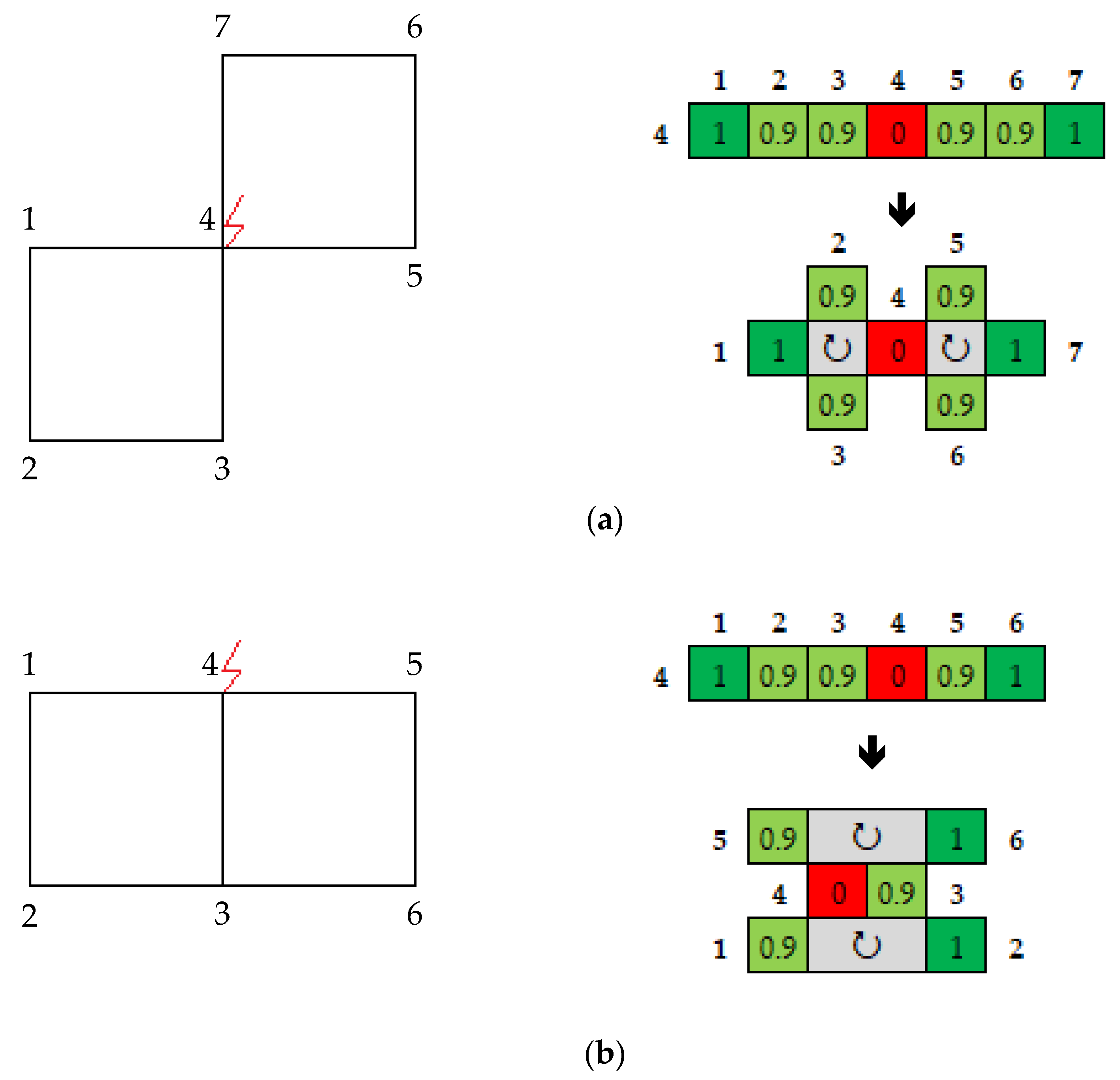Figure 1.
Proposed classification model of the objectives of the related literature.
Figure 1.
Proposed classification model of the objectives of the related literature.
Figure 2.
Proposed interconnection model between power system reliability and power quality.
Figure 2.
Proposed interconnection model between power system reliability and power quality.
Figure 3.
The scheme of the test grid: the chosen fragment of the Lithuanian power system has been slightly (and realistically) expanded for the purposes of this research.
Figure 3.
The scheme of the test grid: the chosen fragment of the Lithuanian power system has been slightly (and realistically) expanded for the purposes of this research.
Figure 4.
The simulation scenarios and measurement nodes: fault locations are marked with red arrows, potential locations of PQ monitors—with brown squares.
Figure 4.
The simulation scenarios and measurement nodes: fault locations are marked with red arrows, potential locations of PQ monitors—with brown squares.
Figure 5.
Pre-fault voltages (p.u.) of the test grid in normal operation mode. During the load-flow study, the loads impedances were constant.
Figure 5.
Pre-fault voltages (p.u.) of the test grid in normal operation mode. During the load-flow study, the loads impedances were constant.
Figure 6.
Scenario No. 2, three-phase fault. (a) Phase-to-phase voltage of M5c; (b) Phase-to-ground-voltage of M5c.
Figure 6.
Scenario No. 2, three-phase fault. (a) Phase-to-phase voltage of M5c; (b) Phase-to-ground-voltage of M5c.
Figure 7.
Scenario No. 2, three-phase fault. (a) Phase-to-phase voltage of M1; (b) Phase-to-ground-voltage of M1.
Figure 7.
Scenario No. 2, three-phase fault. (a) Phase-to-phase voltage of M1; (b) Phase-to-ground-voltage of M1.
Figure 8.
Scenario No. 2, three-phase fault. (a) Phase-to-phase voltage of M2d; (b) Phase-to-ground-voltage of M2d.
Figure 8.
Scenario No. 2, three-phase fault. (a) Phase-to-phase voltage of M2d; (b) Phase-to-ground-voltage of M2d.
Figure 9.
Scenario No. 2, three-phase fault. The dependence between the length of the 330 kV line and the residual voltage of M1.
Figure 9.
Scenario No. 2, three-phase fault. The dependence between the length of the 330 kV line and the residual voltage of M1.
Figure 10.
Scenario No. 2, single-phase fault. The dependence between the length of the 330 kV line and the phase-to-ground residual voltage of the faulted phase of M1.
Figure 10.
Scenario No. 2, single-phase fault. The dependence between the length of the 330 kV line and the phase-to-ground residual voltage of the faulted phase of M1.
Figure 11.
Scenario No. 3, three-phase fault. (a) Phase-to-phase voltage of M2; (b) Phase-to-ground-voltage of M2.
Figure 11.
Scenario No. 3, three-phase fault. (a) Phase-to-phase voltage of M2; (b) Phase-to-ground-voltage of M2.
Figure 12.
Scenario No. 3, three-phase fault. (a) Phase-to-phase voltage of M1; (b) Phase-to-phase-voltage of M4a.
Figure 12.
Scenario No. 3, three-phase fault. (a) Phase-to-phase voltage of M1; (b) Phase-to-phase-voltage of M4a.
Figure 13.
Modification of scenario No. 3, three-phase fault. (a) Phase-to-phase voltage of M2a, when the distance to the fault is 1 km; (b) Phase-to-phase-voltage of M2a, when the distance to the fault is 0.5 km.
Figure 13.
Modification of scenario No. 3, three-phase fault. (a) Phase-to-phase voltage of M2a, when the distance to the fault is 1 km; (b) Phase-to-phase-voltage of M2a, when the distance to the fault is 0.5 km.
Figure 14.
Scenario No. 4, three-phase fault. (a) Phase-to-phase voltage of M3; (b) Phase-to-phase voltage of M2b.
Figure 14.
Scenario No. 4, three-phase fault. (a) Phase-to-phase voltage of M3; (b) Phase-to-phase voltage of M2b.
Figure 15.
Power-flow directions in TSO grid when the both circuit-breakers lockout the rings in the case of the normal mode and the fault mode of Scenario No. 10. During the load flow-study, the loads impedances were constant.
Figure 15.
Power-flow directions in TSO grid when the both circuit-breakers lockout the rings in the case of the normal mode and the fault mode of Scenario No. 10. During the load flow-study, the loads impedances were constant.
Figure 16.
Modifications of Scenario No. 2, three-phase fault. (a) Phase-to-phase voltage of M4, when the circuit-breaker between M3b and M4 is closed; (b) Phase-to-phase voltage of M4a, when both circuit-breakers are closed.
Figure 16.
Modifications of Scenario No. 2, three-phase fault. (a) Phase-to-phase voltage of M4, when the circuit-breaker between M3b and M4 is closed; (b) Phase-to-phase voltage of M4a, when both circuit-breakers are closed.
Figure 17.
Scenario No. 10, three-phase fault. (a) Phase-to-phase voltage of M4, when both circuit-breakers are closed; (b) Phase-to-phase voltage of M4, when the circuit-breaker between M3b and M4 is closed.
Figure 17.
Scenario No. 10, three-phase fault. (a) Phase-to-phase voltage of M4, when both circuit-breakers are closed; (b) Phase-to-phase voltage of M4, when the circuit-breaker between M3b and M4 is closed.
Figure 18.
Scenario No. 5, three-phase fault. (a) Phase-to-phase voltage of M4; (b) Phase-to-ground-voltage of M4.
Figure 18.
Scenario No. 5, three-phase fault. (a) Phase-to-phase voltage of M4; (b) Phase-to-ground-voltage of M4.
Figure 19.
Scenario No. 6, three-phase fault. (a) Phase-to-phase voltage of M5b; (b) Phase-to-ground-voltage of M5b.
Figure 19.
Scenario No. 6, three-phase fault. (a) Phase-to-phase voltage of M5b; (b) Phase-to-ground-voltage of M5b.
Figure 20.
Scenario No. 6, three-phase fault. (a) Phase-to-phase voltage of M5a; (b) Phase-to-ground-voltage of M5a.
Figure 20.
Scenario No. 6, three-phase fault. (a) Phase-to-phase voltage of M5a; (b) Phase-to-ground-voltage of M5a.
Figure 21.
Scenario No. 6, three-phase fault. (a) Phase-to-phase voltage of M5c; (b) Phase-to-ground-voltage of M5c.
Figure 21.
Scenario No. 6, three-phase fault. (a) Phase-to-phase voltage of M5c; (b) Phase-to-ground-voltage of M5c.
Figure 22.
Scenario No. 6, three-phase fault. (a) Phase-to-phase voltage of M4; (b) Phase-to-ground-voltage of M4.
Figure 22.
Scenario No. 6, three-phase fault. (a) Phase-to-phase voltage of M4; (b) Phase-to-ground-voltage of M4.
Figure 23.
Scenario No. 7, three-phase fault. (a) Phase-to-phase voltage of M5; (b) Phase-to-ground-voltage of M5.
Figure 23.
Scenario No. 7, three-phase fault. (a) Phase-to-phase voltage of M5; (b) Phase-to-ground-voltage of M5.
Figure 24.
Scenario No. 8, three-phase fault. (a) Phase-to-phase voltage of M6; (b) Phase-to-phase voltage of M5.
Figure 24.
Scenario No. 8, three-phase fault. (a) Phase-to-phase voltage of M6; (b) Phase-to-phase voltage of M5.
Figure 25.
Scenario No. 8, three-phase fault. (a) Phase-to-phase voltage at the beginning of the 0.4 kV line of M7a; (b) Phase-to-ground-voltage at the beginning of the 0.4 kV line of M7a.
Figure 25.
Scenario No. 8, three-phase fault. (a) Phase-to-phase voltage at the beginning of the 0.4 kV line of M7a; (b) Phase-to-ground-voltage at the beginning of the 0.4 kV line of M7a.
Figure 26.
Scenario No. 9, three-phase fault. (a) Phase-to-ground voltage of M6; (b) Phase-to-ground voltage at the beginning of the 0.4 kV line of M7a.
Figure 26.
Scenario No. 9, three-phase fault. (a) Phase-to-ground voltage of M6; (b) Phase-to-ground voltage at the beginning of the 0.4 kV line of M7a.
Figure 27.
Scenario No. 2, two-phase-to-ground fault. (a) Phase-to-phase voltage of M1; (b) Phase-to-ground voltage of M1.
Figure 27.
Scenario No. 2, two-phase-to-ground fault. (a) Phase-to-phase voltage of M1; (b) Phase-to-ground voltage of M1.
Figure 28.
(a) Scenario No. 7, two-phase-to-ground fault, phase-to-phase voltage of M5; (b) Scenario No. 9, two-phase-to-ground fault, phase-to-phase voltage of M6.
Figure 28.
(a) Scenario No. 7, two-phase-to-ground fault, phase-to-phase voltage of M5; (b) Scenario No. 9, two-phase-to-ground fault, phase-to-phase voltage of M6.
Figure 29.
Scenario No. 4, two-phase-to-ground fault. (a) Phase-to-phase voltage of M3; (b) Phase-to-ground voltage of M3.
Figure 29.
Scenario No. 4, two-phase-to-ground fault. (a) Phase-to-phase voltage of M3; (b) Phase-to-ground voltage of M3.
Figure 30.
Scenario No. 4, two-phase-to-ground fault. (a) Phase-to-phase voltage of M2a; (b) Phase-to-ground voltage of M2a.
Figure 30.
Scenario No. 4, two-phase-to-ground fault. (a) Phase-to-phase voltage of M2a; (b) Phase-to-ground voltage of M2a.
Figure 31.
Scenario No. 4, two-phase-to-ground fault. (a) Symmetrical magnitudes of phase-to-phase voltage of M4; (b) Symmetrical magnitudes of the phase-to-ground voltage of M4; (c) Symmetrical magnitudes of the phase-to-phase voltage of M3; (d) Symmetrical magnitudes of phase-to-ground voltage of M3.
Figure 31.
Scenario No. 4, two-phase-to-ground fault. (a) Symmetrical magnitudes of phase-to-phase voltage of M4; (b) Symmetrical magnitudes of the phase-to-ground voltage of M4; (c) Symmetrical magnitudes of the phase-to-phase voltage of M3; (d) Symmetrical magnitudes of phase-to-ground voltage of M3.
Figure 32.
Three-winding transformer configuration influence on upward voltage patterns (voltage sag depth at M5a and M5c), after the two-phase-to-ground fault at M5 (Scenario No. 6).
Figure 32.
Three-winding transformer configuration influence on upward voltage patterns (voltage sag depth at M5a and M5c), after the two-phase-to-ground fault at M5 (Scenario No. 6).
Figure 33.
Scenario No. 6, two-phase-to-ground fault. (a) Phase-to-phase voltage of M5a; (b) Phase-to-ground voltage of M5a.
Figure 33.
Scenario No. 6, two-phase-to-ground fault. (a) Phase-to-phase voltage of M5a; (b) Phase-to-ground voltage of M5a.
Figure 34.
Scenario No. 6, two-phase-to-ground fault. (a) Phase-to-phase voltage of M5c, when the winding configuration is Y0/Y/Δ-0-11; (b) Phase-to-ground voltage of M5c, when the winding configuration is Y0/Y/Δ-0-11.
Figure 34.
Scenario No. 6, two-phase-to-ground fault. (a) Phase-to-phase voltage of M5c, when the winding configuration is Y0/Y/Δ-0-11; (b) Phase-to-ground voltage of M5c, when the winding configuration is Y0/Y/Δ-0-11.
Figure 35.
Scenario No. 6, two-phase-to-ground fault. (a) Phase-to-phase voltage of M5c, when the winding configuration is Y0/Y/Y-0-0; (b) Phase-to-ground voltage of M5c, when the winding configuration is Y0/Y/Y-0-0.
Figure 35.
Scenario No. 6, two-phase-to-ground fault. (a) Phase-to-phase voltage of M5c, when the winding configuration is Y0/Y/Y-0-0; (b) Phase-to-ground voltage of M5c, when the winding configuration is Y0/Y/Y-0-0.
Figure 36.
(a) Scenario No. 8, two-phase-to-ground fault, phase-to-phase voltage of M6; (b) Scenario No. 9, two-phase-to-ground fault, phase-to-phase voltage at the beginning of the 0.4 kV line of M7a.
Figure 36.
(a) Scenario No. 8, two-phase-to-ground fault, phase-to-phase voltage of M6; (b) Scenario No. 9, two-phase-to-ground fault, phase-to-phase voltage at the beginning of the 0.4 kV line of M7a.
Figure 37.
Scenario No. 1, two-phase-to-ground fault. (a) Phase-to-phase voltage of M5; (b) Phase-to-ground voltage of M5.
Figure 37.
Scenario No. 1, two-phase-to-ground fault. (a) Phase-to-phase voltage of M5; (b) Phase-to-ground voltage of M5.
Figure 38.
Scenario No. 1, two-phase-to-ground fault. (a) Phase-to-phase voltage of M6; (b) Phase-to-ground voltage of M6.
Figure 38.
Scenario No. 1, two-phase-to-ground fault. (a) Phase-to-phase voltage of M6; (b) Phase-to-ground voltage of M6.
Figure 39.
Scenario No. 2, two-phase-to-ground fault. (a) Phase-to-phase voltage of M4; (b) Phase-to-ground voltage of M4.
Figure 39.
Scenario No. 2, two-phase-to-ground fault. (a) Phase-to-phase voltage of M4; (b) Phase-to-ground voltage of M4.
Figure 40.
Scenario No. 1, two-phase fault. (a) Phase-to-phase voltage of M2; (b) Phase-to-ground-voltage of M2.
Figure 40.
Scenario No. 1, two-phase fault. (a) Phase-to-phase voltage of M2; (b) Phase-to-ground-voltage of M2.
Figure 41.
Scenario No. 1, two-phase-to-ground fault. (a) Phase-to-phase voltage of M2; (b) Phase-to-ground voltage of M2.
Figure 41.
Scenario No. 1, two-phase-to-ground fault. (a) Phase-to-phase voltage of M2; (b) Phase-to-ground voltage of M2.
Figure 42.
Scenario No. 2, two-phase fault. (a) Phase-to-phase voltage of M7; (b) Phase-to-ground-voltage of M7.
Figure 42.
Scenario No. 2, two-phase fault. (a) Phase-to-phase voltage of M7; (b) Phase-to-ground-voltage of M7.
Figure 43.
Scenario No. 3, two-phase fault. (a) Phase-to-phase voltage of M5; (b) Phase-to-ground-voltage of M5.
Figure 43.
Scenario No. 3, two-phase fault. (a) Phase-to-phase voltage of M5; (b) Phase-to-ground-voltage of M5.
Figure 44.
Scenario No. 4, two-phase fault. (a) Phase-to-phase voltage of M2; (b) Phase-to-ground-voltage of M2.
Figure 44.
Scenario No. 4, two-phase fault. (a) Phase-to-phase voltage of M2; (b) Phase-to-ground-voltage of M2.
Figure 45.
Scenario No. 6, two-phase fault. (a) Phase-to-phase voltage of M5c; (b) Phase-to-ground-voltage of M5c.
Figure 45.
Scenario No. 6, two-phase fault. (a) Phase-to-phase voltage of M5c; (b) Phase-to-ground-voltage of M5c.
Figure 46.
Scenario No. 7, two-phase fault. (a) Phase-to-phase voltage at the beginning of the 10 kV line of M6; (b) Phase-to-ground-voltage at the beginning of the 10 kV line of M6.
Figure 46.
Scenario No. 7, two-phase fault. (a) Phase-to-phase voltage at the beginning of the 10 kV line of M6; (b) Phase-to-ground-voltage at the beginning of the 10 kV line of M6.
Figure 47.
Scenario No. 7, two-phase fault. (a) Phase-to-phase voltage of M5; (b) Phase-to-ground-voltage of M5.
Figure 47.
Scenario No. 7, two-phase fault. (a) Phase-to-phase voltage of M5; (b) Phase-to-ground-voltage of M5.
Figure 48.
Scenario No. 8, two-phase fault. (a) Phase-to-phase voltage of M7a; (b) Phase-to-ground-voltage of M7a.
Figure 48.
Scenario No. 8, two-phase fault. (a) Phase-to-phase voltage of M7a; (b) Phase-to-ground-voltage of M7a.
Figure 49.
Scenario No. 9, two-phase fault. (a) Phase-to-ground voltage of M6; (b) Phase-to-ground-voltage of M7a.
Figure 49.
Scenario No. 9, two-phase fault. (a) Phase-to-ground voltage of M6; (b) Phase-to-ground-voltage of M7a.
Figure 50.
Scenario No. 1, single-phase fault. (a) Phase-to-phase voltage of M2; (b) Phase-to-ground-voltage of M2.
Figure 50.
Scenario No. 1, single-phase fault. (a) Phase-to-phase voltage of M2; (b) Phase-to-ground-voltage of M2.
Figure 51.
Scenario No. 3, single-phase fault. (a) Phase-to-phase voltage of M2a; (b) Phase-to-ground voltage of M2a.
Figure 51.
Scenario No. 3, single-phase fault. (a) Phase-to-phase voltage of M2a; (b) Phase-to-ground voltage of M2a.
Figure 52.
Scenario No. 6, single-phase fault. (a) Phase-to-phase voltage of M6; (b) Phase-to-ground voltage of M6.
Figure 52.
Scenario No. 6, single-phase fault. (a) Phase-to-phase voltage of M6; (b) Phase-to-ground voltage of M6.
Figure 53.
Scenario No. 4, single-phase fault. (a) Phase-to-phase voltage of M4; (b) Phase-to-ground voltage of M4.
Figure 53.
Scenario No. 4, single-phase fault. (a) Phase-to-phase voltage of M4; (b) Phase-to-ground voltage of M4.
Figure 54.
Scenario No. 4, single-phase fault. (a) Phase-to-phase voltage of M5; (b) Phase-to-ground voltage of M5.
Figure 54.
Scenario No. 4, single-phase fault. (a) Phase-to-phase voltage of M5; (b) Phase-to-ground voltage of M5.
Figure 55.
(a) Scenario No. 8, single-phase fault, phase-to-ground voltage of M7; (b) Scenario No. 9, single-phase fault, phase-to-ground voltage of M7.
Figure 55.
(a) Scenario No. 8, single-phase fault, phase-to-ground voltage of M7; (b) Scenario No. 9, single-phase fault, phase-to-ground voltage of M7.
Figure 56.
Scenario No. 8, single-phase fault. (a) Phase-to-ground voltage of M6; (b) Phase-to-ground voltage of M7a.
Figure 56.
Scenario No. 8, single-phase fault. (a) Phase-to-ground voltage of M6; (b) Phase-to-ground voltage of M7a.
Figure 57.
Scenario No. 4, single-phase fault. (a) Phase-to-phase voltage of M3; (b) Phase-to-ground voltage of M3.
Figure 57.
Scenario No. 4, single-phase fault. (a) Phase-to-phase voltage of M3; (b) Phase-to-ground voltage of M3.
Figure 58.
Scenario No. 4, single-phase fault. (a) Phase-to-phase voltage of M2; (b) Phase-to-ground voltage of M2.
Figure 58.
Scenario No. 4, single-phase fault. (a) Phase-to-phase voltage of M2; (b) Phase-to-ground voltage of M2.
Figure 59.
Scenario No. 4, single-phase fault. (a) Symmetrical magnitudes of the phase-to-phase voltage of M4; (b) Symmetrical magnitudes of the phase-to-ground voltage of M4; (c) symmetrical magnitudes of the phase-to-phase voltage of M3; (d) Symmetrical magnitudes of the phase-to-ground voltage of M3; (e) Symmetrical magnitudes of the phase-to-phase voltage of M2; (f) Symmetrical magnitudes of the phase-to-ground voltage of M2.
Figure 59.
Scenario No. 4, single-phase fault. (a) Symmetrical magnitudes of the phase-to-phase voltage of M4; (b) Symmetrical magnitudes of the phase-to-ground voltage of M4; (c) symmetrical magnitudes of the phase-to-phase voltage of M3; (d) Symmetrical magnitudes of the phase-to-ground voltage of M3; (e) Symmetrical magnitudes of the phase-to-phase voltage of M2; (f) Symmetrical magnitudes of the phase-to-ground voltage of M2.
Figure 60.
Simulation scenarios in the transmission grid of the Baltic power system.
Figure 60.
Simulation scenarios in the transmission grid of the Baltic power system.
Figure 61.
Simulation scenarios in the industrial grid.
Figure 61.
Simulation scenarios in the industrial grid.
Figure 62.
Regression analysis of the Lithuanian 0.4 kV grid, 2015–2018. (a) Interdependence between SAIFI and the fault rate; (b) Interdependence between SAIDI and the fault rate.
Figure 62.
Regression analysis of the Lithuanian 0.4 kV grid, 2015–2018. (a) Interdependence between SAIFI and the fault rate; (b) Interdependence between SAIDI and the fault rate.
Figure 63.
Regression analysis of the Lithuanian 35 kV grid, 2015–2018. (a) Interdependence between SAIFI and the fault rate; (b) Interdependence between SAIDI and the fault rate.
Figure 63.
Regression analysis of the Lithuanian 35 kV grid, 2015–2018. (a) Interdependence between SAIFI and the fault rate; (b) Interdependence between SAIDI and the fault rate.
Figure 64.
Regression analysis of the Lithuanian 10 kV grid, 2015–2018. (a) Interdependence between SAIFI and the fault rate; (b) Interdependence between SAIDI and the fault rate.
Figure 64.
Regression analysis of the Lithuanian 10 kV grid, 2015–2018. (a) Interdependence between SAIFI and the fault rate; (b) Interdependence between SAIDI and the fault rate.
Figure 65.
Regression analysis of the Lithuanian 10 kV overhead lines, 2015–2018. (a) Interdependence between SAIFI and the fault rate; (b) Interdependence between SAIDI and the fault rate.
Figure 65.
Regression analysis of the Lithuanian 10 kV overhead lines, 2015–2018. (a) Interdependence between SAIFI and the fault rate; (b) Interdependence between SAIDI and the fault rate.
Figure 66.
Regression analysis of the Lithuanian 10 kV cable lines, 2015–2018. (a) Interdependence between SAIFI and the fault rate; (b) Interdependence between SAIDI and the fault rate.
Figure 66.
Regression analysis of the Lithuanian 10 kV cable lines, 2015–2018. (a) Interdependence between SAIFI and the fault rate; (b) Interdependence between SAIDI and the fault rate.
Figure 67.
Regression analysis of the Lithuanian 10/0.4 kV substations, 2015–2018. (a) Interdependence between SAIFI and the fault rate; (b) Interdependence between SAIDI and the fault rate.
Figure 67.
Regression analysis of the Lithuanian 10/0.4 kV substations, 2015–2018. (a) Interdependence between SAIFI and the fault rate; (b) Interdependence between SAIDI and the fault rate.
Figure 68.
Regression analysis of the Lithuanian 10/0.4 kV transformers, 2014–2018. (a) Interdependence between SAIFI and the fault rate; (b) Interdependence between SAIDI and the fault rate.
Figure 68.
Regression analysis of the Lithuanian 10/0.4 kV transformers, 2014–2018. (a) Interdependence between SAIFI and the fault rate; (b) Interdependence between SAIDI and the fault rate.
Figure 69.
Probabilistic analysis of the most common primary fault cause frequency in the Lithuanian 10 kV grid. Both Poisson and Gaussian models are given (when confidence level of one-tail is 90%), except cable lines due to unknown sample standard deviation. Please note that all events and their distributions are separate and independent.
Figure 69.
Probabilistic analysis of the most common primary fault cause frequency in the Lithuanian 10 kV grid. Both Poisson and Gaussian models are given (when confidence level of one-tail is 90%), except cable lines due to unknown sample standard deviation. Please note that all events and their distributions are separate and independent.
Figure 70.
Convolutions of the Poisson and Gaussian models. (a) Case of shrub grow-in (overhead power lines); (b) Case of humidity, rain, snow, and dust (outdoor and modular substations). Legend: 1 (blue curve)—autoconvolution function of the Poisson distribution; 2 (blue curve)—autoconvolution function of the Gaussian distribution; red curve—convolution function.
Figure 70.
Convolutions of the Poisson and Gaussian models. (a) Case of shrub grow-in (overhead power lines); (b) Case of humidity, rain, snow, and dust (outdoor and modular substations). Legend: 1 (blue curve)—autoconvolution function of the Poisson distribution; 2 (blue curve)—autoconvolution function of the Gaussian distribution; red curve—convolution function.
Figure 71.
Probabilistic surface of the Lithuanian 10 kV grid faults caused by lightning.
Figure 71.
Probabilistic surface of the Lithuanian 10 kV grid faults caused by lightning.
Figure 72.
Probabilistic surface of transformers, whose voltage of primary winding is either 110 kV or 35 kV, faults and their repair duration.
Figure 72.
Probabilistic surface of transformers, whose voltage of primary winding is either 110 kV or 35 kV, faults and their repair duration.
Figure 73.
(a) Probabilistic surface of power transformers, whose primary winding voltage is either 110 kV or 35 kV, faults through a prism of exploitation age for the first 10 years; (b) Probabilistic surface of sleeves faults through the prism of exploitation age.
Figure 73.
(a) Probabilistic surface of power transformers, whose primary winding voltage is either 110 kV or 35 kV, faults through a prism of exploitation age for the first 10 years; (b) Probabilistic surface of sleeves faults through the prism of exploitation age.
Figure 74.
(a) Inductive reasoning method; (b) Deductive reasoning method.
Figure 74.
(a) Inductive reasoning method; (b) Deductive reasoning method.
Figure 75.
Asymmetrical fault in the Lithuanian 10 kV grid. (a) Available measurements of current; (b) Estimated phase-to-phase voltage: since only two voltages were measured and Axiom 3 does not apply, the estimation of voltage is incorrect.
Figure 75.
Asymmetrical fault in the Lithuanian 10 kV grid. (a) Available measurements of current; (b) Estimated phase-to-phase voltage: since only two voltages were measured and Axiom 3 does not apply, the estimation of voltage is incorrect.
Figure 76.
Typical examples of fauna interference with the public grid in Lithuania. (a) A shrub beneath a 0.4 kV line; (b) A 0.4 kV line in the forested area.
Figure 76.
Typical examples of fauna interference with the public grid in Lithuania. (a) A shrub beneath a 0.4 kV line; (b) A 0.4 kV line in the forested area.
Figure 77.
Voltage sag mitigation efficiency comparison of capacitor bank and flywheel systems on the 10 kV side of a 110/10 kV substation, when the PQ mitigation device is installed on the same 10 kV line at the 10/0.4 kV substation. The voltage sag is caused by a three-phase short-circuit which occurs at the selected farther node of the 110 kV grid.
Figure 77.
Voltage sag mitigation efficiency comparison of capacitor bank and flywheel systems on the 10 kV side of a 110/10 kV substation, when the PQ mitigation device is installed on the same 10 kV line at the 10/0.4 kV substation. The voltage sag is caused by a three-phase short-circuit which occurs at the selected farther node of the 110 kV grid.
Figure 78.
Detail coefficients of multilevel decomposition.
Figure 78.
Detail coefficients of multilevel decomposition.
Figure 79.
Signal details displayed in superimposed mode, where darker colors correspond to the higher levels.
Figure 79.
Signal details displayed in superimposed mode, where darker colors correspond to the higher levels.
Figure 80.
Examples of a voltage sag matrix topological extension, when a three-phase fault occurs at node No. 4. (a) A case when two rings are connected with a mutual node; (b) A case when two rings are connected with a mutual line.
Figure 80.
Examples of a voltage sag matrix topological extension, when a three-phase fault occurs at node No. 4. (a) A case when two rings are connected with a mutual node; (b) A case when two rings are connected with a mutual line.
Table 1.
Three-phase fault voltage sag matrix of the nodes of direct interest.
Table 1.
Three-phase fault voltage sag matrix of the nodes of direct interest.
| Monitor | Pre-Fault | 1 (No. 1) | 2 (No. 2) | 2a (No. 3) | 4 (No. 4) | 5c (No. 5) | 5 (No. 6) | 6 (No. 7) | (No. 8) | 7 (No. 9) |
|---|
| 1 | 0.997 | 0.0 | 1.0 | 1.0 | 1.0 | 1.0 | 1.0 | 1.0 | 1.0 | 1.0 |
| 2 | 0.977 | 0.0 | 0.0 | 0.1 | 0.9 | 1.0 | 1.0 | 1.0 | 1.0 | 1.0 |
| 3 | 1.020 | 0.0 | 0.0 | 0.1 | 0.9 | 1.0 | 1.0 | 1.0 | 1.0 | 1.0 |
| 4 | 0.975 | 0.0 | 0.0 | 0.1 | 0.0 | 0.9 | 1.0 | 1.0 | 1.0 | 1.0 |
| 5 | 0.821 | 0.0 | 0.0 | 0.1 | 0.0 | 0.0 | 0.0 | 0.7 | 0.8 | 0.8 |
| 6 | 0.737 | 0.0 | 0.0 | 0.1 | 0.0 | 0.0 | 0.0 | 0.0 | 0.3 | 0.6 |
| 7 | 0.794 | 0.0 | 0.0 | 0.1 | 0.0 | 0.0 | 0.0 | 0.0 | 0.0 | 0.0 |
Table 2.
Three-phase fault voltage sag matrix of the rest of the nodes.
Table 2.
Three-phase fault voltage sag matrix of the rest of the nodes.
| Monitor | Pre-Fault | 1 (No. 1) | 2 (No. 2) | 2a (No. 3) | 4 (No. 4) | 5c (No. 5) | 5 (No. 6) | 6 (No. 7) | (No. 8) | 7 (No. 9) |
|---|
| 2a | 1.026 | 0.0 | 0.0 | 0.0 | 0.9 | 1.0 | 1.0 | 1.0 | 1.0 | 1.0 |
| 2b | 1.026 | 0.0 | 0.0 | 0.1 | 0.9 | 1.0 | 1.0 | 1.0 | 1.0 | 1.0 |
| 3a | 1.020 | 0.0 | 0.0 | 0.1 | 0.9 | 1.0 | 1.0 | 1.0 | 1.0 | 1.0 |
| 5a | 0.840 | 0.0 | 0.0 | 0.1 | 0.0 | 0.0 | 0.3 | 0.7 | 0.8 | 0.8 |
| 5b | 0.825 | 0.0 | 0.0 | 0.1 | 0.0 | 0.0 | 0.1 | 0.7 | 0.8 | 0.8 |
| 5c | 0.901 | 0.0 | 0.0 | 0.1 | 0.0 | 0.0 | 0.5 | 0.9 | 0.9 | 0.9 |
| 5d | 0.715 | 0.0 | 0.0 | 0.1 | 0.0 | 0.7 | 0.7 | 0.7 | 0.7 | 0.7 |
| 5e | 0.772 | 0.0 | 0.0 | 0.1 | 0.0 | 0.8 | 0.8 | 0.8 | 0.8 | 0.8 |
| 7a | 0.924 | 0.0 | 0.0 | 0.1 | 0.0 | 0.0 | 0.0 | 0.0 | 0.4 | 0.9 |
Table 3.
Three-phase fault voltage sag matrix of the right branch.
Table 3.
Three-phase fault voltage sag matrix of the right branch.
| Monitor | Pre-Fault | 1 (No. 1) | 2 (No. 2) | 2a (No. 3) | 4 (No. 4) | 5c (No. 5) | 5 (No. 6) | 6 (No. 7) | (No. 8) | 7 (No. 9) |
|---|
| 2c | 1.047 | 0.0 | 1.0 | 1.0 | 1.0 | 1.0 | 1.0 | 1.0 | 1.0 | 1.0 |
| 2d | 1.047 | 0.0 | 1.0 | 1.0 | 1.0 | 1.0 | 1.0 | 1.0 | 1.0 | 1.0 |
| 3b | 1.041 | 0.0 | 1.0 | 1.0 | 1.0 | 1.0 | 1.0 | 1.0 | 1.0 | 1.0 |
| 4a | 1.039 | 0.0 | 1.0 | 1.0 | 1.0 | 1.0 | 1.0 | 1.0 | 1.0 | 1.0 |
| 6a | 0.951 | 0.0 | 1.0 | 1.0 | 1.0 | 1.0 | 1.0 | 1.0 | 1.0 | 1.0 |
Table 4.
Two-phase-to-ground fault phase-to-phase voltage sag matrix.
Table 4.
Two-phase-to-ground fault phase-to-phase voltage sag matrix.
| Monitor | Pre-Fault | 1 (No. 1) | 2 (No. 2) | 2a (No. 3) | 4 (No. 4) | 5c (No. 5) | 5 (No. 6) | 6 (No. 7) | (No. 8) | 7 (No. 9) |
|---|
| 1 | 0.997 | 0.0 | 0.5 | 0.5 | 1.0 | 1.0 | 1.0 | 1.0 | 1.0 | 1.0 | 1.0 | 1.0 | 1.0 | 1.0 | 1.0 | 1.0 | 1.0 | 1.0 | 1.0 | 1.0 | 1.0 | 1.0 | 1.0 | 1.0 | 1.0 | 1.0 | 1.0 | 1.0 |
| 2 | 0.977 | 0.0 | 0.5 | 0.5 | 0.0 | 0.7 | 0.7 | 0.4 | 1.0 | 0.6 | 0.9 | 0.9 | 0.9 | 1.0 | 1.0 | 1.0 | 1.0 | 1.0 | 1.0 | 1.0 | 1.0 | 1.0 | 1.0 | 1.0 | 1.0 | 1.0 | 1.0 | 1.0 |
| 2a | 1.026 | 0.3 | 0.3 | 0.6 | 0.4 | 0.4 | 0.8 | 0.0 | 0.9 | 0.9 | 0.9 | 0.9 | 1.0 | 1.0 | 1.0 | 1.0 | 1.0 | 1.0 | 1.0 | 1.0 | 1.0 | 1.0 | 1.0 | 1.0 | 1.0 | 1.0 | 1.0 | 1.0 |
| 3 | 1.020 | 0.0 | 0.5 | 0.5 | 0.0 | 0.7 | 0.7 | 0.4 | 1.0 | 0.6 | 0.9 | 1.0 | 1.0 | 1.0 | 1.0 | 1.0 | 1.0 | 1.0 | 1.0 | 1.0 | 1.0 | 1.0 | 1.0 | 1.0 | 1.0 | 1.0 | 1.0 | 1.0 |
| 4 | 0.975 | 0.0 | 0.5 | 0.5 | 0.0 | 0.7 | 0.7 | 0.4 | 1.0 | 0.6 | 0.0 | 0.7 | 0.7 | 0.9 | 0.9 | 1.0 | 1.0 | 1.0 | 1.0 | 1.0 | 1.0 | 1.0 | 1.0 | 1.0 | 1.0 | 1.0 | 1.0 | 1.0 |
| 5 | 0.821 | 0.0 | 0.4 | 0.4 | 0.0 | 0.6 | 0.6 | 0.3 | 0.8 | 0.5 | 0.0 | 0.6 | 0.6 | 0.4 | 0.4 | 0.8 | 0.0 | 0.7 | 0.7 | 0.8 | 0.8 | 0.8 | 0.8 | 0.8 | 0.8 | 0.8 | 0.8 | 0.8 |
| 5c | 0.901 | 0.3 | 0.5 | 0.3 | 0.4 | 0.7 | 0.4 | 0.7 | 0.8 | 0.1 | 0.4 | 0.8 | 0.4 | 0.0 | 0.7 | 0.7 | 0.6 | 0.9 | 0.7 | 0.9 | 0.9 | 0.9 | 0.9 | 0.9 | 0.9 | 0.9 | 0.9 | 0.9 |
| 6 | 0.737 | 0.2 | 0.4 | 0.2 | 0.3 | 0.6 | 0.3 | 0.6 | 0.7 | 0.1 | 0.3 | 0.6 | 0.3 | 0.0 | 0.6 | 0.6 | 0.4 | 0.7 | 0.4 | 0.0 | 0.6 | 0.6 | 0.3 | 0.7 | 0.6 | 0.6 | 0.7 | 0.7 |
| 7 | 0.794 | 0.2 | 0.5 | 0.2 | 0.3 | 0.7 | 0.3 | 0.6 | 0.7 | 0.1 | 0.0 | 0.6 | 0.6 | 0.0 | 0.7 | 0.7 | 0.4 | 0.8 | 0.4 | 0.0 | 0.7 | 0.7 | 0.0 | 0.7 | 0.7 | 0.0 | 0.7 | 0.7 |
Table 5.
Two-phase-to-ground fault phase-to-ground voltage sag matrix.
Table 5.
Two-phase-to-ground fault phase-to-ground voltage sag matrix.
| Monitor | Pre-Fault | 1 (No. 1) | 2 (No. 2) | 2a (No. 3) | 4 (No. 4) | 5c (No. 5) | 5 (No. 6) | 6 (No. 7) | (No. 8) | 7 (No. 9) |
|---|
| 1 | 0.997 | 0.0 | 0.0 | 0.9 | 1.0 | 1.0 | 1.0 | 1.0 | 1.0 | 1.0 | 1.0 | 1.0 | 1.0 | 1.0 | 1.0 | 1.0 | 1.0 | 1.0 | 1.0 | 1.0 | 1.0 | 1.0 | 1.0 | 1.0 | 1.0 | 1.0 | 1.0 | 1.0 |
| 2 | 0.977 | 0.1 | 0.1 | 0.8 | 0.0 | 0.0 | 1.2 | 0.1 | 0.8 | 0.9 | 0.8 | 0.8 | 1.0 | 1.0 | 1.0 | 1.0 | 1.0 | 1.0 | 1.0 | 1.0 | 1.0 | 1.0 | 1.0 | 1.0 | 1.0 | 1.0 | 1.0 | 1.0 |
| 2a | 1.026 | 0.5 | 0.0 | 0.5 | 0.7 | 0.0 | 0.7 | 0.0 | 0.0 | 1.5 | 1.0 | 0.9 | 1.0 | 1.0 | 1.0 | 1.0 | 1.0 | 1.0 | 1.0 | 1.0 | 1.0 | 1.0 | 1.0 | 1.0 | 1.0 | 1.0 | 1.0 | 1.0 |
| 3 | 1.020 | 0.4 | 0.4 | 1.3 | 0.8 | 0.8 | 2.0 | 0.1 | 0.8 | 0.9 | 0.8 | 0.8 | 1.3 | 1.0 | 1.0 | 1.0 | 1.0 | 1.0 | 1.0 | 1.0 | 1.0 | 1.0 | 1.0 | 1.0 | 1.0 | 1.0 | 1.0 | 1.0 |
| 4 | 0.975 | 0.3 | 0.3 | 1.1 | 0.6 | 0.6 | 1.8 | 0.1 | 0.8 | 0.9 | 0.0 | 0.0 | 1.3 | 0.9 | 0.9 | 1.0 | 1.0 | 1.0 | 1.0 | 1.0 | 1.0 | 1.0 | 1.0 | 1.0 | 1.0 | 1.0 | 1.0 | 1.0 |
| 5 | 0.821 | 0.2 | 0.2 | 0.5 | 0.3 | 0.3 | 0.7 | 0.0 | 0.7 | 0.8 | 0.4 | 0.4 | 0.7 | 0.7 | 0.0 | 0.7 | 0.0 | 0.0 | 1.2 | 0.8 | 0.8 | 0.8 | 0.8 | 0.8 | 0.8 | 0.8 | 0.8 | 0.8 |
| 5c | 0.901 | 0.0 | 0.5 | 0.5 | 0.0 | 0.6 | 0.6 | 0.4 | 0.9 | 0.5 | 0.0 | 0.7 | 0.7 | 0.0 | 0.0 | 1.3 | 0.5 | 0.8 | 0.8 | 0.9 | 0.9 | 0.9 | 0.9 | 0.9 | 0.9 | 0.9 | 0.9 | 0.9 |
| 6 | 0.737 | 0.0 | 0.4 | 0.4 | 0.0 | 0.5 | 0.5 | 0.3 | 0.7 | 0.4 | 0.0 | 0.6 | 0.6 | 0.4 | 0.3 | 0.7 | 0.0 | 0.6 | 0.6 | 0.0 | 0.0 | 1.1 | 0.4 | 0.5 | 0.7 | 0.6 | 0.7 | 0.7 |
| 7 | 0.794 | 0.0 | 0.5 | 0.5 | 0.0 | 0.6 | 0.6 | 0.3 | 0.8 | 0.5 | 0.3 | 0.7 | 0.3 | 0.4 | 0.4 | 0.8 | 0.0 | 0.7 | 0.7 | 0.4 | 0.4 | 0.8 | 0.2 | 0.2 | 1.3 | 0.0 | 0.0 | 1.2 |
Table 6.
Symmetrical components of both voltages of M4 and the rest of the upward monitors, after the two-phase-to-ground fault at M4 (Scenario No. 4).
Table 6.
Symmetrical components of both voltages of M4 and the rest of the upward monitors, after the two-phase-to-ground fault at M4 (Scenario No. 4).
| Monitor | Phase-to-Phase Voltage, kV 1 | Phase-to-Ground Voltage, kV |
|---|
| Initial 2 | U+ | U− | U0 | Initial 2 | U+ | U− | U0 |
|---|
| 2 | 456.1∠28° | 422.4∠27° | 26.2∠−141° | - | 263.3∠−2° | 243.9∠−2° | 15.2∠−111° | 25.9∠−122° |
| 2a | 14.5∠−2° | 13.4∠−2° | 0.8∠−109° | - | 8.4∠−33° | 7.8∠−33° | 0.5∠−79° | - |
| 3 | 158.7∠28° | 146.2∠28° | 9.6∠−146° | - | 91.6∠−2° | 84.4∠−2° | 5.6∠−116° | 26.3∠122° |
| 4 | 151.8∠29° | 66.2∠28° | 66.2∠−151° | - | 87.6∠0° | 38.2∠0° | 38.2∠−121° | 38.2∠119° |
Table 7.
Voltage sag depth dependence on two-phase-to-ground fault location.
Table 7.
Voltage sag depth dependence on two-phase-to-ground fault location.
| Fault Location | Phase-to-Phase Voltage | Phase-to-Ground Voltage |
|---|
| Generator’s busbar | 100% | 50% | 50% | 100% | 100% | 10% |
| HV grid | 100% | 30% | 30% | 100% | 100% | swell |
| MV and LV grid | 100% | 10% | 10% | 100% | 100% | swell |
Table 8.
Two-phase fault phase-to-phase voltage sag matrix.
Table 8.
Two-phase fault phase-to-phase voltage sag matrix.
| Monitor | Pre-Fault | 1 (No. 1) | 2 (No. 2) | 2a (No. 3) | 4 (No. 4) | 5c (No. 5) | 5 (No. 6) | 6 (No. 7) | (No. 8) | 7 (No. 9) |
|---|
| 1 | 0.997 | 0.0 | 0.9 | 0.9 | 1.0 | 1.0 | 1.0 | 1.0 | 1.0 | 1.0 | 1.0 | 1.0 | 1.0 | 1.0 | 1.0 | 1.0 | 1.0 | 1.0 | 1.0 | 1.0 | 1.0 | 1.0 | 1.0 | 1.0 | 1.0 | 1.0 | 1.0 | 1.0 |
| 2 | 0.977 | 0.0 | 0.8 | 0.8 | 0.0 | 0.8 | 0.8 | 0.4 | 1.0 | 0.6 | 0.9 | 0.9 | 1.0 | 1.0 | 1.0 | 1.0 | 1.0 | 1.0 | 1.0 | 1.0 | 1.0 | 1.0 | 1.0 | 1.0 | 1.0 | 1.0 | 1.0 | 1.0 |
| 2a | 1.026 | 0.5 | 0.5 | 1.0 | 0.5 | 0.5 | 1.0 | 0.0 | 0.9 | 0.9 | 0.9 | 0.9 | 1.0 | 1.0 | 1.0 | 1.0 | 1.0 | 1.0 | 1.0 | 1.0 | 1.0 | 1.0 | 1.0 | 1.0 | 1.0 | 1.0 | 1.0 | 1.0 |
| 3 | 1.020 | 0.0 | 0.9 | 0.9 | 0.0 | 0.9 | 0.9 | 0.4 | 1.0 | 0.6 | 0.9 | 1.0 | 1.0 | 1.0 | 1.0 | 1.0 | 1.0 | 1.0 | 1.0 | 1.0 | 1.0 | 1.0 | 1.0 | 1.0 | 1.0 | 1.0 | 1.0 | 1.0 |
| 4 | 0.975 | 0.0 | 0.8 | 0.8 | 0.0 | 0.8 | 0.8 | 0.4 | 1.0 | 0.6 | 0.0 | 0.8 | 0.8 | 0.9 | 0.9 | 1.0 | 0.9 | 1.0 | 1.0 | 1.0 | 1.0 | 1.0 | 1.0 | 1.0 | 1.0 | 1.0 | 1.0 | 1.0 |
| 5 | 0.821 | 0.0 | 0.7 | 0.7 | 0.0 | 0.7 | 0.7 | 0.3 | 0.8 | 0.5 | 0.0 | 0.7 | 0.7 | 0.4 | 0.4 | 0.8 | 0.0 | 0.7 | 0.7 | 0.8 | 0.8 | 0.8 | 0.8 | 0.8 | 0.8 | 0.8 | 0.8 | 0.8 |
| 5c | 0.901 | 0.5 | 0.9 | 0.5 | 0.5 | 0.9 | 0.5 | 0.7 | 0.8 | 0.1 | 0.5 | 0.9 | 0.5 | 0.0 | 0.8 | 0.8 | 0.6 | 0.9 | 0.7 | 0.9 | 0.9 | 0.9 | 0.9 | 0.9 | 0.9 | 0.9 | 0.9 | 0.9 |
| 6 | 0.737 | 0.4 | 0.7 | 0.4 | 0.4 | 0.7 | 0.4 | 0.6 | 0.7 | 0.1 | 0.4 | 0.7 | 0.4 | 0.0 | 0.6 | 0.6 | 0.4 | 0.7 | 0.4 | 0.0 | 0.6 | 0.6 | 0.3 | 0.7 | 0.6 | 0.6 | 0.7 | 0.7 |
| 7 | 0.794 | 0.4 | 0.8 | 0.4 | 0.4 | 0.8 | 0.4 | 0.6 | 0.7 | 0.1 | 0.4 | 0.8 | 0.4 | 0.0 | 0.7 | 0.7 | 0.4 | 0.8 | 0.4 | 0.0 | 0.7 | 0.7 | 0.0 | 0.7 | 0.7 | 0.0 | 0.7 | 0.7 |
Table 9.
Two-phase fault phase-to-ground voltage sag matrix.
Table 9.
Two-phase fault phase-to-ground voltage sag matrix.
| Monitor | Pre-Fault | 1 (No. 1) | 2 (No. 2) | 2a (No. 3) | 4 (No. 4) | 5c (No. 5) | 5 (No. 6) | 6 (No. 7) | (No. 8) | 7 (No. 9) |
|---|
| 1 | 0.997 | 0.5 | 0.5 | 1.0 | 1.0 | 1.0 | 1.0 | 1.0 | 1.0 | 1.0 | 1.0 | 1.0 | 1.0 | 1.0 | 1.0 | 1.0 | 1.0 | 1.0 | 1.0 | 1.0 | 1.0 | 1.0 | 1.0 | 1.0 | 1.0 | 1.0 | 1.0 | 1.0 |
| 2 | 0.977 | 0.5 | 0.5 | 1.0 | 0.5 | 0.5 | 1.0 | 0.1 | 0.8 | 0.9 | 0.8 | 0.8 | 0.9 | 1.0 | 1.0 | 1.0 | 1.0 | 1.0 | 1.0 | 1.0 | 1.0 | 1.0 | 1.0 | 1.0 | 1.0 | 1.0 | 1.0 | 1.0 |
| 2a | 1.026 | 0.9 | 0.0 | 0.9 | 0.9 | 0.0 | 0.9 | 0.5 | 0.5 | 1.0 | 1.0 | 0.9 | 1.0 | 1.0 | 1.0 | 1.0 | 1.0 | 1.0 | 1.0 | 1.0 | 1.0 | 1.0 | 1.0 | 1.0 | 1.0 | 1.0 | 1.0 | 1.0 |
| 3 | 1.020 | 0.5 | 0.5 | 1.0 | 0.5 | 0.5 | 1.0 | 0.1 | 0.8 | 0.9 | 0.9 | 0.9 | 1.0 | 1.0 | 1.0 | 1.0 | 1.0 | 1.0 | 1.0 | 1.0 | 1.0 | 1.0 | 1.0 | 1.0 | 1.0 | 1.0 | 1.0 | 1.0 |
| 4 | 0.975 | 0.5 | 0.5 | 1.0 | 0.5 | 0.5 | 1.0 | 0.1 | 0.8 | 0.9 | 0.5 | 0.5 | 0.9 | 0.9 | 0.9 | 1.0 | 0.9 | 1.0 | 1.0 | 1.0 | 1.0 | 1.0 | 1.0 | 1.0 | 1.0 | 1.0 | 1.0 | 1.0 |
| 5 | 0.821 | 0.4 | 0.4 | 0.8 | 0.4 | 0.4 | 0.8 | 0.1 | 0.7 | 0.8 | 0.4 | 0.4 | 0.8 | 0.7 | 0.0 | 0.7 | 0.4 | 0.4 | 0.8 | 0.8 | 0.8 | 0.8 | 0.8 | 0.8 | 0.8 | 0.8 | 0.8 | 0.8 |
| 5c | 0.901 | 0.0 | 0.8 | 0.8 | 0.0 | 0.8 | 0.8 | 0.4 | 0.9 | 0.5 | 0.0 | 0.8 | 0.8 | 0.5 | 0.5 | 0.9 | 0.5 | 0.8 | 0.8 | 0.9 | 0.9 | 0.9 | 0.9 | 0.9 | 0.9 | 0.9 | 0.9 | 0.9 |
| 6 | 0.737 | 0.0 | 0.6 | 0.6 | 0.0 | 0.6 | 0.6 | 0.3 | 0.7 | 0.4 | 0.0 | 0.6 | 0.6 | 0.4 | 0.4 | 0.7 | 0.0 | 0.6 | 0.6 | 0.4 | 0.4 | 0.7 | 0.4 | 0.5 | 0.7 | 0.6 | 0.7 | 0.7 |
| 7 | 0.794 | 0.0 | 0.7 | 0.7 | 0.0 | 0.7 | 0.7 | 0.3 | 0.8 | 0.5 | 0.0 | 0.7 | 0.7 | 0.4 | 0.4 | 0.8 | 0.0 | 0.7 | 0.7 | 0.4 | 0.4 | 0.8 | 0.4 | 0.4 | 0.8 | 0.4 | 0.4 | 0.8 |
Table 10.
Voltage sag depth dependence on two-phase fault location.
Table 10.
Voltage sag depth dependence on two-phase fault location.
| Fault Location | Phase-to-Phase Voltage | Phase-to-Ground Voltage |
|---|
| Generator’s busbar | 100% | 10% | 10% | 50% | 50% | 0% |
| HV grid | 100% | 20% | 20% | 50% | 50% | ≤10% |
| MV and LV grid | 100% | 10% | 10% | ≤40% | ≤40% | 0% |
Table 11.
Single-phase fault phase-to-phase voltage sag matrix.
Table 11.
Single-phase fault phase-to-phase voltage sag matrix.
| Monitor | Pre-Fault | 1 (No. 1) | 2 (No. 2) | 2a (No. 3) | 4 (No. 4) | 5c (No. 5) | 5 (No. 6) | 6 (No. 7) | (No. 8) | 7 (No. 9) |
|---|
| 1 | 0.997 | 0.6 | 1.0 | 0.6 | 1.0 | 1.0 | 1.0 | 1.0 | 1.0 | 1.0 | 1.0 | 1.0 | 1.0 | 1.0 | 1.0 | 1.0 | 1.0 | 1.0 | 1.0 | 1.0 | 1.0 | 1.0 | 1.0 | 1.0 | 1.0 | 1.0 | 1.0 | 1.0 |
| 2 | 0.977 | 0.5 | 1.0 | 0.5 | 0.7 | 0.9 | 0.7 | 1.0 | 1.0 | 1.0 | 0.9 | 1.0 | 0.9 | 1.0 | 1.0 | 1.0 | 1.0 | 1.0 | 1.0 | 1.0 | 1.0 | 1.0 | 1.0 | 1.0 | 1.0 | 1.0 | 1.0 | 1.0 |
| 2a | 1.026 | 0.3 | 0.9 | 0.9 | 0.5 | 0.9 | 0.9 | 1.0 | 1.0 | 1.0 | 1.0 | 1.0 | 1.0 | 1.0 | 1.0 | 1.0 | 1.0 | 1.0 | 1.0 | 1.0 | 1.0 | 1.0 | 1.0 | 1.0 | 1.0 | 1.0 | 1.0 | 1.0 |
| 3 | 1.020 | 0.6 | 1.0 | 0.6 | 0.7 | 1.0 | 0.7 | 1.0 | 1.0 | 1.0 | 1.0 | 1.0 | 1.0 | 1.0 | 1.0 | 1.0 | 1.0 | 1.0 | 1.0 | 1.0 | 1.0 | 1.0 | 1.0 | 1.0 | 1.0 | 1.0 | 1.0 | 1.0 |
| 4 | 0.975 | 0.5 | 1.0 | 0.5 | 0.7 | 1.0 | 0.7 | 1.0 | 1.0 | 1.0 | 0.8 | 1.0 | 0.7 | 1.0 | 1.0 | 1.0 | 1.0 | 1.0 | 1.0 | 1.0 | 1.0 | 1.0 | 1.0 | 1.0 | 1.0 | 1.0 | 1.0 | 1.0 |
| 5 | 0.821 | 0.4 | 0.8 | 0.5 | 0.6 | 0.8 | 0.5 | 0.8 | 0.8 | 0.8 | 0.6 | 0.8 | 0.6 | 0.7 | 0.9 | 0.9 | 0.8 | 0.8 | 0.8 | 0.8 | 0.8 | 0.8 | 0.8 | 0.8 | 0.8 | 0.8 | 0.8 | 0.8 |
| 5c | 0.901 | 0.8 | 0.8 | 0.2 | 0.8 | 0.8 | 0.5 | 0.9 | 0.9 | 0.9 | 0.9 | 0.8 | 0.6 | 0.7 | 0.9 | 0.9 | 0.9 | 0.9 | 0.9 | 0.9 | 0.9 | 0.9 | 0.9 | 0.9 | 0.9 | 0.9 | 0.9 | 0.9 |
| 6 | 0.737 | 0.6 | 0.6 | 0.2 | 0.7 | 0.7 | 0.4 | 0.7 | 0.7 | 0.7 | 0.7 | 0.7 | 0.5 | 0.6 | 0.7 | 0.7 | 0.7 | 0.7 | 0.7 | 0.7 | 0.7 | 0.7 | 0.7 | 0.7 | 0.7 | 0.7 | 0.7 | 0.7 |
| 7 | 0.794 | 0.7 | 0.7 | 0.2 | 0.7 | 0.7 | 0.4 | 0.8 | 0.8 | 0.8 | 0.8 | 0.7 | 0.5 | 0.6 | 0.8 | 0.8 | 0.8 | 0.8 | 0.8 | 0.8 | 0.8 | 0.8 | 0.8 | 0.8 | 0.8 | 0.8 | 0.8 | 0.8 |
Table 12.
Single-phase fault phase-to-ground voltage sag matrix.
Table 12.
Single-phase fault phase-to-ground voltage sag matrix.
| Monitor | Pre-Fault | 1 (No. 1) | 2 (No. 2) | 2a (No. 3) | 4 (No. 4) | 5c (No. 5) | 5 (No. 6) | 6 (No. 7) | (No. 8) | 7 (No. 9) |
|---|
| 1 | 0.997 | 0.0 | 0.9 | 1.0 | 1.0 | 1.0 | 1.0 | 1.0 | 1.0 | 1.0 | 1.0 | 1.0 | 1.0 | 1.0 | 1.0 | 1.0 | 1.0 | 1.0 | 1.0 | 1.0 | 1.0 | 1.0 | 1.0 | 1.0 | 1.0 | 1.0 | 1.0 | 1.0 |
| 2 | 0.977 | 0.0 | 0.9 | 0.9 | 0.0 | 1.2 | 1.1 | 1.0 | 1.0 | 1.0 | 0.8 | 1.0 | 1.0 | 1.0 | 1.0 | 1.0 | 1.0 | 1.0 | 1.0 | 1.0 | 1.0 | 1.0 | 1.0 | 1.0 | 1.0 | 1.0 | 1.0 | 1.0 |
| 2a | 1.026 | 0.6 | 0.6 | 1.0 | 0.7 | 0.7 | 1.0 | 0.0 | 1.8 | 1.8 | 1.0 | 1.0 | 1.0 | 1.0 | 1.0 | 1.0 | 1.0 | 1.0 | 1.0 | 1.0 | 1.0 | 1.0 | 1.0 | 1.0 | 1.0 | 1.0 | 1.0 | 1.0 |
| 3 | 1.020 | 0.3 | 1.2 | 1.1 | 1.0 | 2.0 | 2.0 | 1.0 | 1.0 | 1.0 | 0.6 | 1.3 | 1.2 | 1.0 | 1.0 | 1.0 | 1.0 | 1.0 | 1.0 | 1.0 | 1.0 | 1.0 | 1.0 | 1.0 | 1.0 | 1.0 | 1.0 | 1.0 |
| 4 | 0.975 | 0.2 | 1.1 | 1.0 | 0.8 | 1.8 | 1.7 | 1.0 | 1.0 | 1.0 | 0.0 | 1.3 | 1.2 | 1.0 | 1.0 | 1.0 | 1.0 | 1.0 | 1.0 | 1.0 | 1.0 | 1.0 | 1.0 | 1.0 | 1.0 | 1.0 | 1.0 | 1.0 |
| 5 | 0.821 | 0.2 | 0.7 | 0.7 | 0.4 | 0.8 | 0.7 | 0.8 | 0.8 | 0.8 | 0.5 | 0.8 | 0.7 | 0.8 | 0.6 | 0.8 | 0.0 | 1.4 | 1.5 | 0.8 | 0.8 | 0.8 | 0.8 | 0.8 | 0.8 | 0.8 | 0.8 | 0.8 |
| 5c | 0.901 | 0.5 | 0.9 | 0.5 | 0.6 | 0.9 | 0.6 | 0.9 | 0.9 | 0.9 | 0.7 | 0.9 | 0.6 | 0.0 | 1.2 | 1.5 | 0.9 | 0.9 | 0.9 | 0.9 | 0.9 | 0.9 | 0.9 | 0.9 | 0.9 | 0.9 | 0.9 | 0.9 |
| 6 | 0.737 | 0.4 | 0.7 | 0.4 | 0.5 | 0.7 | 0.5 | 0.7 | 0.7 | 0.7 | 0.6 | 0.7 | 0.5 | 0.6 | 0.6 | 0.8 | 0.7 | 0.7 | 0.7 | 0.0 | 1.3 | 1.3 | 0.7 | 0.7 | 0.7 | 0.7 | 0.7 | 0.7 |
| 7 | 0.794 | 0.4 | 0.8 | 0.4 | 0.5 | 0.8 | 0.5 | 0.8 | 0.8 | 0.8 | 0.6 | 0.8 | 0.6 | 0.7 | 0.7 | 0.8 | 0.8 | 0.8 | 0.8 | 0.8 | 0.8 | 0.8 | 0.4 | 1.8 | 1.5 | 0.0 | 1.4 | 1.4 |
Table 13.
Voltage sag depth dependence on single-phase fault location.
Table 13.
Voltage sag depth dependence on single-phase fault location.
| Fault Location | Phase-to-Phase Voltage | Phase-to-Ground Voltage |
|---|
| Generator’s busbar | 40% | 0% | 40% | 100% | 10% | 0% |
| HV grid | ≤30% | ≤10% | 30% | 100% | swell | swell |
| MV and LV grid | ≤20% | 0% | 0% | 100% | swell | swell |
Table 14.
Three-phase fault voltage sag matrix of the investigated nodes, 2017.
Table 14.
Three-phase fault voltage sag matrix of the investigated nodes, 2017.
| Fault Location | Pre-Fault | Tartu | Jelgava | Telšiai | Trykšiai |
|---|
| Tartu | 1.08 | 0.00 | 0.88 | 0.92 | 0.91 |
| Jelgava | 1.07 | 0.84 | 0.00 | 0.31 | 0.33 |
| Telšiai | 1.06 | 0.97 | 0.63 | 0.00 | 0.26 |
Table 15.
ACR success (and ratio) in the Lithuanian distribution grid.
Table 15.
ACR success (and ratio) in the Lithuanian distribution grid.
| Voltage | 2015 | 2016 | 2017 | 2018 |
|---|
| 10 kV | 0.9956 (0.391) | 0.9806 (0.394) | 0.9681 (0.374) | 0.9954 (0.378) |
| 35 kV | 0.9912 (0.426) | 0.9567 (0.597) | 0.9900 (0.462) | 0.9890 (0.451) |
Table 16.
Statistics of the primary fault causes in the Lithuanian 10 kV grid, 2015–2018.
Table 16.
Statistics of the primary fault causes in the Lithuanian 10 kV grid, 2015–2018.
| Cause, Event 1 | λ | s | Confidence Interval for Student’s t-Distribution | Confidence Interval for Poisson Distribution | Gaussian and Poisson Models Similarity |
|---|
| α = 0.10 | α = 0.05 | α = 0.10 | α = 0.05 |
|---|
| λL | λU | λL | λU | λL | λU | λL | λU | Δ1 | Δ2 | δ |
|---|
| Overhead power lines |
| Operation of ACR | 1438 | 81 | 1372 | 1504 | 1343 | 1533 | 1376 | 1502 | 1365 | 1514 | 0.238 | 0.485 | 0.7% |
| Tree outside the safety zone 2 | 845 | 226 | 660 | 1030 | 579 | 1111 | 798 | 894 | 789 | 904 | 0.324 | 1.349 | 0.9% |
| Insulator failure | 289 | 36 | 290 | 318 | 247 | 331 | 262 | 319 | 257 | 324 | 0.237 | 0.478 | 1.5% |
| Fauna | 245 | 80 | 179 | 311 | 150 | 339 | 220 | 272 | 215 | 278 | 0.315 | 1.111 | 1.6% |
| Wire comes loose (unfastened) | 243 | 52 | 200 | 286 | 182 | 304 | 218 | 270 | 213 | 276 | 0.292 | 0.818 | 1.6% |
| Tree branch drop | 160 | 7 | 154 | 166 | 152 | 168 | 140 | 182 | 136 | 187 | 0.361 | 0.205 | 2.0% |
| Switchgear failure 3 | 141 | 16 | 128 | 154 | 122 | 160 | 122 | 162 | 119 | 166 | 0.123 | 0.165 | 2.1% |
| Shrub grow-in | 117 | 14 | 106 | 128 | 101 | 133 | 100 | 136 | 97 | 140 | 0.109 | 0.141 | 2.3% |
| Tree inside the safety zone | 95 | 28 | 72 | 118 | 62 | 128 | 80 | 113 | 77 | 116 | 0.278 | 0.707 | 2.6% |
| Conductor gallop | 29 | 7 | 23 | 35 | 21 | 37 | 21 | 40 | 19 | 42 | 0.110 | 0.143 | 4.7% |
| Tower, pole failure | 13 | 7 | 7 | 19 | 5 | 21 | 8 | 21 | 7 | 22 | 0.221 | 0.414 | 7.0% |
| Others | 178 | 23 | 159 | 197 | 151 | 202 | 157 | 202 | 153 | 206 | 0.194 | 0.329 | 1.9% |
| Cable lines |
| Cable line failure 4 | 716 | ? 5 | - | - | - | - | 673 | 762 | 665 | 770 | - | - | - |
| Damage by third parties | 179 | ? 5 | - | - | - | - | 158 | 203 | 154 | 207 | - | - | - |
| Sleeve failure 6 | 109 | ? 5 | - | - | - | - | 92 | 128 | 90 | 131 | - | - | - |
| Damage by contractors | 14 | ? 5 | - | - | - | - | 8 | 22 | 8 | 23 | - | - | - |
| Others 7 | 3 | ? 5 | - | - | - | - | 1 | 8 | 1 | 9 | - | - | - |
| Outdoor and modular substations 8 |
| Humidity, rain, snow, dust 9 | 465 | 168 | 327 | 603 | 267 | 663 | 421 | 493 | 424 | 509 | 0.329 | 1.570 | 2.0% |
| Fauna 10 | 213 | 37 | 183 | 243 | 169 | 257 | 190 | 239 | 185 | 244 | 0.264 | 0.613 | 1.7% |
| LV circuit-breaker, fuse failure | 242 | 28 | 219 | 265 | 209 | 275 | 217 | 269 | 212 | 274 | 0.205 | 0.359 | 1.6% |
| Insulator failure 11 | 206 | 67 | 151 | 261 | 127 | 285 | 183 | 231 | 179 | 236 | 0.311 | 1.052 | 1.1% |
| Poor connection, oxidation | 100 | 14 | 59 | 111 | 84 | 116 | 84 | 118 | 81 | 122 | 0.136 | 0.189 | 2.5% |
| Transformer failure | 82 | 6 | 77 | 87 | 75 | 89 | 68 | 99 | 65 | 102 | 0.238 | 0.159 | 2.8% |
| Lightning arrester failure | 45 | 21 | 28 | 62 | 20 | 70 | 35 | 58 | 33 | 60 | 0.286 | 0.771 | 3.7% |
| MV circuit-breaker, switch failure | 34 | 16 | 21 | 47 | 15 | 53 | 25 | 45 | 24 | 48 | 0.273 | 0.673 | 4.3% |
| Busbar failure | 13 | 4 | 10 | 16 | 8 | 18 | 8 | 21 | 7 | 22 | 0.048 | 0.053 | 7.0% |
| Zero sequence transformer failure | 4 | 1 | 3 | 5 | 3 | 5 | 1 | 9 | 1 | 10 | 0.439 | 0.229 | 12.9% |
| Others | 121 | 15 | 109 | 133 | 103 | 138 | 103 | 141 | 100 | 145 | 0.127 | 0.173 | 2.3% |
| Pole mounted substations 12 |
| Fauna 13 | 84 | 33 | 57 | 111 | 45 | 123 | 70 | 101 | 67 | 104 | 0.297 | 0.874 | 2.8% |
| LV circuit-breaker, fuse failure | 83 | 33 | 56 | 110 | 44 | 122 | 69 | 100 | 66 | 103 | 0.298 | 0.878 | 2.8% |
| Poor connection, oxidation | 37 | 5 | 33 | 41 | 31 | 43 | 28 | 49 | 26 | 51 | 0.104 | 0.086 | 4.2% |
| Lightning arrester failure | 29 | 24 | 9 | 49 | 1 | 57 | 21 | 40 | 19 | 42 | 0.309 | 1.022 | 4.7% |
| Transformer failure | 29 | 18 | 14 | 44 | 8 | 50 | 21 | 40 | 19 | 42 | 0.291 | 0.819 | 4.7% |
| Insulator failure | 15 | 8 | 8 | 22 | 6 | 24 | 9 | 23 | 8 | 25 | 0.459 | 0.232 | 6.6% |
| Others | 23 | 9 | 16 | 30 | 12 | 34 | 16 | 33 | 15 | 35 | 0.214 | 0.389 | 5.3% |
| General issues. Entire grid |
| Lightning | 505 | 1 14 | 504 | 506 | 504 | 506 | 468 | 543 | 462 | 551 | 0.957 | 0.190 | 0.1% |
| Defects removal, repair 15 | 358 | ? | - | - | - | - | - | - | - | - | - | - | - |
| End-user equipment failure | 62 | ? | - | - | - | - | - | - | - | - | - | - | - |
| Burglary, theft 16 | 53 | n/a | - | - | - | - | - | - | - | - | - | - | - |
| Load connection/disconnection 17 | 12 | ? | - | - | - | - | - | - | - | - | - | - | - |
| Generator synchronization 17 | 3 | ? | - | - | - | - | - | - | - | - | - | - | - |
| Others 18 | 500 | n/a | - | - | - | - | - | - | - | - | - | - | - |


